Recommended ITX DIY NAS CPU & Motherboard Combos
In today’s market, NAS motherboards are no longer just basic storage solutions but have evolved to accommodate diverse needs from small businesses to home media enthusiasts. As the demand for flexible and powerful NAS options grows, a wide range of motherboard configurations now offer features like high-speed networking, multiple storage options, and efficient processing power—all in compact, energy-efficient designs. These motherboards come equipped with various CPU options, such as Intel’s i7 and i5 processors or AMD’s Ryzen series, providing choices that balance performance and budget. With additional features like M.2 NVMe slots, multiple SATA ports, and advanced networking options, these NAS solutions are designed to support RAID configurations, streaming, virtualization, and other demanding applications, making them suitable for both professional and enthusiast users. Why ITX Motherboards? Good question! I am focusing this particular article on ITX NAS Motherboards and included CPUs (and in some cases RAM and an OS SSD) to 1) keep costs low, 2) to simplify deployment, and 3) To ensure the use of Mobile SoC style processors in the NAS deployment and lower the power use. If you have more experience, larger power usage in mind and have more time to build – there are some fantastic MATX options out there and if you don’t mind getting some silicon paste under your finger nails – huge flexibility out there! Anyway, on to the guide!
In a rush? Let’s Cut to the chase!
If you’re in a rush and simply want to know about the best CPU and motherboard combo to build your best DIY NAS system, below, you can find direct links to each of these bundles that can be purchased predominantly on AliExpress, but some of these options are also available on retailers such as Amazon and Newegg. If you were going to shop at these retailers anyway, why not use the links below as it will ensure that we act as comparers could earn a small fee from these shops. It allows us to keep doing what we do.
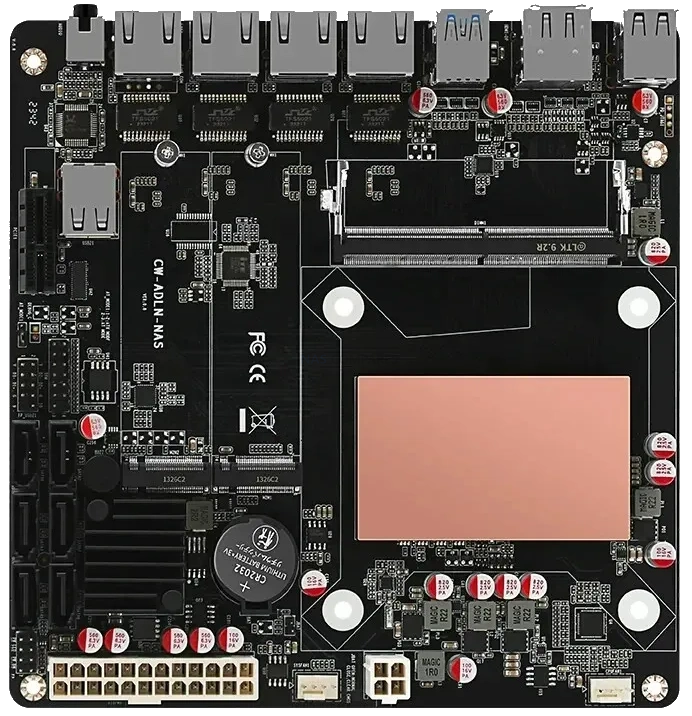
Great M-ITX Mobile/SoC NAS Motherboard+CPU Combos:
Here are ALL the Motherboard+CPU Combos that we cover the previous version of this article HERE:
|
High-Speed i7 1165G7 6-Bay NAS M-ITX Combo Topton Intel Board
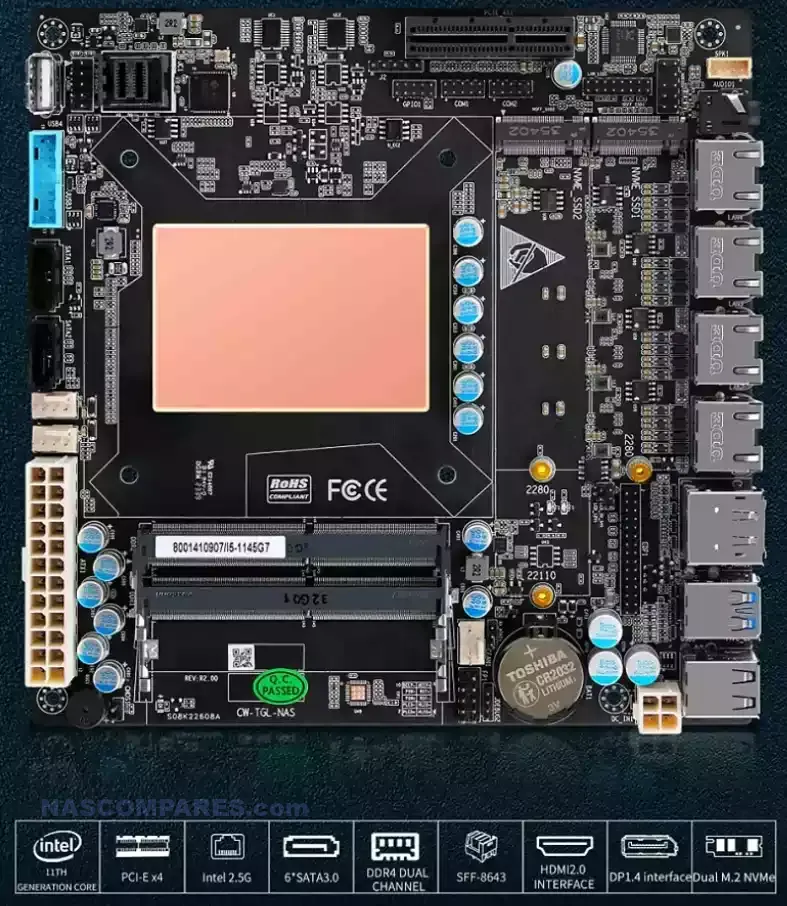
Spec Highlights – Intel i7-1165G7 Processor, Dual M.2 NVMe slots, 6 SATA ports via SFF-8643, 4x 2.5GbE LAN (Intel i226), DDR4 SODIMM Slots x2, PCIe x4 connector, Mini ITX Form Factor – $271.92 (AliExpress)
For those looking at high-speed NAS motherboards that balance performance and storage capacity, the Topton i7 1165G7 6-Bay NAS board is worth considering. It’s part of a growing trend of compact, high-performance boards designed for NAS setups that can handle more than just data storage. This motherboard provides robust support for intensive processing and multitasking within a NAS context, aided by Intel’s 11th Gen i7-1165G7 processor. The processor itself offers 4 cores and 8 threads, running at a base frequency of 2.8 GHz with turbo speeds reaching 4.7 GHz, giving this NAS unit plenty of compute power for media servers, office setups, and moderate virtualization tasks.

With six SATA drive connections via an SFF-8643 interface, this board can support a sizable RAID setup or large data storage configuration, appealing to users with extensive media libraries or business storage needs. Four 2.5GbE Intel i226 LAN ports add a layer of versatility for high-speed data transfer, supporting link aggregation to optimize network throughput. The board also includes two M.2 slots, one of which supports PCIe 4.0, making it compatible with the latest NVMe SSDs. Although not enterprise-grade, it fits well within home or office environments where high-speed access and moderate data processing are needed.
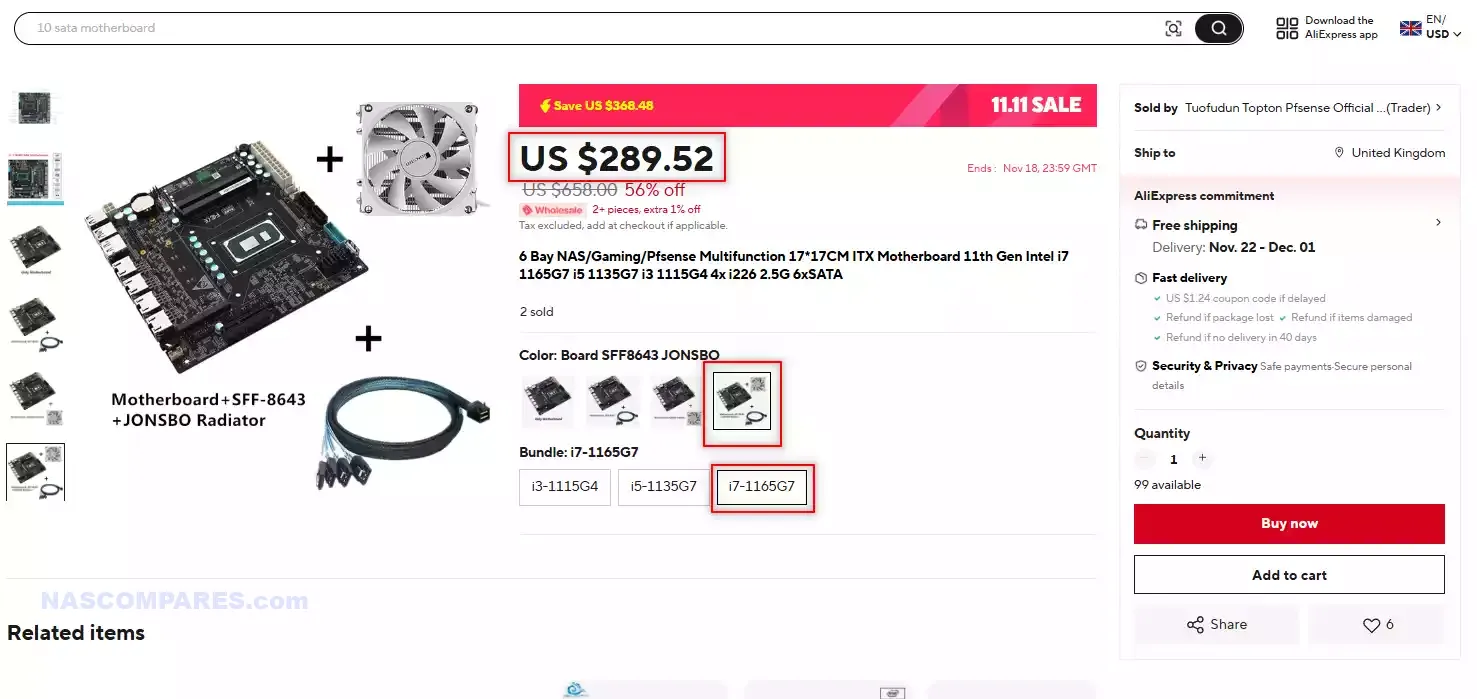
Intel i7 1165G7 NAS CPU+MOBO Combo $289.52 including SATA Fan Out Cable and CPU Cooler HERE
Pros and Cons
| Pros | Cons |
|---|---|
| Supports up to 6 SATA drives via SFF-8643 | Lacks ECC support, not ideal for enterprise use |
| Four 2.5GbE LAN ports for network versatility | No PCIe x16 slot, limiting some expansion options |
| Powerful i7 processor with up to 4.7 GHz turbo | Limited to DDR4 memory, which is slower than DDR5 |
The Topton i3-N305 10G NAS Board
Spec Highlights – Intel i3-N305 Processor, 6 SATA Ports, 2 M.2 NVMe Slots, 10GbE + 2x 2.5GbE LAN, DDR5 Support, Mini ITX, Multiple USB Ports – $257.39 (AliExpress)
YiHESZ’s i3-N305 NAS board presents a solid, economical option for home or small business NAS setups. Built around Intel’s Alder Lake-N i3-N305 processor, this board takes a low-power approach without sacrificing core functionality.
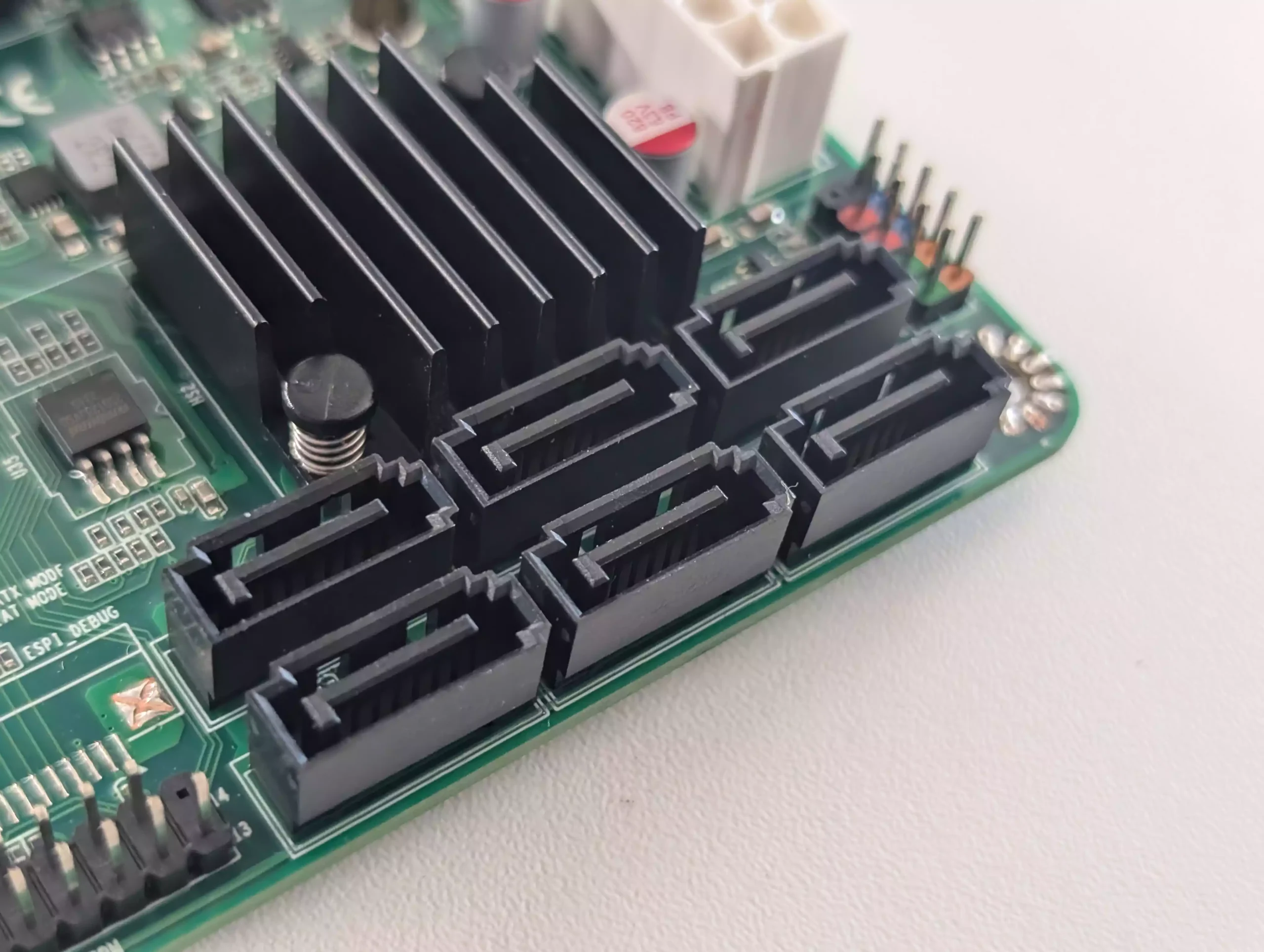
The processor’s 8 cores and a 15W TDP make it an energy-efficient choice for 24/7 operation, keeping heat generation to a minimum, which is often crucial for long-running NAS devices. While it’s not a powerhouse, the i3-N305 can still handle NAS operations smoothly, especially when paired with high-speed network connections.
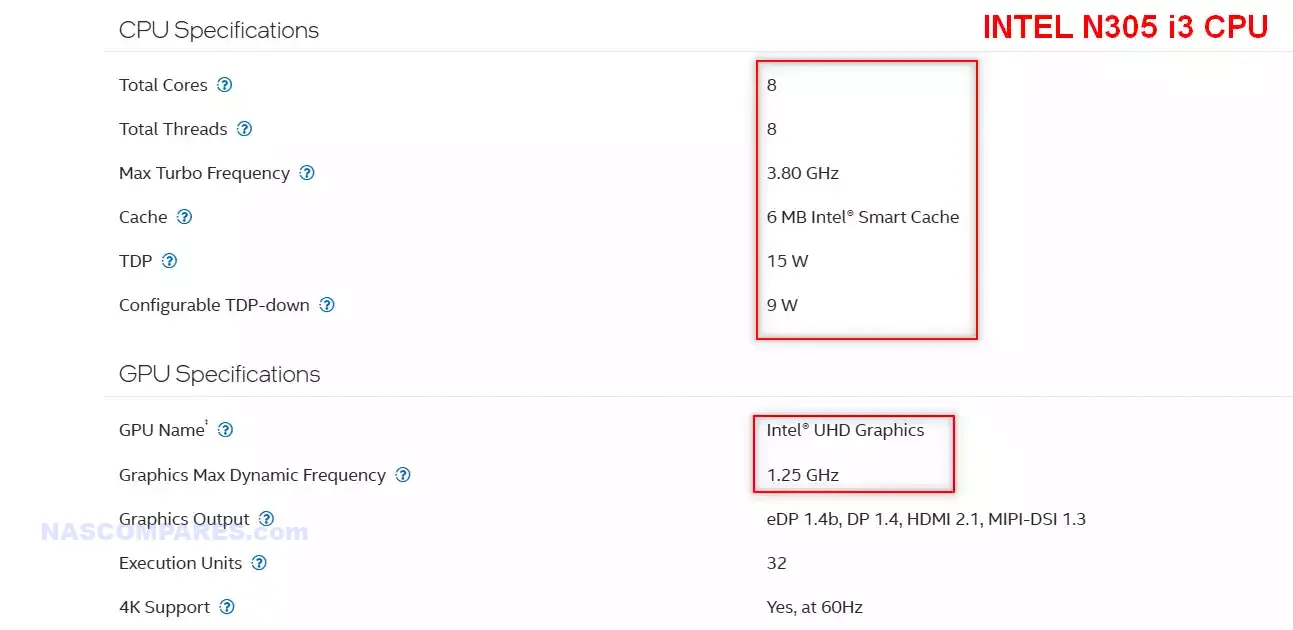
This board’s real appeal lies in its triple-LAN setup, featuring both a 10GbE LAN port and two additional 2.5GbE ports. This setup allows for significant flexibility in network management and, combined with six SATA ports and two M.2 slots, it meets the demands of users who require fast access to large storage arrays.
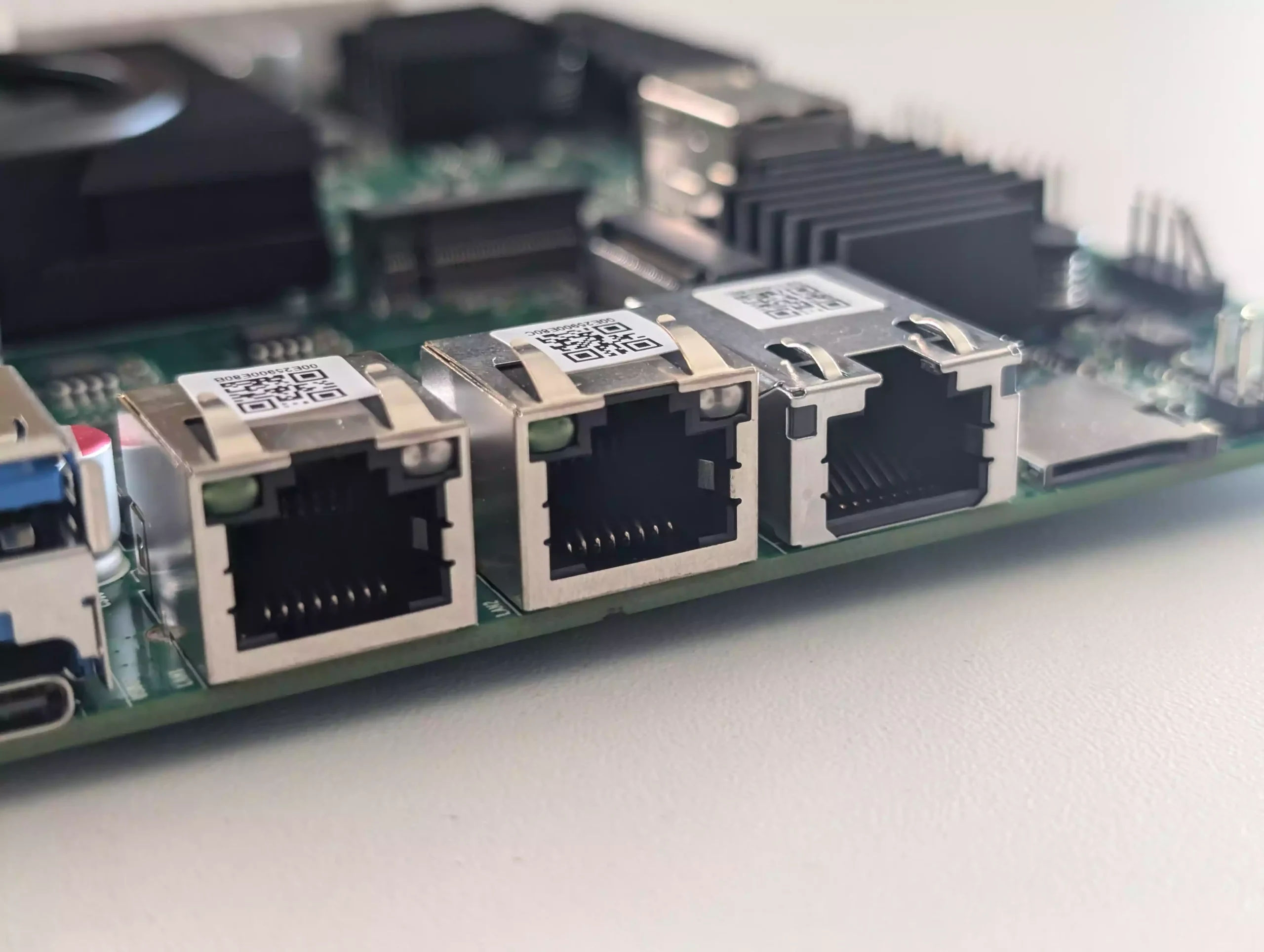
The board supports DDR5 memory, offering improved data bandwidth compared to DDR4, making it well-suited for tasks that require quick read/write capabilities, such as streaming media or handling backups.
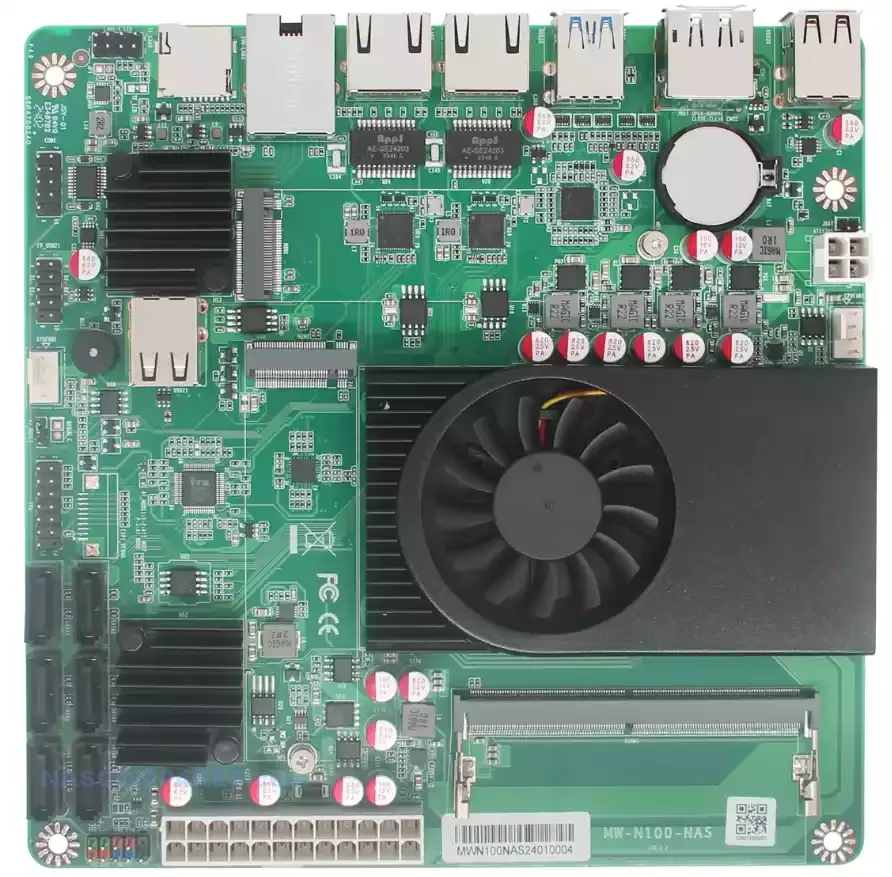
Keep in mind however that this board has spread it’s PCIe lanes pretty thin, so be aware that the M.2 slots are Gen 3×1 and that there is no PCIe slot for traditional upgrades. That said, for a compact 10GbE NAS deployment – you would be hard pushed to find better value right now!
https://s.click.aliexpress.com/e/_DkujwtX
Pros and Cons
| Pros | Cons |
|---|---|
| Triple LAN options including 10GbE | Limited memory capacity (up to 32GB DDR5) |
| 6 SATA ports and 2 M.2 slots for storage | Limited upgrade options due to compact design |
| Low-power CPU with 15W TDP | No ECC memory support, limiting data integrity |
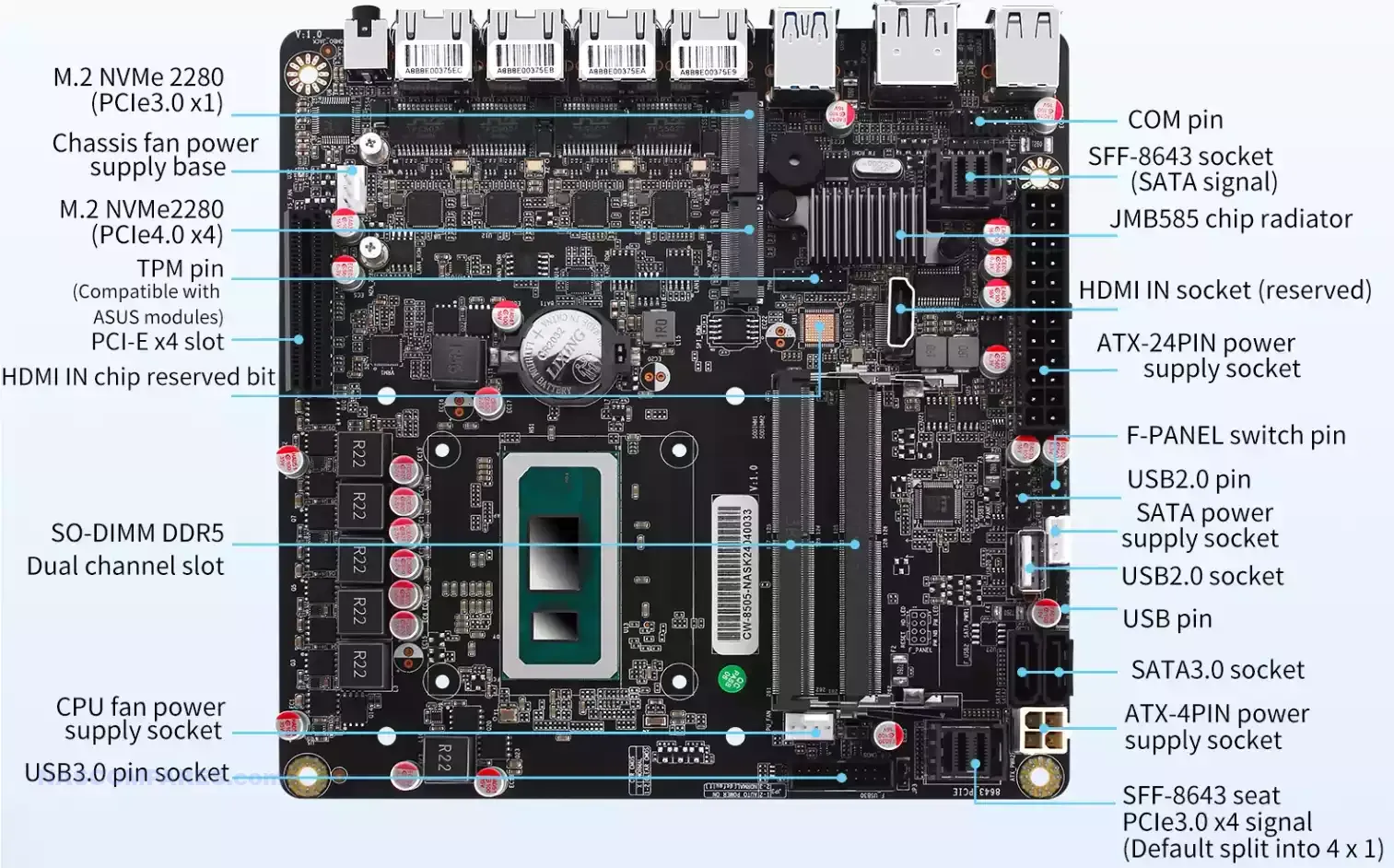
CWWK i5-12450H / Pentium 8505 M-ITX NAS Combo CWWK Board with High Storage Options
Spec Highlights – Intel i5-12450H Processor (or Pentium 8505 Option), 2-6 SATA, 2-6 NVMe (via PCB cards) support, 4x 2.5GbE, Dual M.2 Slots, DDR5 Support, Mini ITX – $289.79 (AliExpress)
The CWWK i5-12450H board is designed with versatility and capacity in mind, offering one of the most flexible storage configurations for its price. At its core, the Intel i5-12450H processor brings an efficient mix of 8 cores (4 performance and 4 efficiency cores) capable of handling moderate multitasking and virtualized environments. With turbo speeds of up to 4.4 GHz, it’s an ideal choice for applications that benefit from occasional bursts of processing power, such as RAID management or media transcoding.
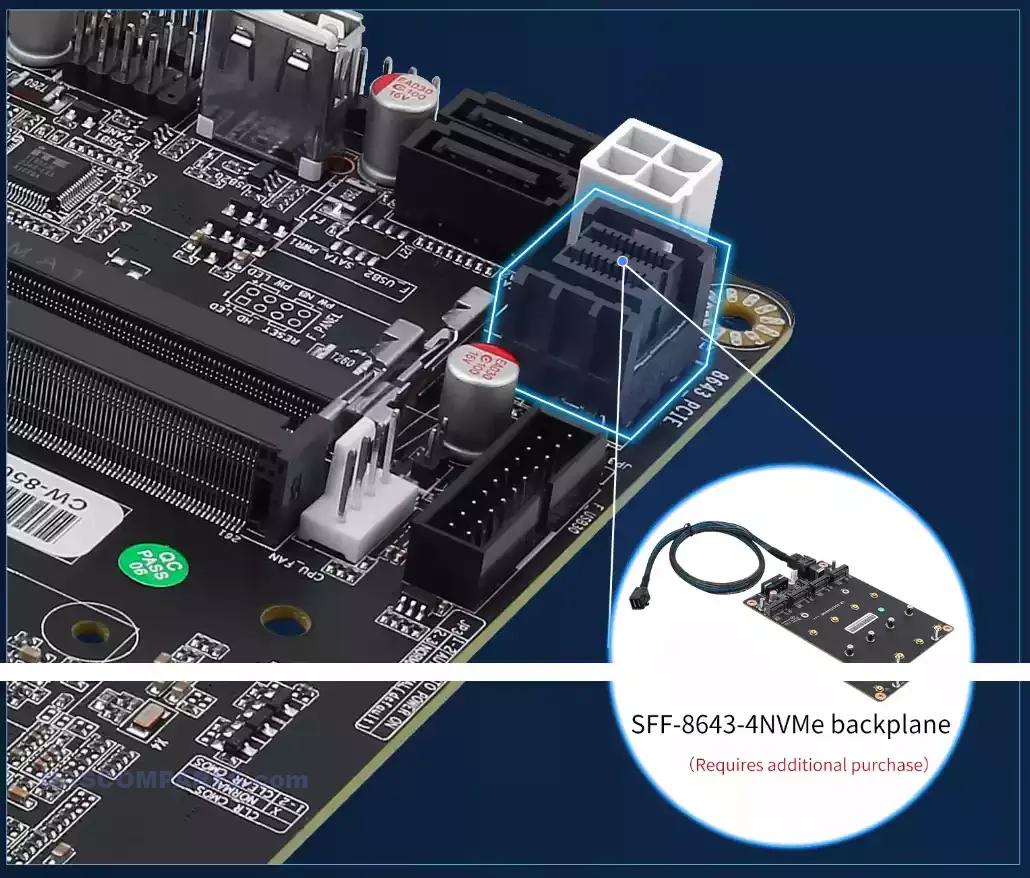
The board’s 2 SATA physical connections (and the ability to add 4x more via an SFF to SATA fan our cable), alongside 2 NVMe slots, and the capacity to add 4x more NVMe slots via an SFF-to-M.2 PCB adapter, present substantial storage possibilities, while its four 2.5GbE LAN ports allow for advanced network configurations and link aggregation.
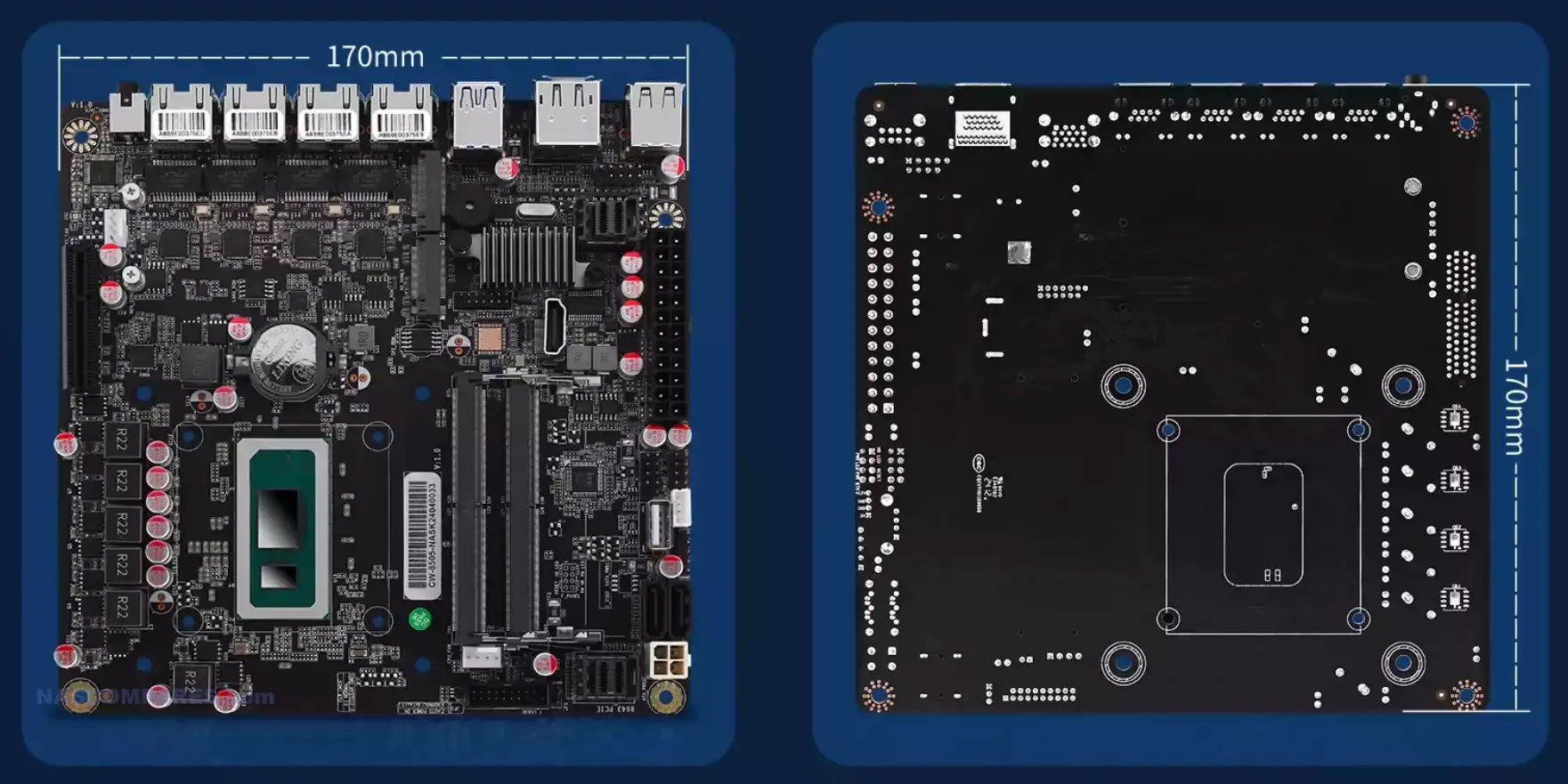
DDR5 memory support further enhances the data handling capabilities, positioning this board as a mid-tier choice for users needing both storage flexibility and respectable processing capacity. However, the lack of ECC support may limit its appeal for users needing strict data integrity.
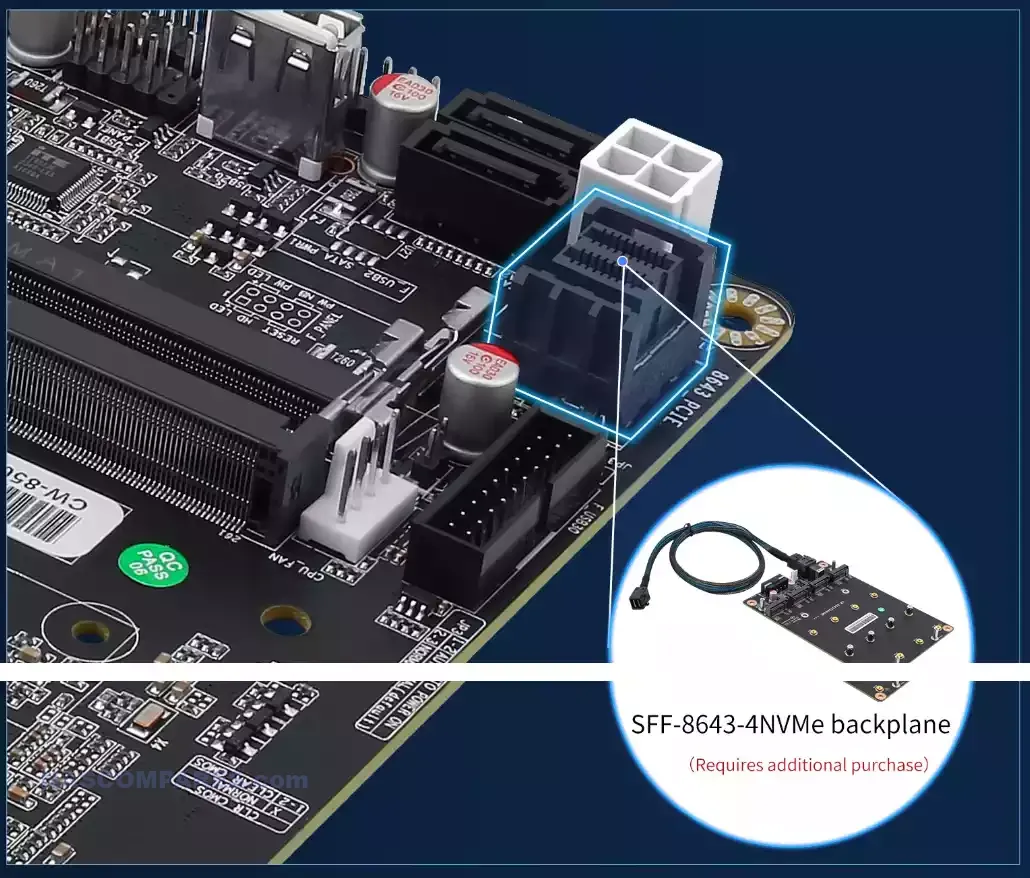
Additionally, the board managed to squeeze in an additional PCIe upgrade slot. Though it is only x4 speed, it IS a Gen 4×4 PCIe slot, so that still manages to afford 8GB/s bandwidth to a connected Gen4 card and is precut, so you do not need to be concerned with x8 and x16 cards not fitting. It is true that a lot of this Mobo+CPU combo’s expandability is locked behind the use of SFF to PCB Card adapters, but that also means there is room for a decent amount of customization, as well as flexibility in cost over time.
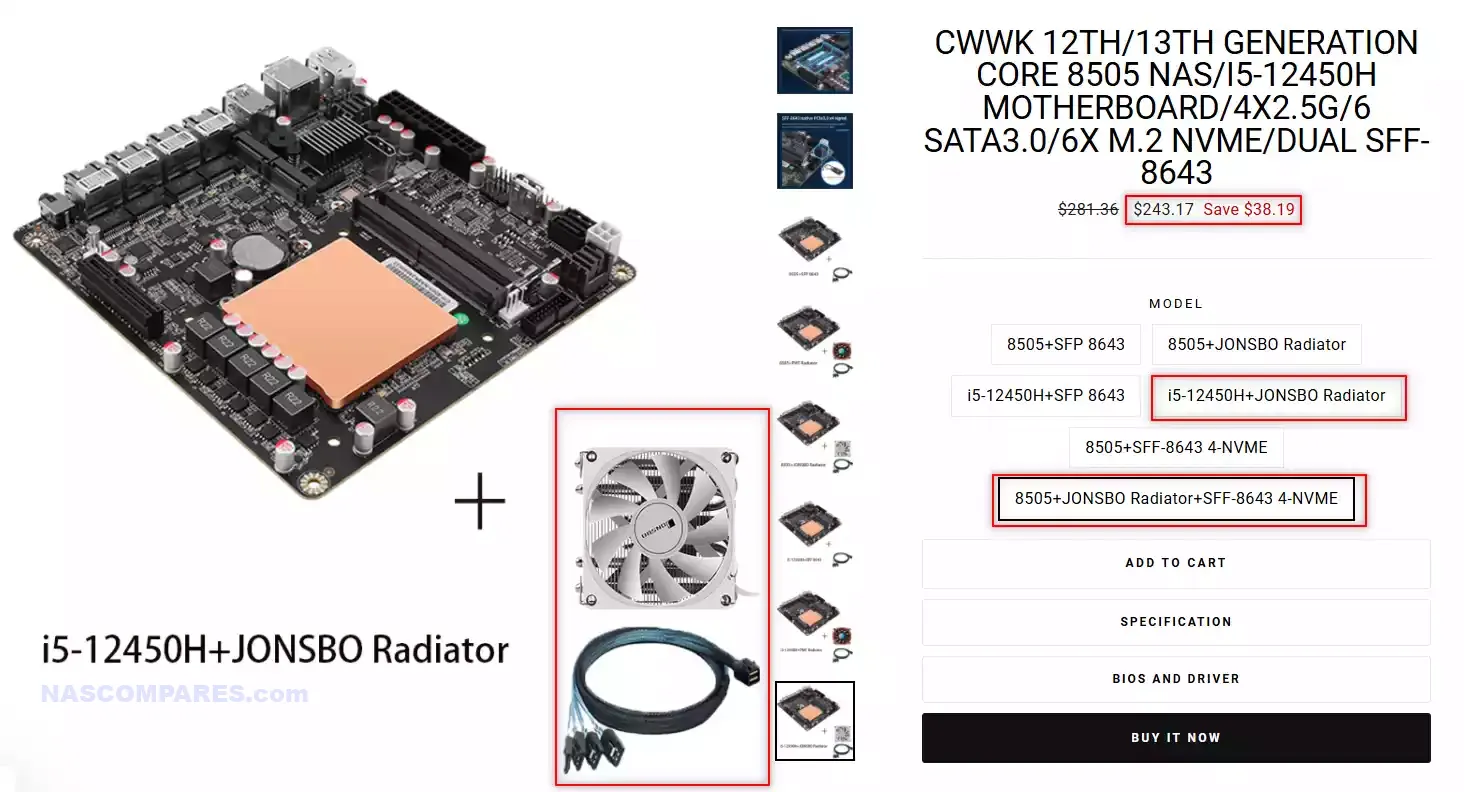
CWWK i5-12450H / Pentium 8505 6-Bay NAS Motherboard Max 2-6xNVMe 2-6xSATA $289 HERE
Pros and Cons
| Pros | Cons |
|---|---|
| Supports six NVMe and six SATA drives | Lacks ECC memory compatibility for data protection |
| Powerful processor for multitasking | Higher power consumption with i5 processor |
| Four 2.5GbE LAN for advanced networking setups | Limited expandability with Mini ITX form factor |
Atom C3758R 10GbE-Ready NAS Board Qotom Industrial Solution
Spec Highlights – Intel Atom C3758R Processor, 8 Cores, ECC RAM Support, 4x 10GbE SFP+ Ports, 5x 2.5GbE, Dual M.2 Slots, SATA 3.0, Mini ITX – $305.00 (AliExpress)
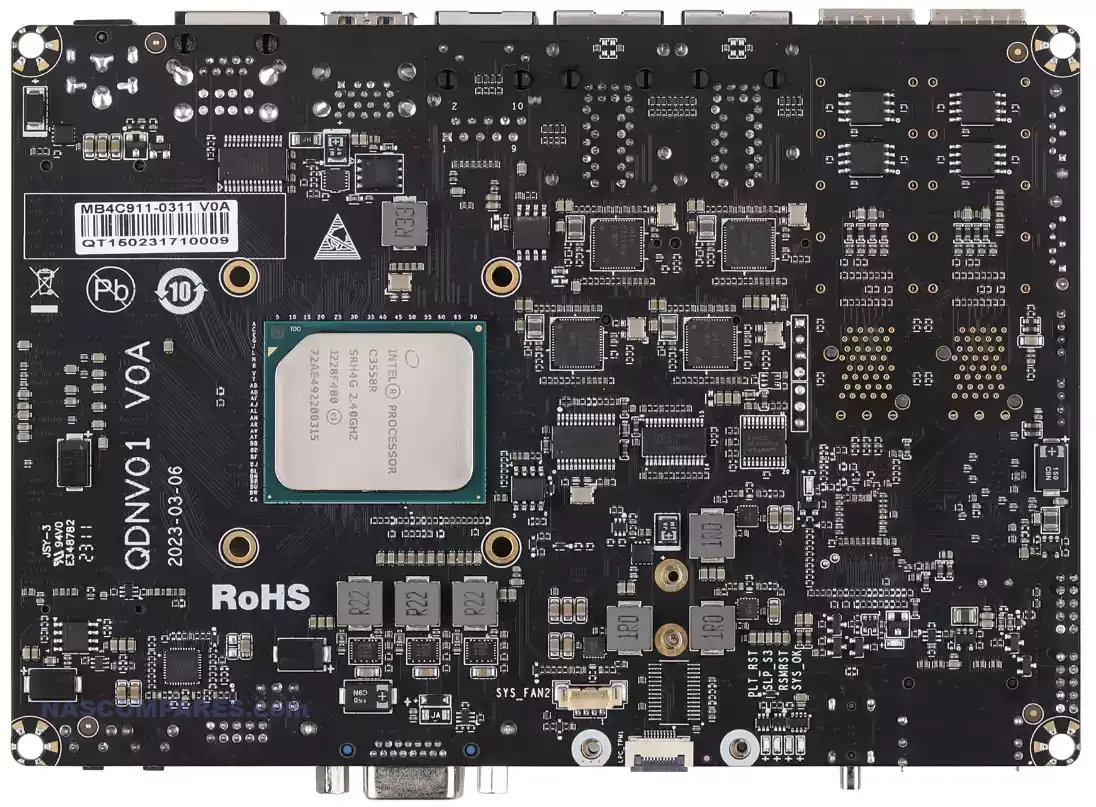
Qotom’s Atom C3758R board is built with reliability in mind, tailored for users who require data integrity and network robustness over raw processing power. The Intel Atom C3758R is an 8-core processor optimized for lower power consumption and equipped with ECC memory support, making it a dependable choice for small enterprise NAS solutions.
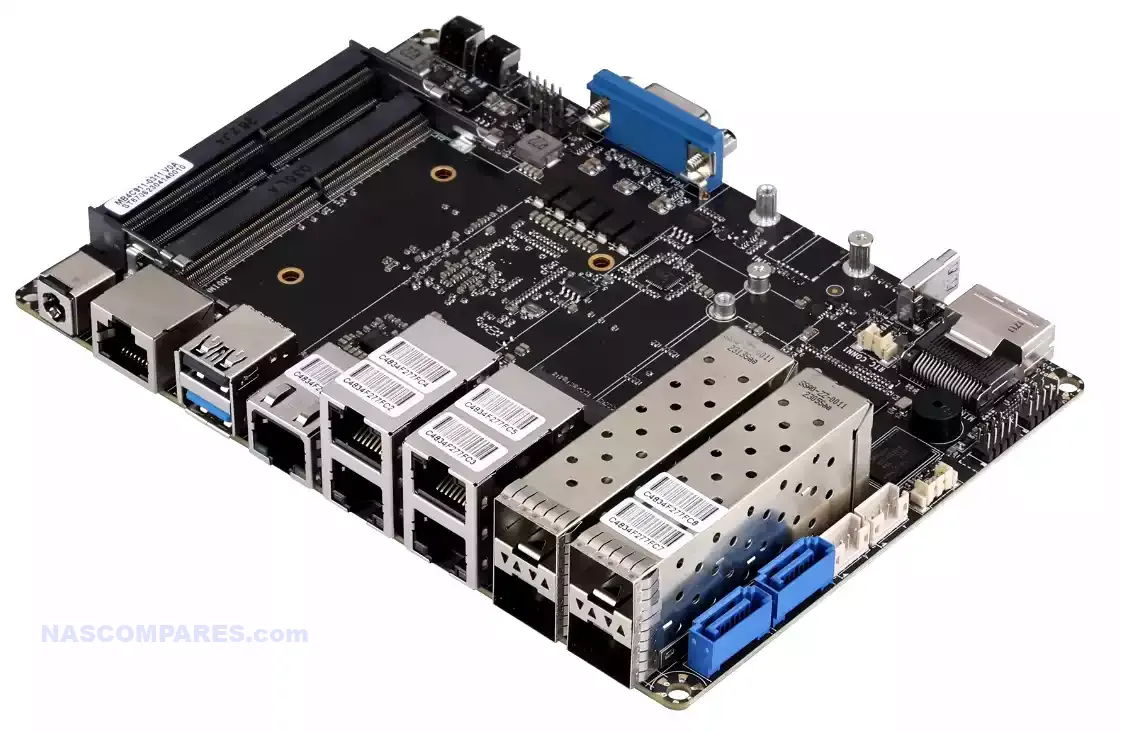
This is one of the few boards that include 4x 10GbE SFP+ ports and 5x 2.5GbE LAN ports, allowing for high-speed networking setups that can support multiple users and intensive data transfer requirements.
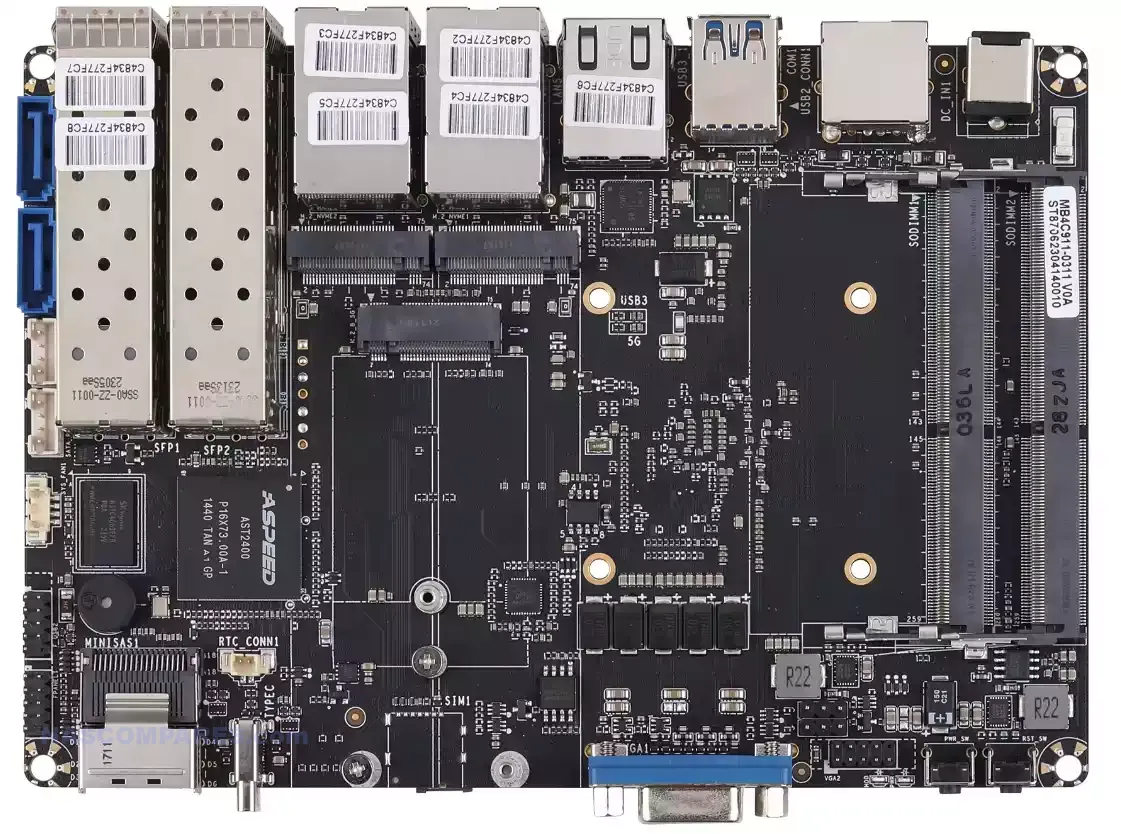
The board’s feature set is rounded out by its two M.2 slots for SSDs and SATA support, enabling it to support a range of storage configurations. Given the ECC support and industrial design, this board is ideal for situations where data reliability is critical, such as archival storage, backups, or as a part of a small business server.
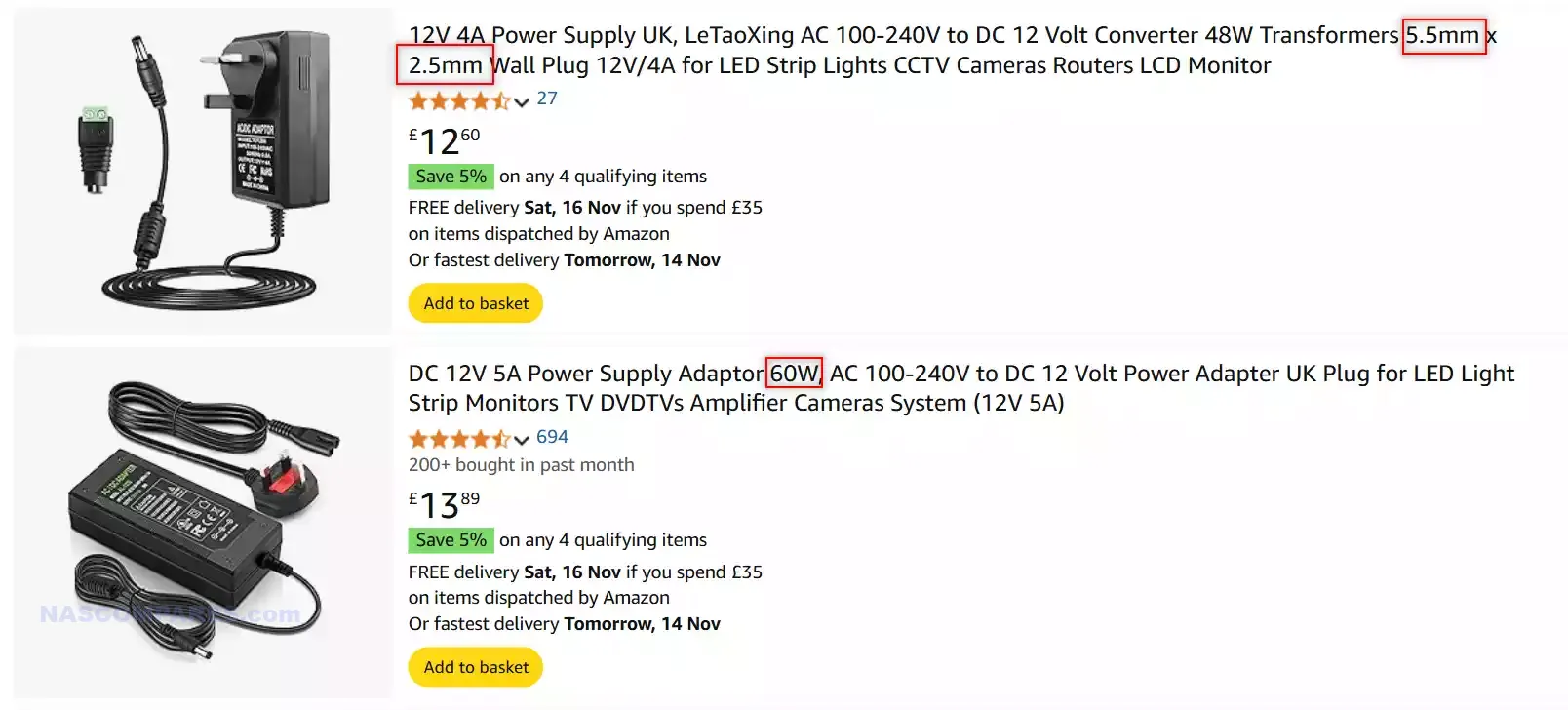
Remember! You will need to buy an external PSU! Also, though this Mobo and CPU combo is arguably more focused towards a DIY/BYO Router/network gateway device, the flexibility in network connectivity, 2 CPU choices, large memory support and mixed SATA/M/2 support all add up to the potential for a high bandwidth, small scale NAS!
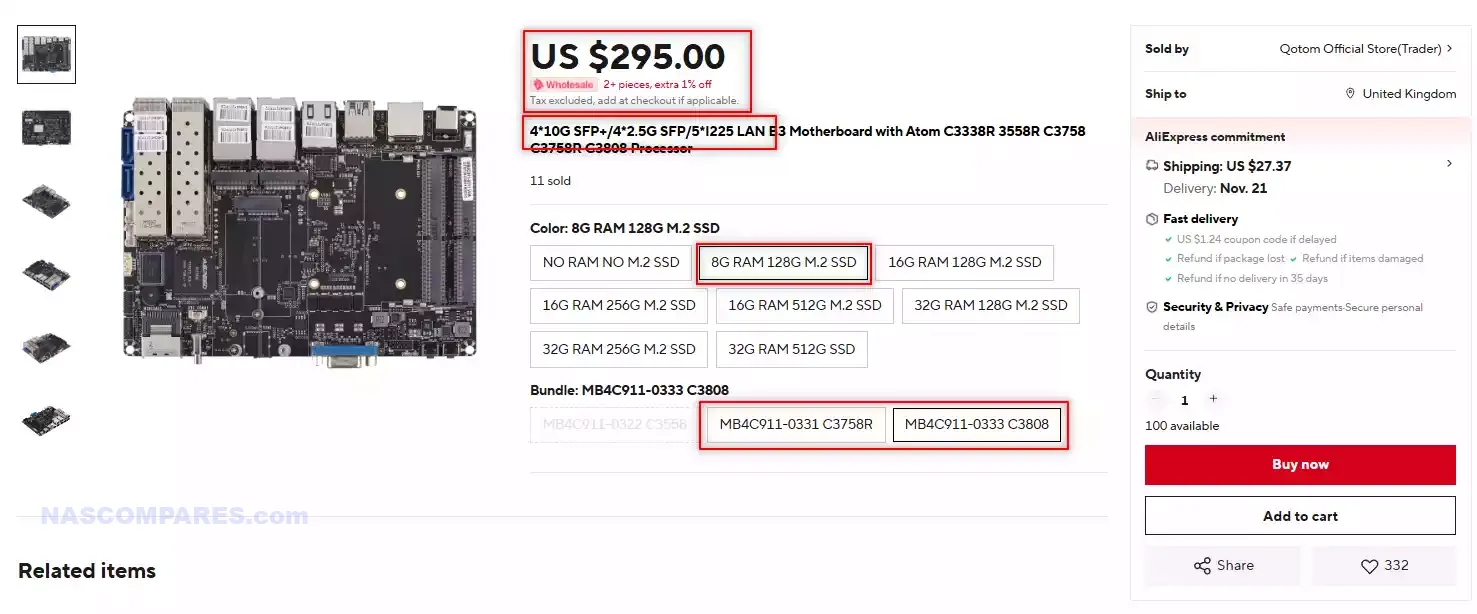
Intel Atom 4x10G SFP+ and 4x 2.5G SFP and 5x 1GbE Micro ITX NAS $295 HERE
Pros and Cons
| Pros | Cons |
|---|---|
| ECC memory support for data reliability | Limited PCIe expandability |
| High-speed network with 4x 10GbE and 5x 2.5GbE | More expensive than typical consumer NAS boards |
| Energy-efficient processor | Limited to Atom’s performance capabilities |
AMD Ryzen 5825U NAS ITX Board – High-Efficiency NAS for Home and Office
Spec Highlights – AMD Ryzen R7 5825U, 8 Cores/16 Threads, Dual M.2 NVMe Slots, 2x 2.5GbE LAN, 2-6 SATA, DDR4 Memory, Mini ITX – $184.80 (AliExpress)
The AMD Ryzen R7 5825U NAS motherboard offers a well-balanced configuration for those seeking a reliable home or small-office NAS. With its 8-core, 16-thread processor, this board is capable of handling moderate workloads and light transcoding tasks, making it an effective choice for media streaming or small business environments. AMD’s Ryzen processor is particularly suitable for multitasking, with a turbo speed of up to 4.5 GHz, providing flexibility for various NAS tasks.
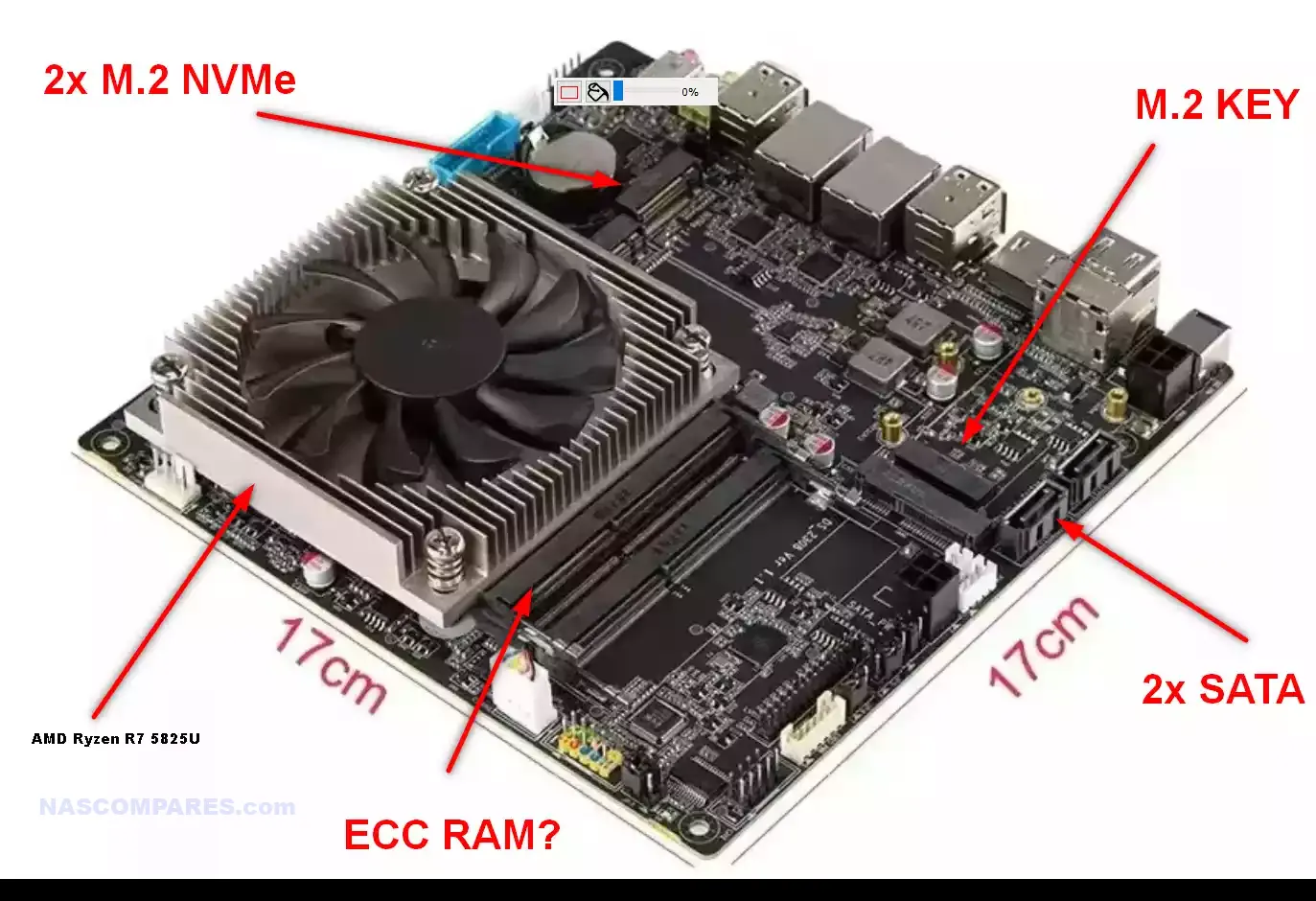
With dual 2.5GbE LAN ports and six SATA connections, users can configure a RAID array for storage redundancy, and the board’s two M.2 slots add support for NVMe SSDs. Although the board doesn’t support ECC memory, its DDR4 capability and integrated Radeon Vega 8 graphics make it a competitive option for multimedia usage or small-scale file storage without the need for heavy data protection.
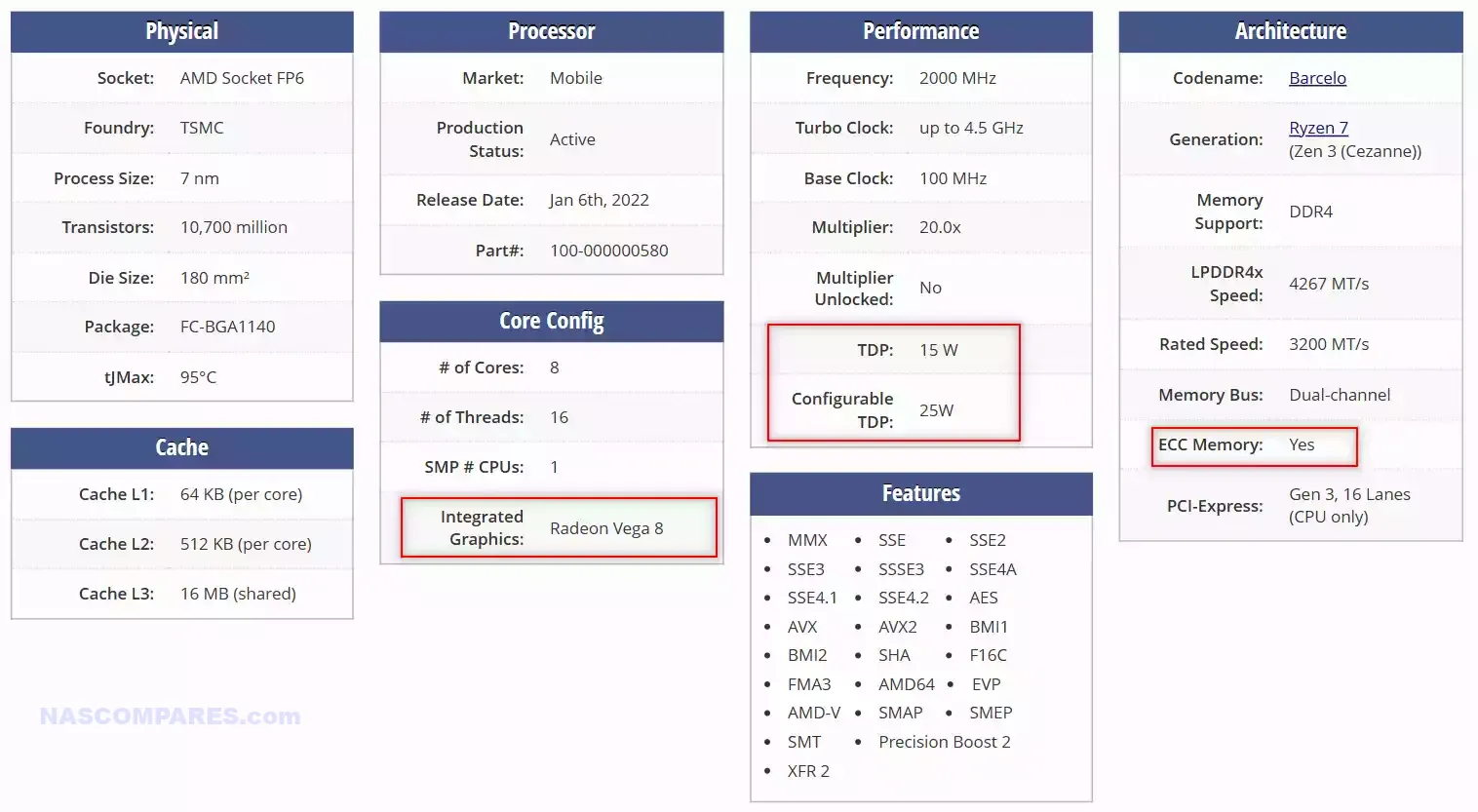
There are an increasing number of Embedded Ryzen CPU equipped NAS motherboards rolling out in 2024 (with 2025 looking set to double this) and with often an increased CPU thread count vs Intel alternatives, as well as a reduced TDP when compared with Intel Core or XEON options, the 5825U CPU on this board is a decently flexible choice.
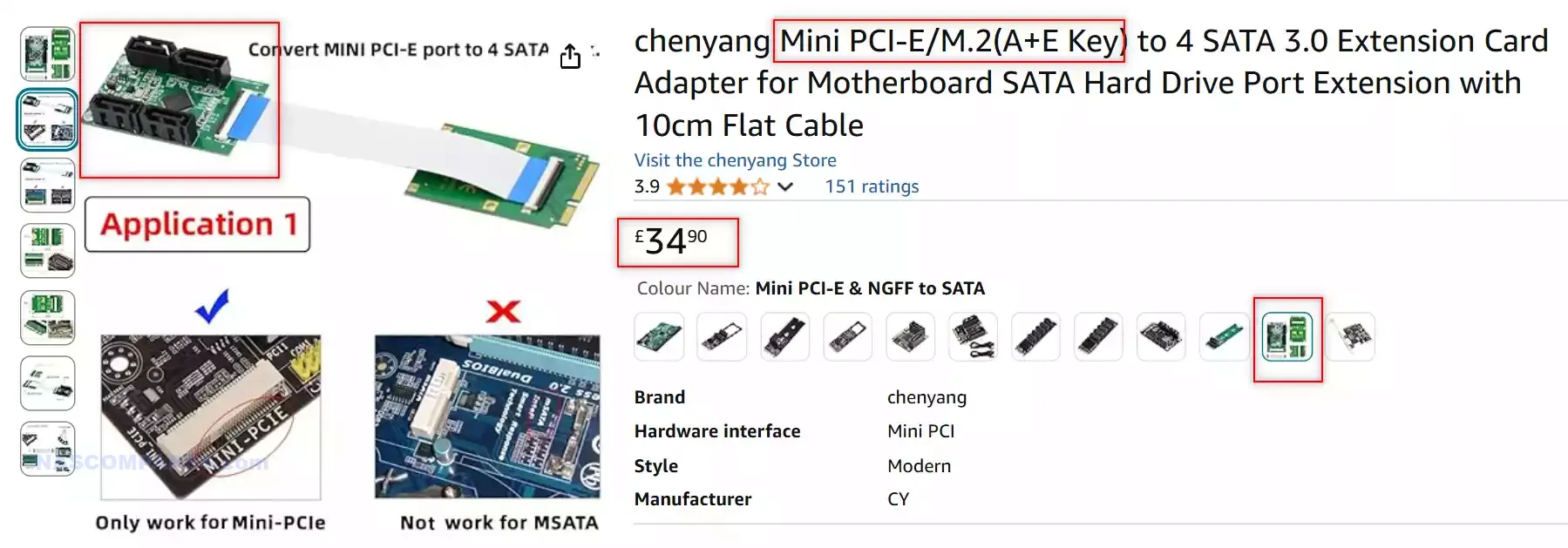
And do not forget that the m.2 key and mini PCIe slot on this board can also be used for some pretty diverse adapters when you want to scale things up down the line at a fairy low cost. This is one fo the more power hungry CPUs on this list, but once you balance it against the price and flexibility, it’s might well balance out for you.
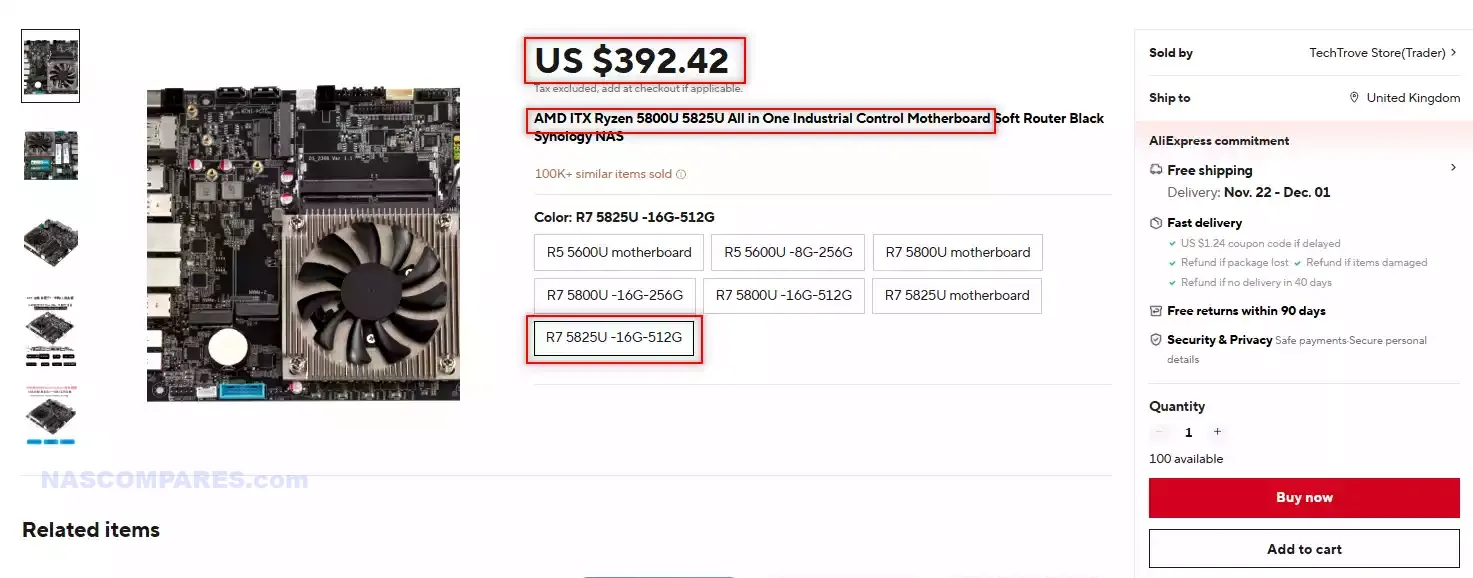
AMD ITX Ryzen 5825U Motherboard+CPU+RAM Combo DIY NAS $392 HERE
Pros and Cons
| Pros | Cons |
|---|---|
| Dual 2.5GbE ports for faster network speeds | No ECC memory support for data-critical applications |
| Low power consumption with Ryzen mobile CPU | Limited expansion options due to compact design |
| Capable of light media transcoding | DDR4 memory may limit future-proofing |
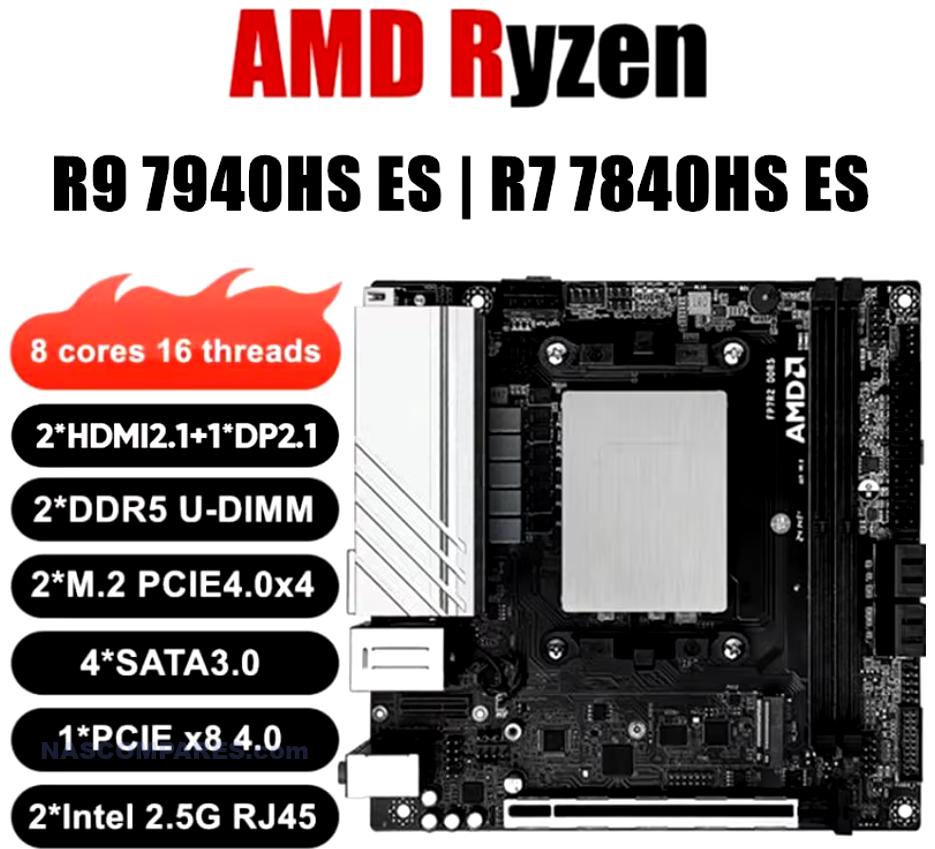
Topton Ryzen 7/9 7940HS 8-Core ITX NAS Board – High Performance in Compact Form
Spec Highlights – AMD Ryzen 3/5/7/9 7940HS, 8 Cores/16 Threads, Dual M.2 NVMe, 4 SATA, PCIe x8 slot, Dual 2.5GbE LAN, DDR5 Support, Mini ITX – $260.10 (AliExpress)
The Ryzen 9 7940HS NAS board delivers high performance in a compact form factor, targeting users who require substantial compute power within a limited space. Equipped with an 8-core, 16-thread processor, this board supports tasks that require fast processing and reliable data access, making it suitable for small businesses or users with data-intensive needs. With support for dual M.2 NVMe drives, four SATA ports, and dual 2.5GbE LAN ports, it provides a balanced combination of storage and network capability.
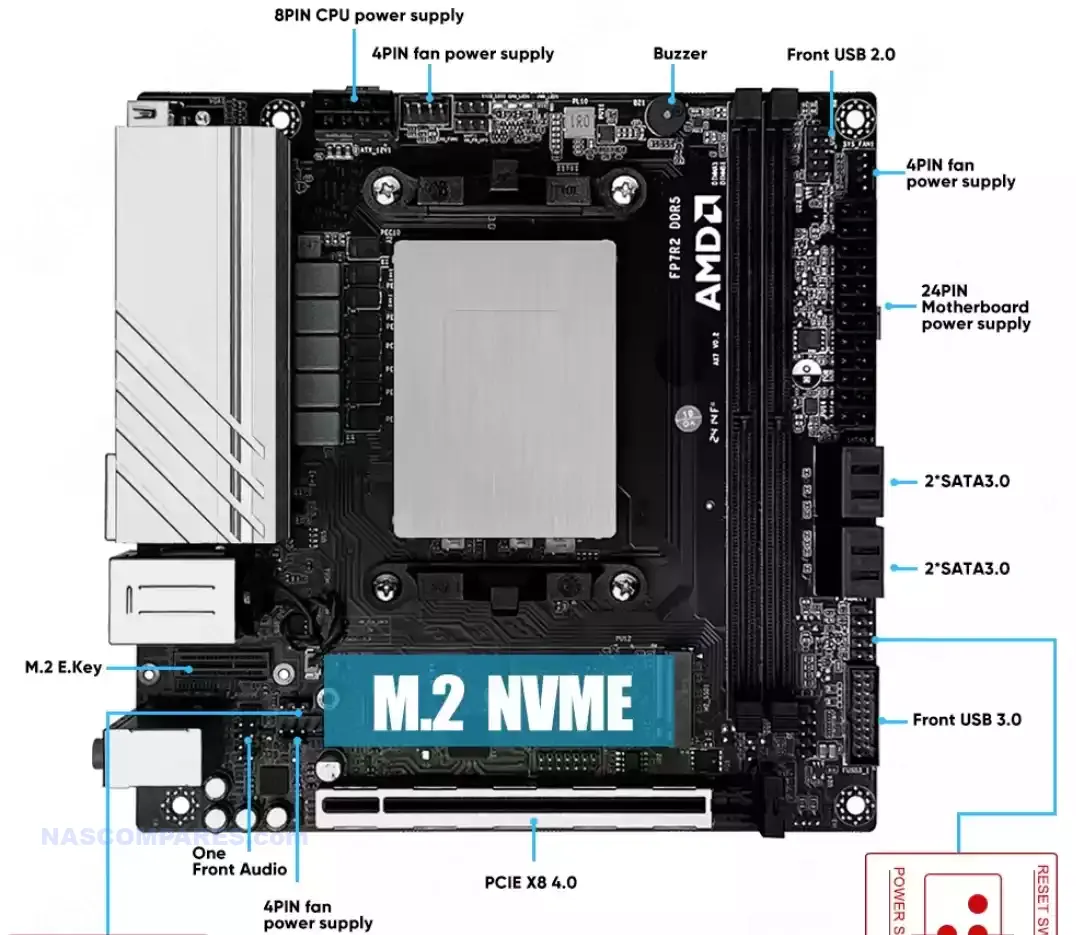
A notable feature is the inclusion of a PCIe 4×8 slot, which provides the flexibility to add components such as a GPU or an additional network card. Though positioned at a higher price point, the board’s capabilities are well-aligned with those needing performance for data analysis, media editing, or virtualized environments.
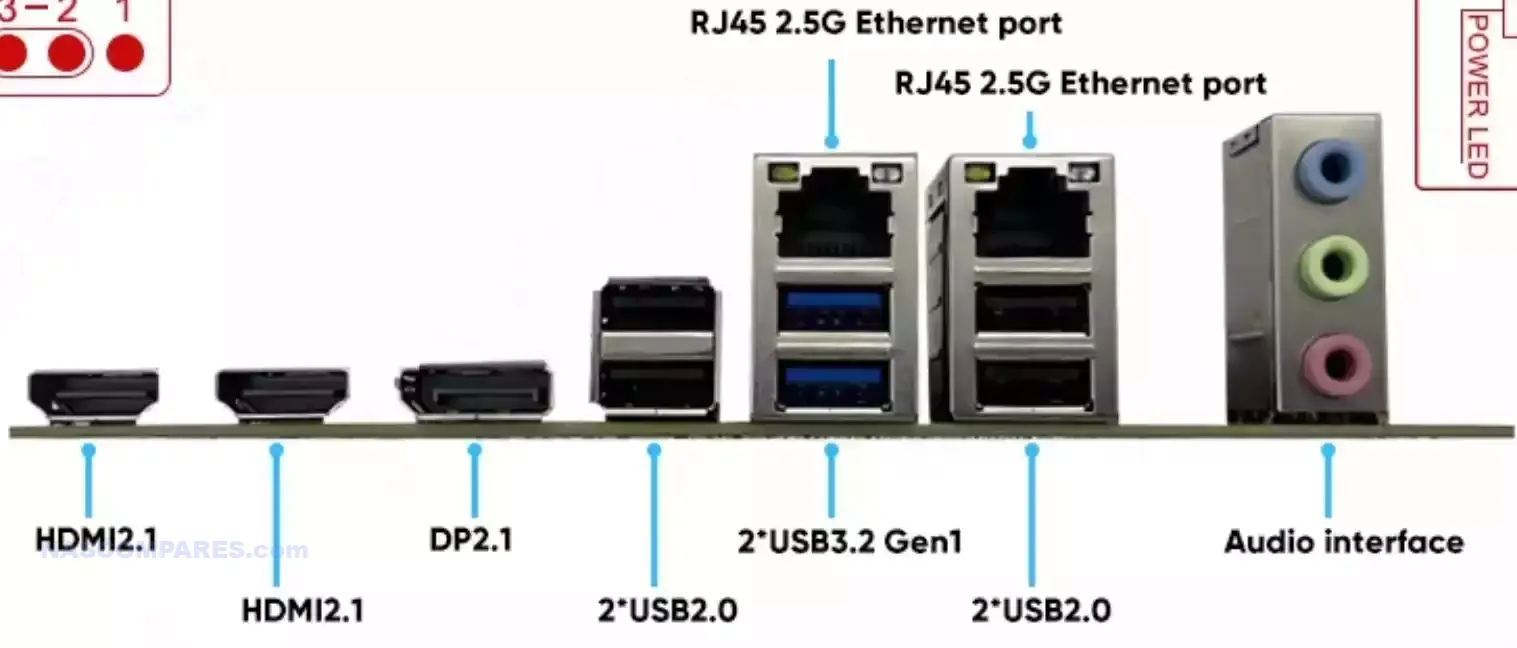
Of all of the CPU+MoBo NAS combos on this list, the R9 7940HS ES version provides arguable the largest amount of scalability than any other on this list. The ECC DDR5 UDIMM Memory slots are surprisingly rare on pre-attached SoC CPU NAS ITX mobos, but then you have the Gen 4×4 M.2 NVMe slots (so 8GB/s bandwidth) and even a PCIe Gen 4 x8 slot (16GB/s) upgrade slot!
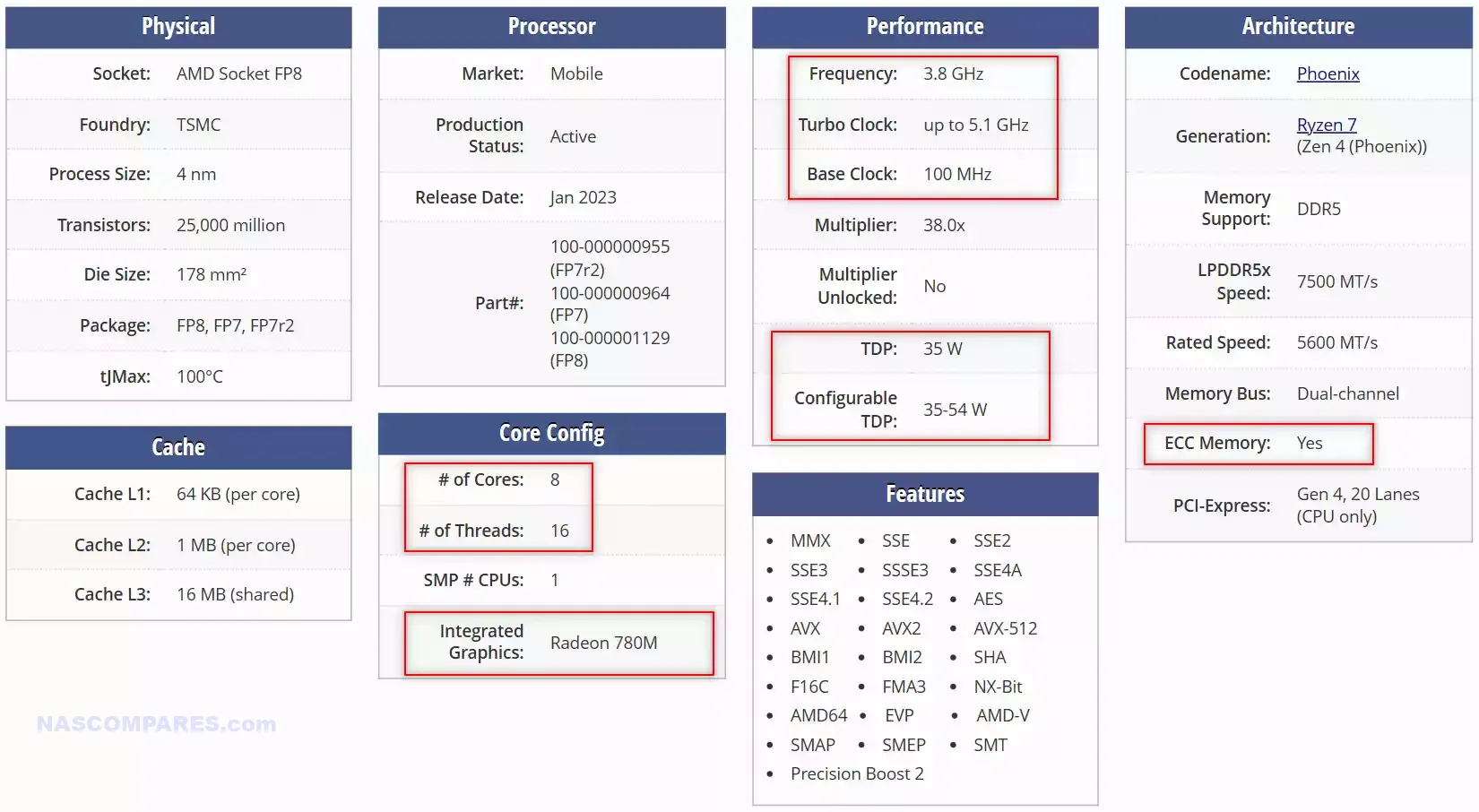
Just keep in mind that you are looking at a noticeably higher TDP rated CPU than anything else on this list too! Looking at a small but powerful Proxmox setup? GREAT! Looking to just host a small file server.. this would be phenomenal overkill!
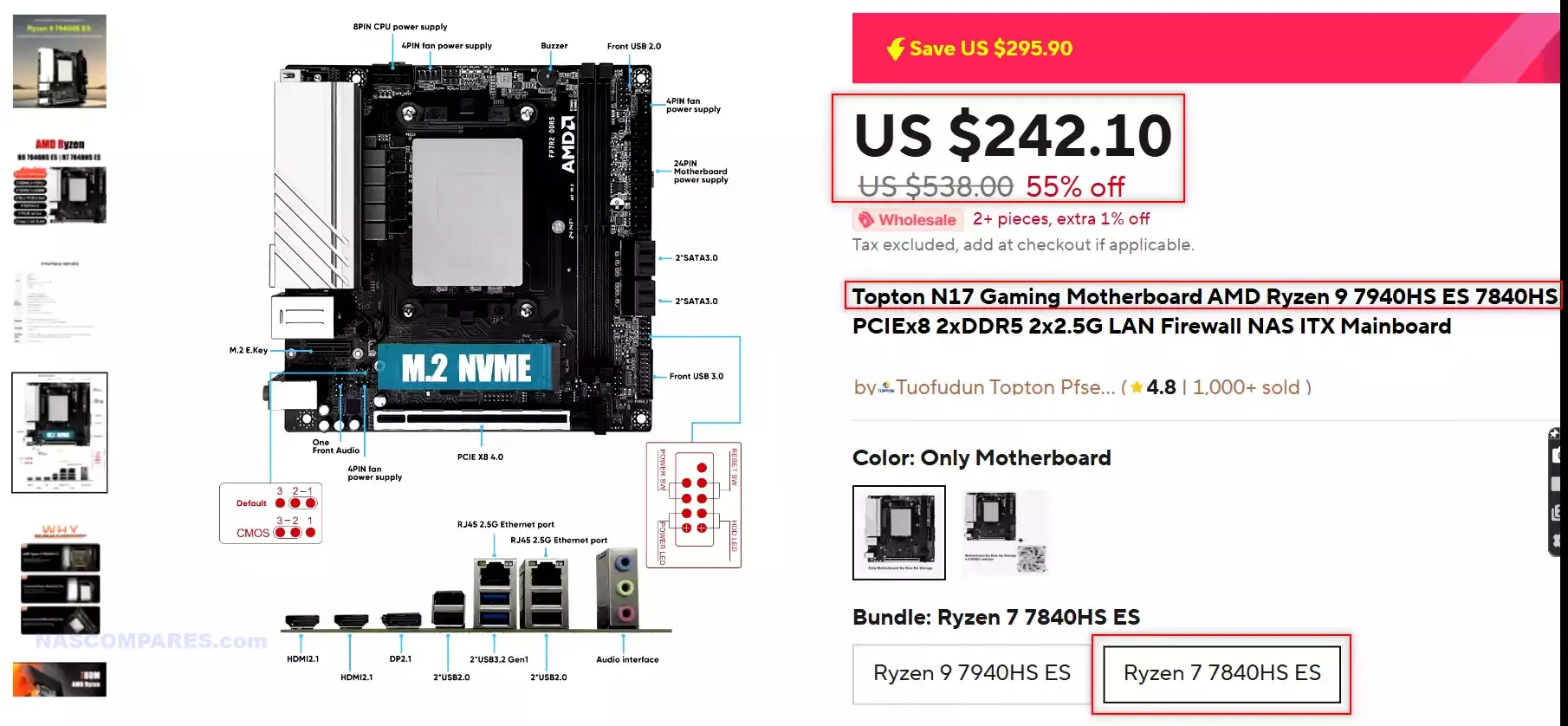
Topton N17 Gaming AMD Ryzen 7 7840HS ES 2xNVMe 4xSATA NAS Combo $242.10 HERE
Pros and Cons
| Pros | Cons |
|---|---|
| High-speed Ryzen 9 processor for intensive tasks | Higher power requirements for mobile Ryzen CPU |
| Dual M.2 NVMe slots and 4 SATA for flexible storage | Limited ECC support for professional data protection |
| Dual 2.5GbE LAN supports high network traffic | Higher price point due to high-performance CPU |
The current selection of NAS motherboards provides a versatile foundation for building tailored storage solutions that fit various needs and budgets. From Intel’s 11th and 12th generation processors to AMD’s Ryzen series, these configurations offer efficient performance, compact form factors, and a range of features like multiple SATA and M.2 slots, high-speed network connectivity, and low power consumption. With options supporting ECC memory, advanced RAID setups, and integrated graphics, these boards meet the requirements of tasks from simple file storage to multimedia streaming and virtualization. Whether for professional or home use, these NAS motherboard and CPU combinations provide a reliable and customizable approach to building a network-attached storage system in 2024 and beyond.
PREVIOUS Recommended NAS CPU+MoBo Combos
Below are NAS board combos that I recommended back in Feb of 2024. A few of these are still available and are seeing discounts, so if none of the more recently released options mentioned so far meet your needs, it might be worth looking into these:
ECC CPU+Motherboard M-ITX Combo – The CWWK 8-Bay / 9-Bay Board AMD-7735HS/7840HS/8845HS/7940HS
Spec Highlights – 4x AMD MobileRyzen Options, SODIMM DDR5 Slots×2, ECC Supported, 2×M.2 2280 4×2 SSD Slots, PCIe 4×8 connector ×1 (x16 Physical), SFF-8643 x2 Connectors for SATA III, 4x 2.5GbE, USB 4 (20Gbs Limits) , Internal USB 2.0 – $489 on AliExpress and Check on Amazon
The combination of the AMD “Zen 4” architecture Ryzen™ 5/7/9 series processors with the Minisforum motherboard offers a high-performance platform that is particularly suitable for building a Network Attached Storage (NAS) server. The Mini-ITX form factor of the motherboard, compatible with 1700 series CPU coolers, ensures that it can fit into compact NAS cases while providing adequate cooling for the powerful processors housed within. In the realm of NAS servers, storage options and connectivity are key. The motherboard’s two M.2 NVMe (PCIe 4.0 x2) slots are ideal for high-speed storage drives that can handle intense read and write operations typical in a NAS environment. The inclusion of 2 * SFF-8643 sockets, which support up to four connections each and a total of 9 SATA 3.0, is an advanced feature that provides flexibility and scalability for storage expansion. This is particularly beneficial for NAS setups where large storage pools and redundancy (such as RAID configurations) are important.
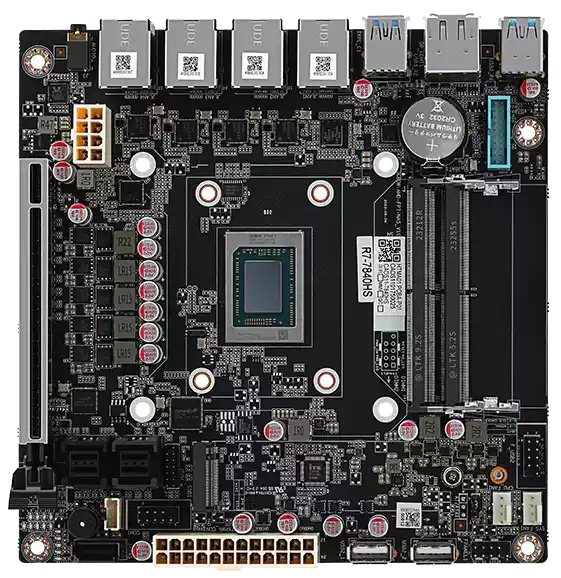
Network connectivity is another critical aspect of NAS servers, and this motherboard delivers with its 4 * Intel i226-V 2.5G RJ45 UDE network ports, allowing for high-speed data transfer and network redundancy or link aggregation if required. However, the lack of 10GbE port might limit the network throughput if higher speeds are needed, in which case the PCIe Gen 5×16 slot could be employed for an additional network interface card, although this might be considered an inefficient use of this high-bandwidth expansion slot. Lastly, the wide array of USB ports, including USB3.2 Gen2 Type-C with a 20Gbps rate and additional USB3.2 and USB2.0 ports, adds to the versatility of this motherboard. The built-in set of USB3.2 pin sockets also allow for further expansion and connectivity options, essential for a NAS that may need to accommodate a variety of peripherals or provide additional data transfer interfaces.
| Feature Category | Specifications |
|---|---|
| Processor Support | Equipped with AMD “Zen 4” architecture Ryzen™ 5/7/9 series high-performance processors |
| Form Factor | 17×17 standard Mini-ITX form factor compatible with 1700 series CPU coolers |
| Expansion Slots | 1 PCI-E x16 slot PCIe 4.0 x8 signal supports expansion of graphics card/network card, etc. |
| Storage | 2 * M.2 NVMe (PCIe 4.0 x2) slots 2280 size |
| SATA Support | 2 * SFF-8643 sockets support one to four via cable and support 9 SATA 3.0 |
| Memory | Dual-channel SO-DIMM DDR5 slot supports 5600MHz backward compatibility by default<br>Dual-channel SO-DIMM DDR5 slot supports server-grade ECC notebook strip |
| Networking | 4 * Intel i226-V 2.5G RJ45 UDE network ports support AllinOne and other applications |
| Video Output | HDMI+DP+Type-C triple display output supports 4K@60Hz |
| USB Ports | 3 * USB3.2+1 Type-C (USB4) interface 20Gbps rate<br>Built-in set of USB3.2 pin sockets can be connected to the panel through connecting cables<br>Built-in two USB2.0 sockets support U disk encryption and other applications and partial system boot |
Given these specifications, the Minisforum motherboard with an AMD Ryzen processor is well-equipped for a NAS server build, offering a balance of processing power, high-speed storage capabilities, and robust connectivity options.
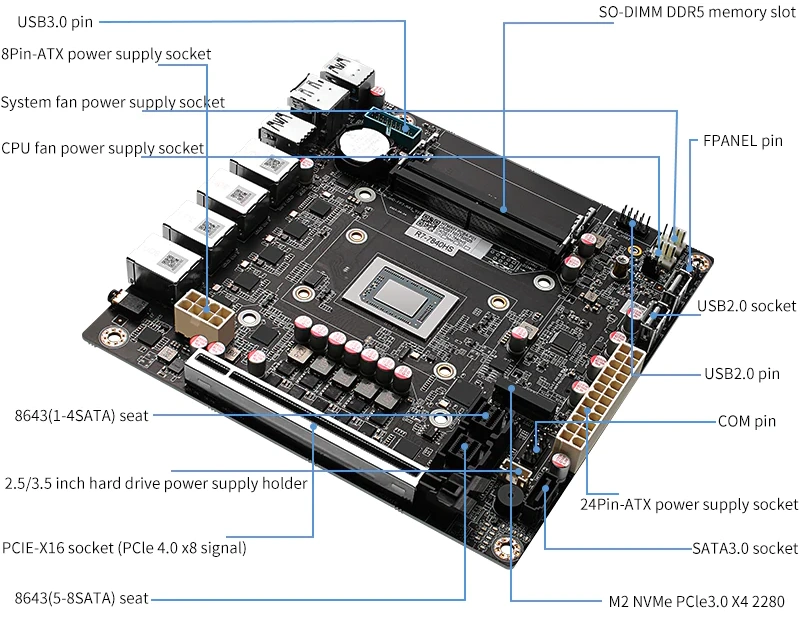
| Where to Buy the CWWK 8-Bay / 9-Bay Board AMD-7735HS/7840HS/8845HS/7940HS Motherboard Combo: |
Best Gen 5 CPU+Motherboard Combo – MINISFORUM BD770i ITX Motherboard
Spec Highlights – BD770i-AMD Ryzen 7 7745HX, 8 Cores/16 Threads (5.1 GHz) OR BD790i-AMD Ryzen 9 7945HX, 16 Cores/32 Threads (up to 5.4 GHz), SODIMM DDR5 Slots×2 Max 64GB, 2×M.2 2280 PCIe5.0 SSD Slots, PCIe 5.0 X16 connector, 1x 2.5GbE and Lack of SATA! – $489 on AliExpress and $399 on Amazon
The Minisforum BD770i and BD790i motherboard and CPU combo represents a cutting-edge solution for enthusiasts and professionals seeking powerful performance in a small footprint. With the BD770i featuring the AMD Ryzen™ 7 7745HX and the BD790i equipped with the AMD Ryzen™ 9 7945HX, these systems offer unparalleled processing power that caters to a wide range of demanding tasks, from advanced computational workloads to intensive multitasking scenarios. The AMD Radeon™ 610M GPU, integrated into both models, while not designed for high-end gaming, capably supports everyday graphics needs, including casual gaming, video streaming, and content creation, making this combo a versatile choice for various computing needs.
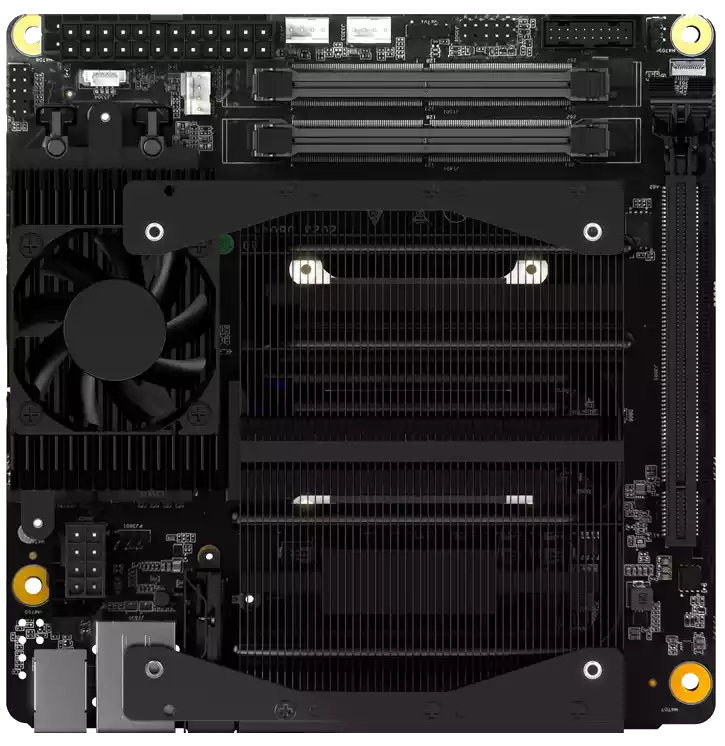
The inclusion of PCIe 5.0 support stands out as a significant advantage, offering double the bandwidth of its predecessor, PCIe 4.0. This enhancement ensures that users can take advantage of the fastest available SSDs and expansion cards, dramatically reducing load times and facilitating quicker data access. This forward-thinking feature ensures that the system is prepared to handle future technological advancements, making it a wise investment for tech enthusiasts looking to stay ahead of the curve. However, it’s important to note the absence of traditional SATA ports, which means users with SATA drives will need to consider alternatives such as SATA M.2 adapters or adding a PCIe card to accommodate these devices. This requirement might necessitate additional planning and investment for those who wish to integrate existing storage solutions into their new setup.
| Specification | BD770i | BD790i |
|---|---|---|
| Processor | AMD Ryzen™ 7 7745HX, 8 Cores/16 Threads<br>(32M Cache, up to 5.1 GHz) | AMD Ryzen™ 9 7945HX, 16 Cores/32 Threads<br>(64M Cache, up to 5.4 GHz) |
| GPU | AMD Radeon™ 610M | AMD Radeon™ 610M |
| Memory | DDR5 Dual channel<br>(SODIMM Slots×2, up to 5200 MT/s, Max 64GB) | DDR5 Dual channel<br>(SODIMM Slots×2, up to 5200 MT/s, Max 64GB) |
| Storage | 2×M.2 2280 PCIe5.0 SSD Slots | 2×M.2 2280 PCIe5.0 SSD Slots |
| Expansion Slot | PCIe 5.0 X16 connector ×1 | PCIe 5.0 X16 connector ×1 |
| Wireless Connectivity | M.2 2230 Key E Slot | M.2 2230 Key E Slot |
| Video Output | HDMI2.0 ×1<br>DisplayPort1.4 ×1<br>USB-C ×1 | HDMI2.0 ×1<br>DisplayPort1.4 ×1<br>USB-C ×1 |
| Audio Output | HDMI2.0 ×1<br>DisplayPort1.4 ×1<br>USB-C ×1<br>Line Out ×1 | HDMI2.0 ×1<br>DisplayPort1.4 ×1<br>USB-C ×1<br>Line Out ×1 |
| Ethernet | RJ45 2.5G Ethernet Port×1 | RJ45 2.5G Ethernet Port×1 |
| USB Ports | USB3.2 Gen2 Type-C Port ×1 (Alt DP)<br>USB3.2 Gen1 Type-A Port ×2<br>USB2.0 Type-A Port ×2 | USB3.2 Gen2 Type-C Port ×1 (Alt DP)<br>USB3.2 Gen1 Type-A Port ×2<br>USB2.0 Type-A Port ×2 |
| I/O Ports | 4-pin CPU Fan header ×1<br>4-pin System Fan header ×2<br>4-pin SSD Fan header ×1<br>USB 3.2 Gen 1 header ×1<br>Front Panel Audio header ×1<br>System Panel header ×1 | 4-pin CPU Fan header ×1<br>4-pin System Fan header ×2<br>4-pin SSD Fan header ×1<br>USB 3.2 Gen 1 header ×1<br>Front Panel Audio header ×1<br>System Panel header ×1 |
| Form Factor | Mini-ITX Form Factor (170x170x1.6mm) | Mini-ITX Form Factor (170x170x1.6mm) |
A notable constraint in this powerful combo is the provision of a single RJ45 2.5G Ethernet port. While this port offers a solid network connection suitable for most applications, users with specialized networking needs or those looking to expand their network connectivity may find this limitation challenging. The necessity to potentially use the high-speed PCIe 5.0 slot for a network interface card upgrade, just to augment networking capabilities, could be seen as an inefficient use of this high-bandwidth resource. This situation highlights a trade-off between the advanced PCIe support and the flexibility in networking expansion, prompting users to carefully consider their priorities when planning their system configuration.
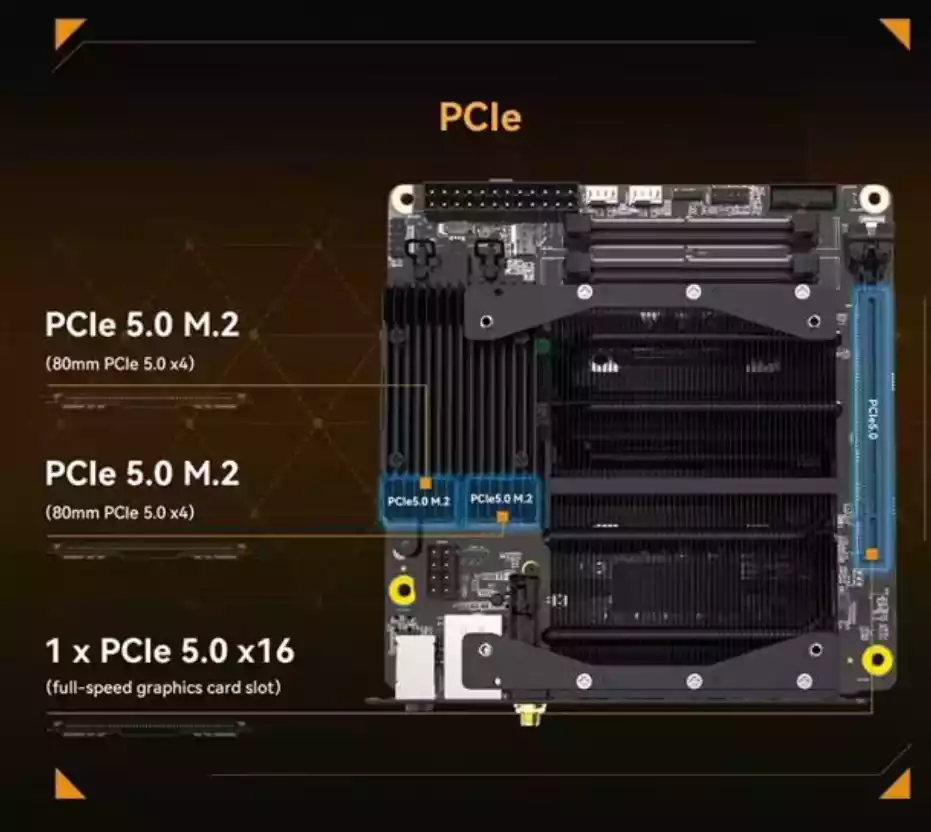
Despite these considerations, the overall package offered by the Minisforum BD770i and BD790i is compelling. The combination of cutting-edge CPU performance, robust PCIe 5.0 support, and a variety of connectivity options, including USB 3.2 ports and multiple video outputs, provides a solid foundation for a high-performance, compact computing solution. #
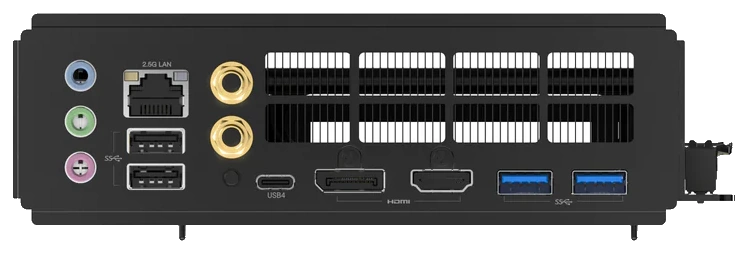
Furthermore, the support for up to 64GB of DDR5 memory and the inclusion of two M.2 2280 PCIe 5.0 SSD slots offer ample room for memory and storage expansion, enhancing the system’s capability to handle future needs. This blend of high-end features, coupled with the Mini-ITX form factor’s space efficiency, makes the BD770i and BD790i an attractive option for users seeking a powerful, yet manageable, computing platform.
| Where to Buy the MINISFORUM BD770i ITX Motherboard Combo: |
Best CPU+ Motherboard for a Premium Feature but Low Power Consumption NAS – The i3-N305 M-ITX Board
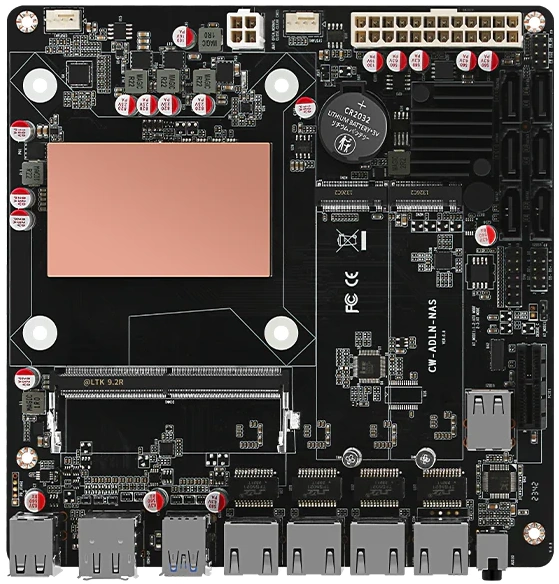
Spec Highlights – i3-N305, 4x Intel i226-V 2.5G Nics, 2x M.2 NVMe. 6x SATA, 1*DDR5 SODIMM, HDMI2.0 + DP – $289 on AliExpress
Currently, the “build your own” favorite across many forums, the new Intel N305 processor, an 8-core, eight-thread i3 processor, comes pre-installed on a Mini-ITX board. It not only provides a remarkably low 7-watt TDP when needed but also offers significant scalability in terms of both clock speed and power efficiency. The $289 N305 version of the CPU and Motherboard combo presents a practical and economical choice for commercial use (making it the perfect upgrade/alternative to the Topton N6005 / N5105 that was so popular last year for first time NAS DiY’ers). It is equipped with the Intel® Core™ i3-N305 Processor, which is a part of the Alder Lake-N series. This processor boasts eight cores and eight threads, with a max turbo frequency of 3.80 GHz, offering ample computing power for everyday tasks and certain commercial applications. The processor is fabricated using Intel 7 lithography technology, which is indicative of its advanced and efficient design.
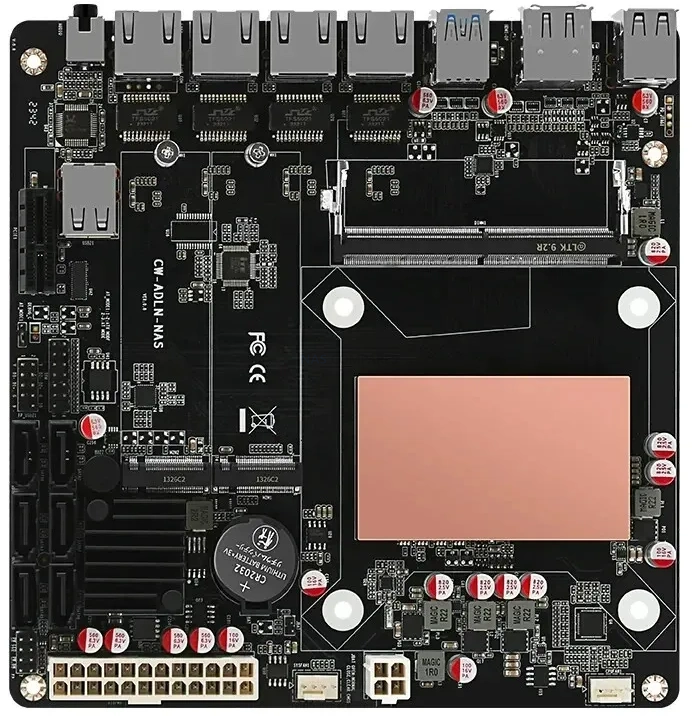
Memory support on this combination is versatile, with the motherboard supporting a SO-DIMM DDR5 memory slot, compatible with frequencies of 4800/5200/5600MHz. Although the processor supports a maximum memory size of 16 GB, which is a consideration to keep in mind, the motherboard can handle up to 32 GB, potentially allowing for future upgrades if the board’s capacity is indeed supported by later CPU models or firmware updates.

The integrated graphics, Intel® UHD Graphics with 32 Execution Units, can dynamically operate at up to 1.25 GHz and support 4K content at 60Hz, making it suitable for high-definition displays and basic graphical tasks. Here’s the specification of the $289 N305 version of the CPU+Motherboard combo:
| Specification | Detail |
|---|---|
| Model Number | NAS-N100-N305 |
| Processor Brand | Intel |
| Processor Models | Intel® Alder Lake-N i3-N305 (up to 3.8 GHz) |
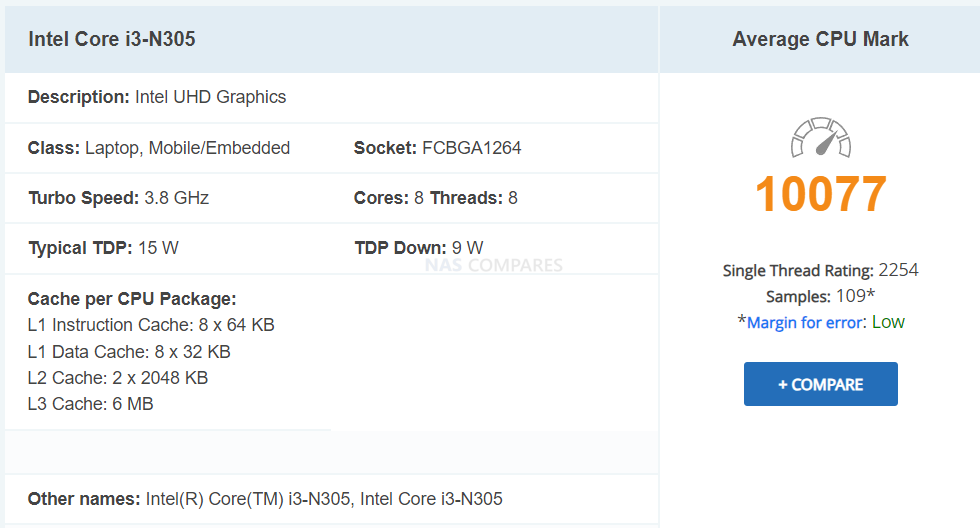 |
|
| Type | MINI PC / PC Stick |
| Origin | Mainland China |
| Brand Name | YSJMNPC |
| Use | Commercial |
| Memory | – Support notebook DDR5 technology |
| – 1 SO-DIMM DDR5 slot | |
| – Compatible with 4800/5200/5600MHz | |
| – Max capacity: 32GB | |
| Storage | – 6 x SATA3.0 6Gb/s interface |
| – 2 x M.2 NVMe 2280 | |
| Graphics Card | Integrated Card (depending on processor model) |
| Network Card | 4 x Intel i226-V 2.5G RJ45 network port |
| I/O Panel | – 2 x USB 2.0 |
| – 1 x USB 3.0 | |
| – 1 x Type-C (2.0 rate) | |
| – 1 x HDMI | |
| – 1 x DP | |
| – 4 x RJ45 2.5G network port | |
| – 1 x AUDIO 3.5mm interface | |
| Motherboard Features | – Matte black PCB |
| – Moisture-free fiber 8-layer circuit | |
| – Full protection (USB, audio, network) | |
| TDP | 9-15W |
| Structure | MINI-ITX (17.0cm x 17.0cm) |
| Capacitor Design | All solid capacitor |
| Expansion Slots | 1 PCIe x1 (shared with 2nd M.2) |
| Onboard Interface | – F_PANEL pin |
| – TPM pin (compatible with ASUS TPM module) | |
| – USB2.0 pin | |
| – CPU_FAN 4-pin (temperature control) | |
| – SYS_FAN 4-pin (temperature control) | |
| – 24+4 ATX power interface | |
| Cooling | – Compatible with 115X radiators |
| – Silent temperature-controlled radiator | |
| – Support for two high-performance radiators | |
In terms of connectivity, the combo is well-equipped with a variety of interfaces, including multiple USB ports with different standards, HDMI 2.1, and DisplayPort 1.4 for video output, and an Intel i226-V 2.5G RJ45 network port for fast wired internet connections.
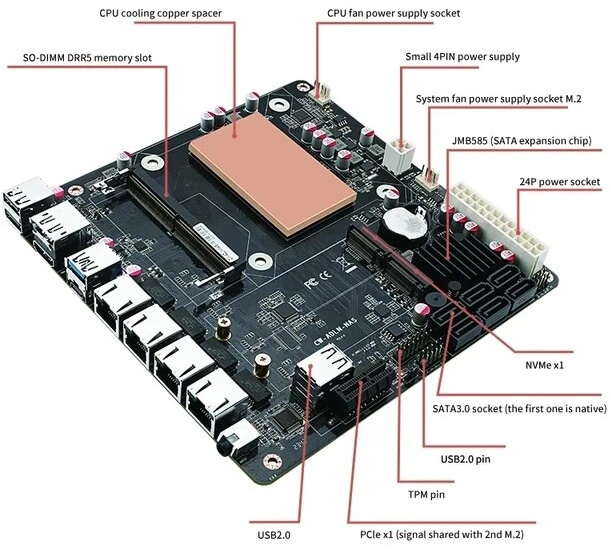
The inclusion of PCIe lanes and M.2 slots provides additional expansion capabilities, allowing for further customization and the addition of peripherals or storage solutions. The motherboard’s MINI-ITX form factor makes it a compact solution that can fit into small cases, suitable for workspaces with limited room. EASILY the easiest choice of all the NAS Mobo+CPU options on this list, as one of the newest, lowest in price – yet impressively powerful, despite its lower TDP.
| Where to Buy the i3-N305 CPU + M-ITX Motherboard Combo: |
Best CPU+ Motherboard+ Memory Combo for a Business File Server – The X99 Motherboard Kit (ITX)
Spec Highlights – Business X99 Motherboard Combo ITX LGA2011, C612 for NAS Router+File Server, 6×2.5GbE I226, 10xSATA, 1x M.2 (OS), 14Core / 28 Thread Intel Xeon E5-V3 V4- $176 on AliExpress
This combination is ideal for business users needing power and scalability. The X99 motherboard with an older Xeon CPU balances performance, connectivity, and storage expansion. It supports 10 SATA drives and a M.2 NVMe slot, alongside 15 gigabits of network bandwidth across six 2.5G Ethernet ports. The NAS CPU+Memory combo anchored by the Intel Xeon E5-2680 v4 is a robust solution for a NAS file server. The CPU’s 14 cores and 28 threads are engineered for multitasking and can efficiently manage the demands of multiple simultaneous data transactions, which is a common requirement in NAS setups. The motherboard’s ten SATA ports and an M.2 NVMe slot offer versatile and ample storage options, facilitating both high-capacity and high-speed data storage solutions. This combination of CPU power and storage flexibility makes it an excellent choice for a NAS system.
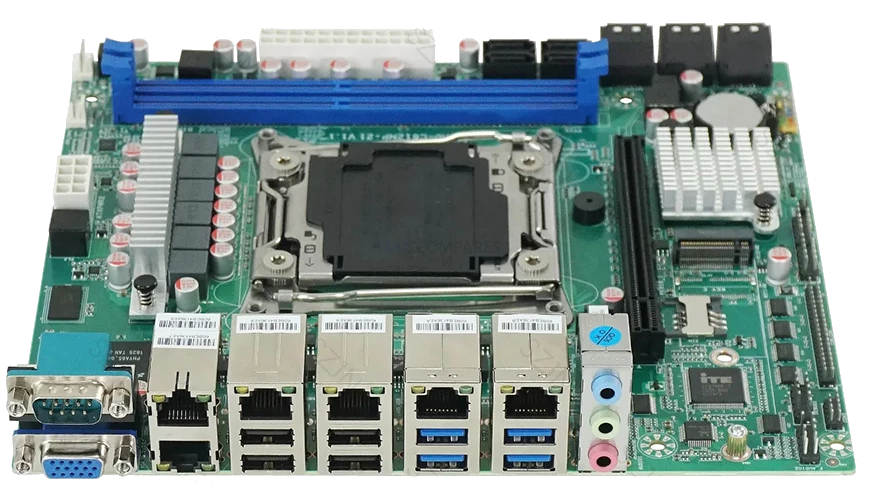
owever, the Intel Xeon E5-2680 v4 processor’s launch date in Q1’16 might give pause to some users considering the latest advancements in processor technology. While newer CPUs may offer improved power efficiency and the benefit of ongoing support from Intel, the E5-2680 v4 still holds its ground as a reliable workhorse. Its architecture, although not the newest, delivers steadfast performance which, alongside its competitive pricing, presents an exceptional value proposition for budget-conscious setups or where cutting-edge efficiency is not the primary concern.

| Specification | Details |
|---|---|
| Processor | Intel Xeon E5-2680 v4, 14 cores, up to 3.30 GHz Turbo |
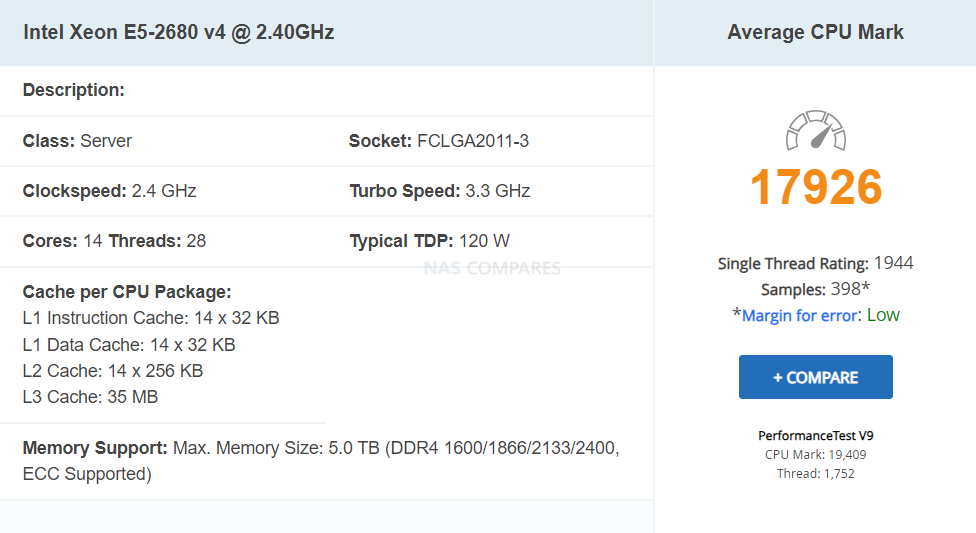 |
|
| Chipset | Intel C612 |
| Memory Support | 2x DDR4 DIMM slots, up to 64 GB, supports ECC |
| Storage Options | 1x M.2 NVMe, 10x SATA Ports |
| Expansion | 1x PCIe 3.0 x16 |
| Network | 6x Intel i226 2.5 Gigabit Ethernet |
| Power Supply | ATX 24 Pin + 8 Pin |
| Video Output | VGA |
| RAID Support | RAID 0/1/5/10 |
| Form Factor | Mini-ITX, CEB |
| Socket Type | LGA 2011-3 |
| Launch Date | 2013 |
| LAN Speed | Up to 2500Mbps |
| Audio | 2.1 Channels |
In essence, for organizations or users seeking a cost-effective yet powerful NAS solution, this CPU and motherboard combo remains compelling. The Intel Xeon E5-2680 v4, despite its age, is a testament to enduring performance in server environments. Users leveraging this processor for a NAS will find it to be a cost-effective solution that capably handles storage demands, making it an excellent value for its price point. To explore more about this processor’s capabilities and see how it might fit into your NAS plans, you can visit the Intel specifications page.
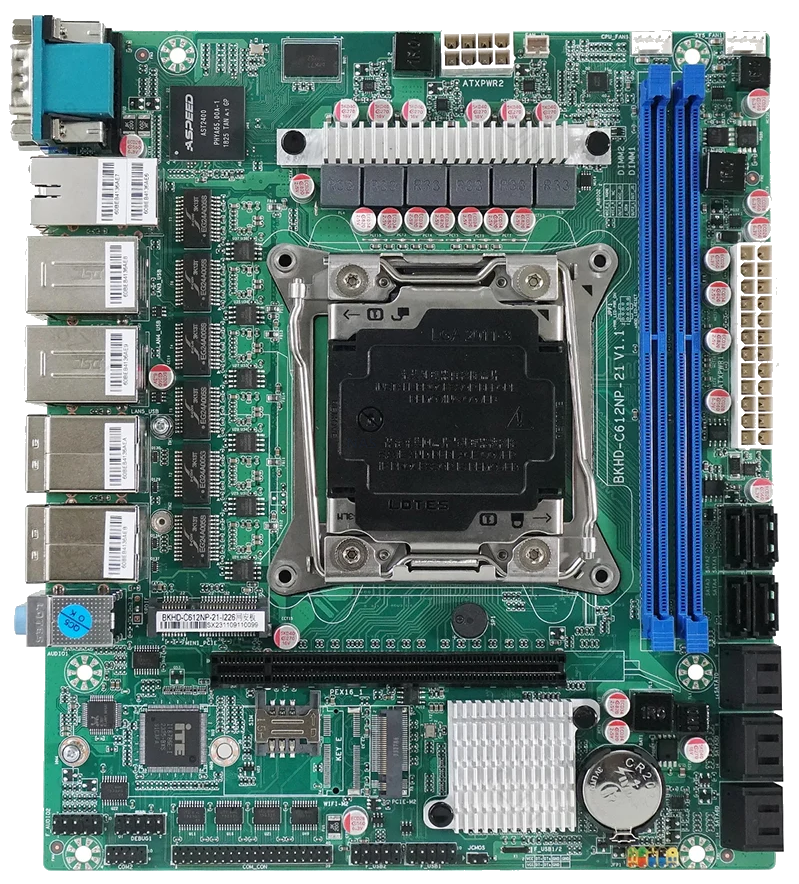
| Where to Buy the X99 ITX Motherboard Combo in 3 Configs Here: |
Best CPU+ Motherboard for High Speed M.2 NVMe Slots + PLEX – The Erying 13900HK CPU+Mobo Combo
Spec Highlights – ERYING DIY ITX Desktop Motherboard Set with Onboard 14 Core / 20 Thread CPU i9-13900HK, 3x M.2 NVMe (Gen 4 and Gen 3), PCIe 4×8 Slot, 2.5G+1G Port, USB-C, DDR5 Memory $419 on AliExpress
Designed for NAS builders focusing on media servers or intensive computing tasks. The Erying i9 combo, equipped with a 13th Gen Intel Core processor and a Mini-ITX motherboard, features three M.2 NVMe slots and is optimized for graphic-intensive operations. It’s ideal for Plex servers and virtualization.
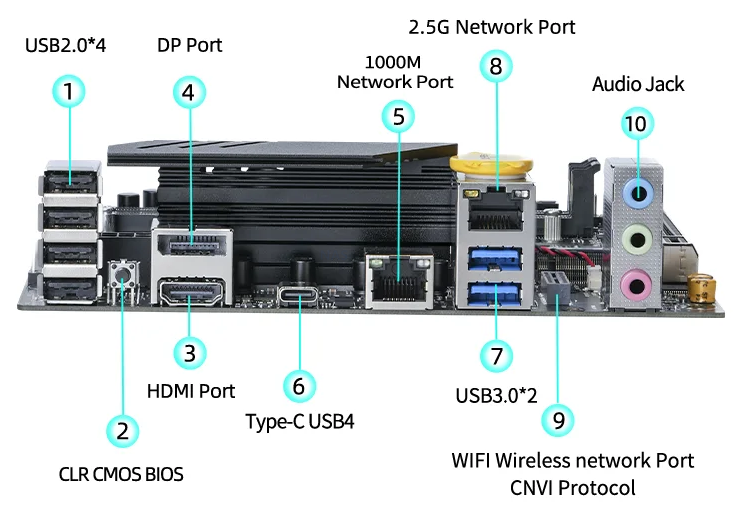
The Intel Core i9-13900HK processor bundled with this motherboard is a top-tier choice for a NAS setup, especially for a Plex Media Server. Its high-speed multi-core performance, reaching up to 5.40 GHz with Intel’s Turbo Boost Technology, is ideal for on-the-fly transcoding, ensuring seamless media streaming across devices. This is particularly beneficial for users who require their NAS to handle high-resolution video transcoding, a task that the i9-13900HK can manage with ease due to its robust processing capabilities and advanced integrated graphics.
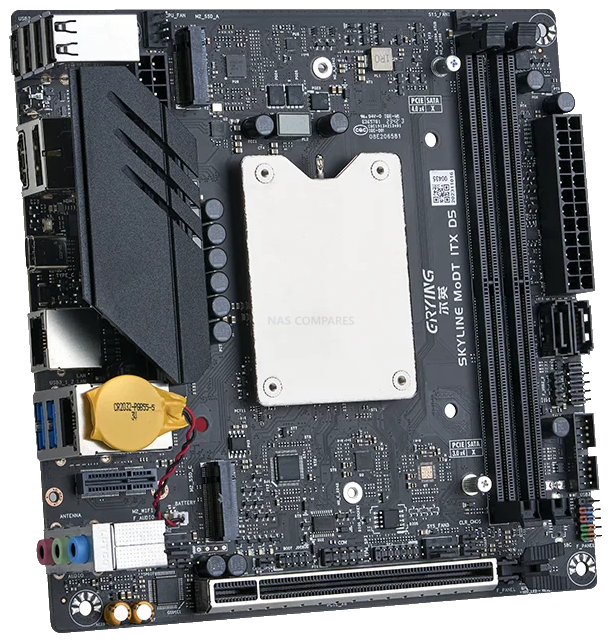
The motherboard’s triple M.2 NVMe slots are a game-changer for NAS configurations, offering not just ample storage potential but also blistering data access speeds. NVMe technology excels in high-demand scenarios, such as multiple simultaneous accesses to the NAS, which is common in VM / Container environments. Users can leverage these slots to set up a RAID configuration, allowing for either performance enhancement through striping or data redundancy for added security.
Moreover, the Intel Core i9-13900HK comes with Intel’s UHD Graphics, which supports 4K resolution at 60Hz over HDMI and DisplayPort outputs. This graphical prowess, in combination with the processor’s ability to support fast memory, adds to the NAS’s capability as a potent media server that can handle 4K content playback and transcoding without breaking a sweat.
| Specification | Detail |
|---|---|
| Processor | 13th Gen Intel Core i9-13900HK, up to 5.40 GHz |
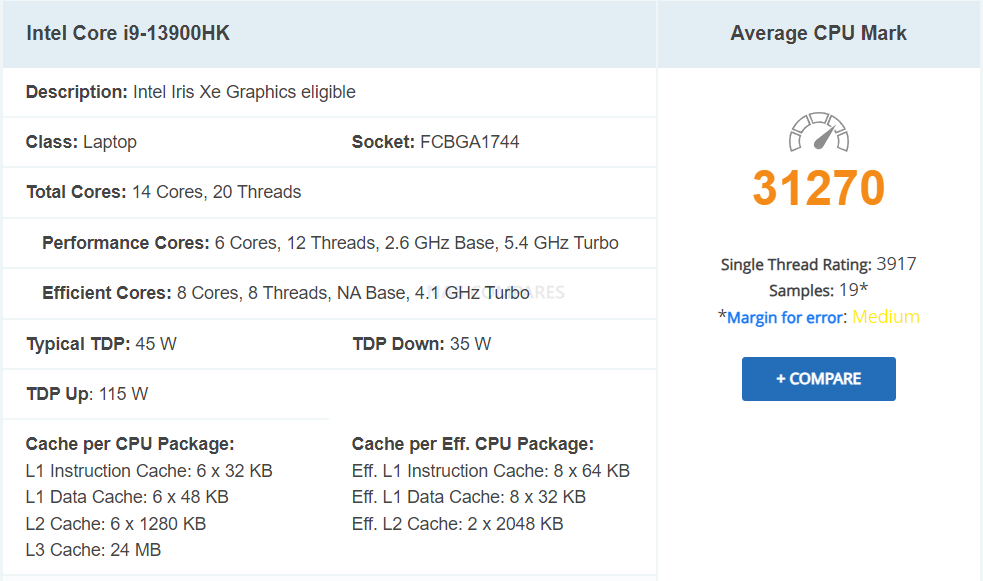 |
|
| Graphics | Integrated Intel Iris Xe Graphics |
| Memory Support | DDR5, 2 slots, up to 96GB |
| Storage Options | 3x M.2 slots (NVMe), 2x SATA 3 Ports |
| Expansion Slots | 1x PCIe 4.0 x4, 1x PCIe 4.0 x8 |
| Network | 2x Onboard RJ45, WiFi |
| Audio | 5.1 Channels |
| Back I/O Ports | 2x USB 3.2/3.1 Gen 1, DisplayPort, 4x USB 2.0, HDMI 2.0, 3x Audio Jacks |
| USB Support | USB 2.0, USB 3.0 |
| RAID Support | No |
| Form Factor | Mini-ITX |
| Chipset | Intel Others |
| Socket Type | Onboard CPU |
| Brand Name | ERYING |
| Origin | Mainland China |
| Certifications | RoHS, FCC, CE |
Finally, while this CPU+Motherboard combo is positioned as an advanced solution for NAS setups, its high-end specifications suggest that it is overqualified for just storage purposes. The presence of the latest connectivity options, robust I/O support, and high-bandwidth LAN ports make it well-suited for a variety of other intensive applications, including gaming, content creation, and design. This versatility ensures that the investment in such a setup can be justified across multiple use cases beyond a typical NAS. For detailed processor specifications and capabilities, further information can be explored on Intel’s official product specifications page.
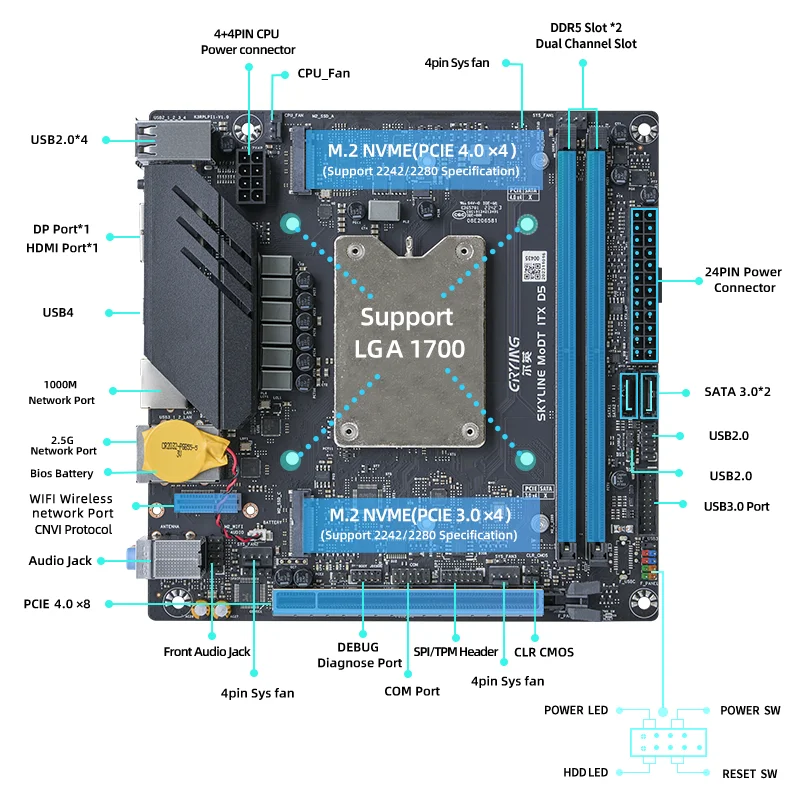
Bottom Line, there are going to be users who are looking at how expensive ‘turnkey’ NAS solutions can cost, then see what just the hardware parts would cost in a DiY alternative. For example, below is the cost of a fully specced out QNAP Intel Core build vs the cost fo JUST the CPU and Motherboard in the Erying board:
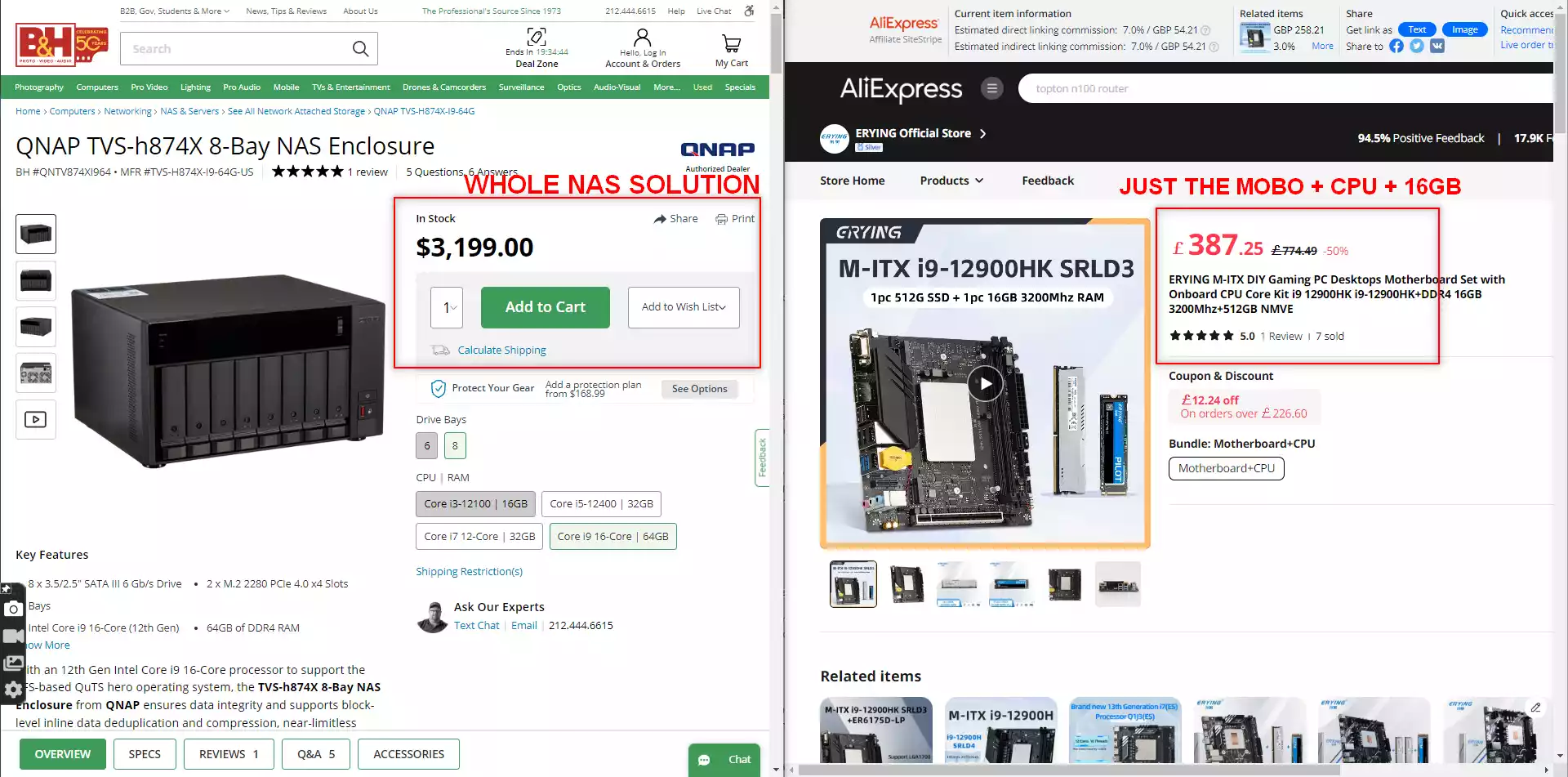
Needless to say, this is not a completely fair comparison. The QNAP includes all the building, the software, the PSU, cables, case, testing and all under a single warranty. Still, it IS food for thought for those that are happy to build their own NAS and save some $$$s.
Where to Buy the Erying Intel Mobo Combo (3 Versions):
C = Cores , T = Threads |
Best POWER + Storage CPU+Motherboard M-ITX Combo – The Intel 13th Gen The Minisforum AR900i (4x M.2 4×4 and 5×16 PCIe)
Spec Highlights – Intel® Core™ i9-13900HX Processor, 24 C/32 T (36M Cache, up to 5.4 GHz) Intel® UHD Graphics for 13th Gen Intel® Processors, SODIMM DDR5 Slots×2, up to 5600 MT/s, Max 64GB, 4×M.2 2280 PCIe4.0 x4, SSD Slots PCIe 5.0 X16 connector, 1x 2.5GbE and Lack of SATA AGAIN! – Check on AliExpress and $399 on Amazon
The Minisforum AR900i motherboard, in combination with the potent Intel® Core™ i9-13900HX CPU, forms a formidable base for power users. The AR900i is a Mobile Desktop (MoDT) motherboard that leverages the might of the 13th Gen Intel® flagship CPU, providing an exceptional 24 cores and 32 threads for heavy multitasking and demanding applications. Notably, the four M.2 2280 PCIe4.0 SSD slots are designed for rapid storage with RAID capabilities, reflecting a setup intended for high-speed operations and data security. The motherboard’s inclusion of SFF-8643 connectors represents an innovative shift away from static SATA ports, offering a dynamic and scalable solution for storage expansion. This approach is particularly beneficial for custom builds that require a neat cable management system and the flexibility to adjust storage configurations with ease. The PCIe 5.0 X16 slot on this motherboard is a forward-thinking feature, catering to the latest and most powerful GPUs and ensuring that the system is ready for the next generation of graphics and expansion cards.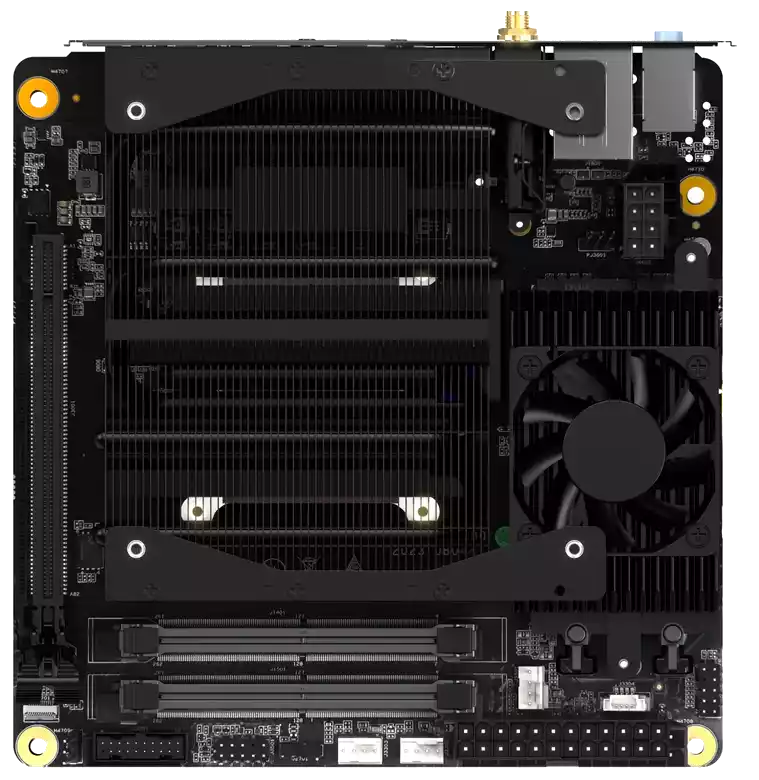
However, it’s important to consider the networking capabilities of the AR900i. With only a single RJ45 2.5G Ethernet port, users who need enhanced networking may have to invest in a PCIe 5.0 compatible NIC, potentially sacrificing the valuable high-speed slot that could be used for other high-performance components. This choice underscores the need to balance the motherboard’s impressive storage and expansion capabilities with networking needs. The AR900i represents Minisforum’s dedication to compact, high-performance computing solutions. With support for triple-screen displays up to 8K, built-in AX210 wireless card for WiFi 6E, and Bluetooth 5.3, this motherboard offers comprehensive connectivity options for a variety of uses, from gaming to professional creative workstations.
| Specification Category | Details |
|---|---|
| Processor | Intel® Core™ i9-13900HX, 24 Cores/32 Threads (36M Cache, up to 5.4 GHz) |
| GPU | Intel® UHD Graphics for 13th Gen Intel® Processors |
| Chipset | Intel® HM770 Chipset |
| Memory | DDR5 Dual channel (SODIMM Slots×2, up to 5600 MT/s, Max 64GB) |
| Storage | 4×M.2 2280 PCIe4.0 SSD Slots |
| Expansion Slot | PCIe 5.0 X16 connector ×1 |
| Wireless Connectivity | M.2 2230 Key E Slot |
| Video Output | HDMI2.0 ×1, DisplayPort1.4 ×1, USB-C ×1 |
| Audio Output | HDMI2.0 ×1, DisplayPort1.4 ×1, USB-C ×1, Line Out ×1 |
| Ethernet | RJ45 2.5G Ethernet Port×1 |
| USB Ports | USB3.2 Gen2 Type-C Port ×1 (Alt DP), USB3.2 Gen2 Type-A Port ×2, USB2.0 Type-A Port ×2 |
| I/O Ports | 4-pin CPU Fan header ×1, 4-pin System Fan header ×2, 4-pin SSD Fan header ×1, USB 3.2 Gen 2 header ×1, Front Panel Audio header ×1, System Panel header ×1 |
| Form Factor | Mini-ITX Form Factor (170x170mm) |
The Intel® Core i9-13900HX processor, with its 24 cores and 32 threads, is a powerhouse suitable for a DIY NAS setup geared towards enthusiasts and professionals requiring robust performance for tasks such as media transcoding, file serving, and hosting complex databases. The processor’s 36M cache and peak speeds of up to 5.4 GHz ensure that multiple operations can be handled efficiently, supporting a smooth and responsive network storage experience. The addition of Intel UHD Graphics for 13th Gen Intel® Processors also allows for hardware-accelerated video encoding and decoding, which can be a significant advantage for a NAS serving as a media server. In terms of memory, the system’s support for DDR5 dual-channel RAM, with speeds up to 5600 MT/s and a maximum capacity of 64GB, provides ample bandwidth and storage for running a NAS operating system along with any additional services. This is particularly important for a NAS that may be handling simultaneous data-intensive tasks. The four M.2 2280 PCIe4.0 SSD slots offer high-speed storage options, ideal for caching or fast data access needs, enhancing the overall performance and speed of the NAS.
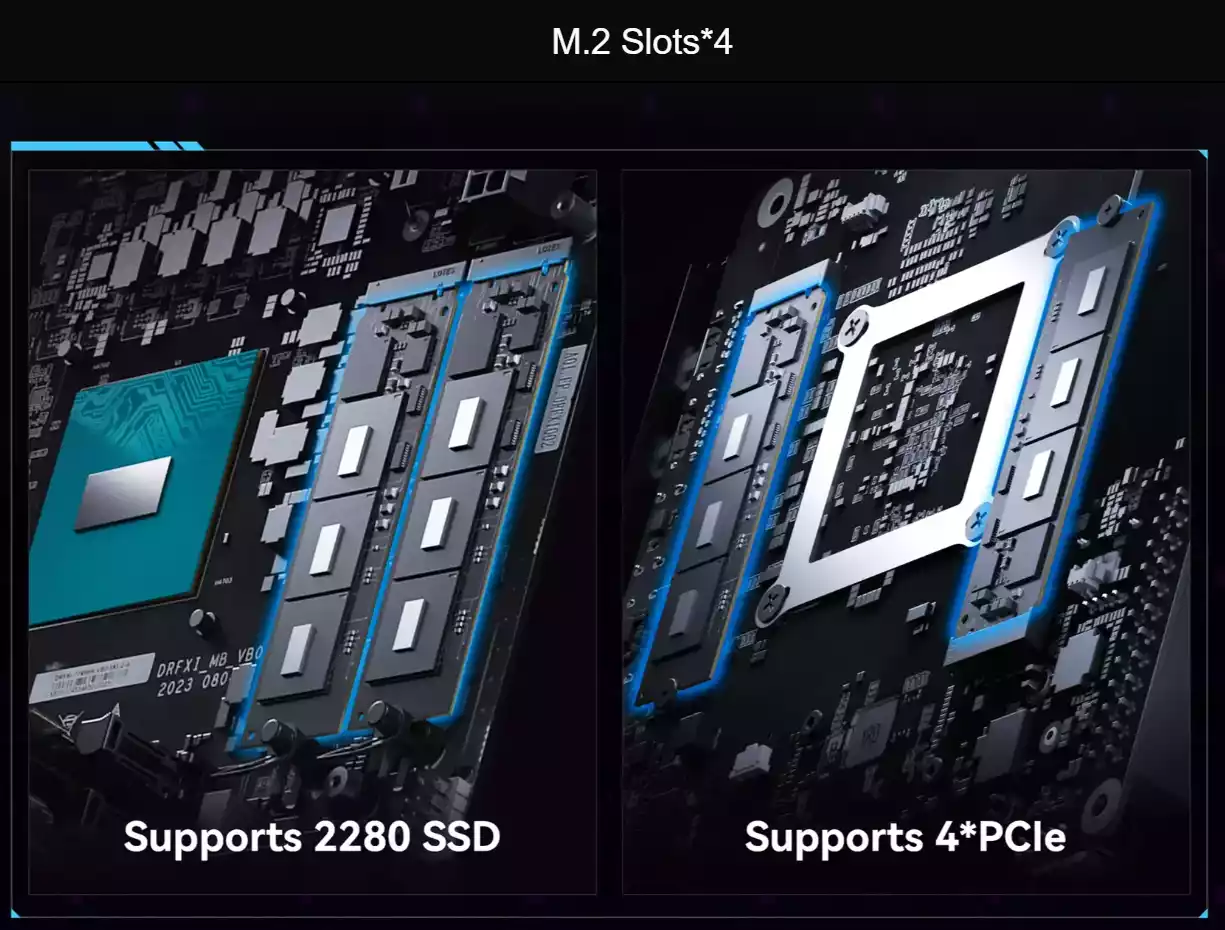
The connectivity options of this setup are also noteworthy. The motherboard’s Mini-ITX form factor is well-suited for NAS builds, where space efficiency is often a priority. The inclusion of a PCIe 5.0 X16 expansion slot allows for additional upgrades, such as adding a dedicated network interface card for improved network throughput or additional storage controllers if the four M.2 slots are insufficient. The onboard 2.5G Ethernet port provides a faster-than-gigabit connection, beneficial for transferring large files over the network. With a comprehensive range of I/O ports, including USB3.2 Gen2 and USB-C, the system can accommodate a variety of peripherals and external drives, making it a versatile choice for a DIY NAS setup.
| Where to Buy the Intel 13th Gen i9 The Minisforum AR900i CPU + M-ITX Motherboard Combo: |
Best Cheap CPU+MoBo+SSD+RAM Combo – The Topton N6005 CPU+Mobo Combo
Spec Highlights – Topton NAS Motherboard N6005, 4x Intel i226-V 2.5G Nics, Dual M.2 NVMe, Six SATA3.0, 2*DDR4 SODIMM, HDMI2.0, Mini ITX / M-ITX- $261 on AliExpress ($399 for 32GB DDR4 RAM and 1TB M.2 NVMe Included – see image below)
The Topton N6005 combo offers excellent value, combining an Intel Pentium N6005 processor, motherboard, 16GB RAM, and an NVMe OS SSD. Its popularity stems from its low cost and high performance, suitable for a variety of DIY NAS builds.
| Component | Specification |
|---|---|
| CPU | Integrated Jasper Lake Intel Celeron N6005 |
| RAM | 2x SO-DIMM DDR4 slots, up to 64GB (2400/2666/2933MHz) |
| Storage | 2x M.2 NVMe 2280 slots (PCIe 3.0 x1), 6x SATA 3.0 ports |
| Network | 4x Intel i226-V 2.5Gbps network interfaces |
| Form Factor | Mini-ITX (17.0 cm x 17.0 cm) |
| System Support | Microsoft® Windows 10/11 64-bit, Linux |
| Main Characteristics | – Matte Black PCB |
| – High-density moisture-proof fiber circuit board | |
| – Full protection (USB, audio source, network interface) | |
| GPU | Integrated Intel UHD Graphics (24EUs for N5105, 32EUs for N6005) |
| IO Ports | 2x USB 3.0, 4x USB 2.0, 1x HDMI, 1x DP |
| LAN | 4x RJ-45 2.5G NET |
| Additional Features | – Auto power-on, Wake-On-LAN, PXE support |
| Structure | Solid Capacitor Design |
Priced at $261 on AliExpress, and $399 when bundled with 32GB DDR4 RAM and a 1TB M.2 NVMe SSD, the Topton N6005 motherboard combo stands out for its affordability. This price point makes it an accessible entry for enthusiasts and professionals alike who are looking to build a high-performance NAS without incurring exorbitant costs. The inclusion of substantial RAM and fast NVMe storage in the bundle further adds to the value, offering what one might need for a robust NAS setup at a price that challenges many competitors in the market.
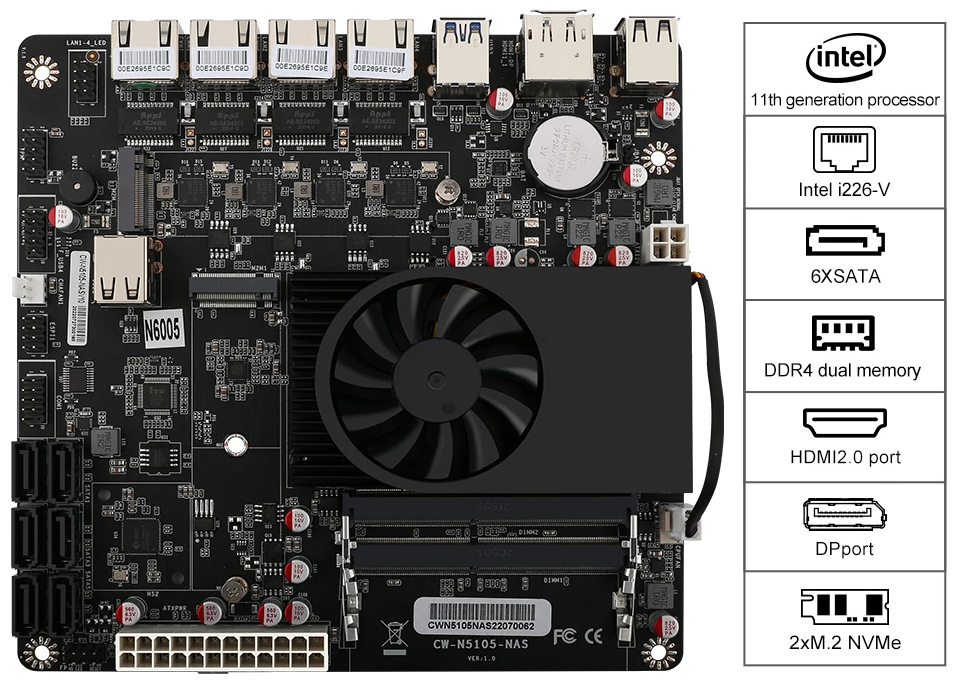
The CPU, an Intel Celeron N6005, is a Jasper Lake processor that strikes a balance between efficiency and capability. With a base frequency of 2.0 GHz and a burst frequency of up to 2.9 GHz across its four cores, it’s engineered to handle the multitasking demands of a NAS system. The 10W TDP reflects a design optimized for low power consumption, making it an economical choice for 24/7 operation, a critical consideration for NAS systems which are expected to be always on.
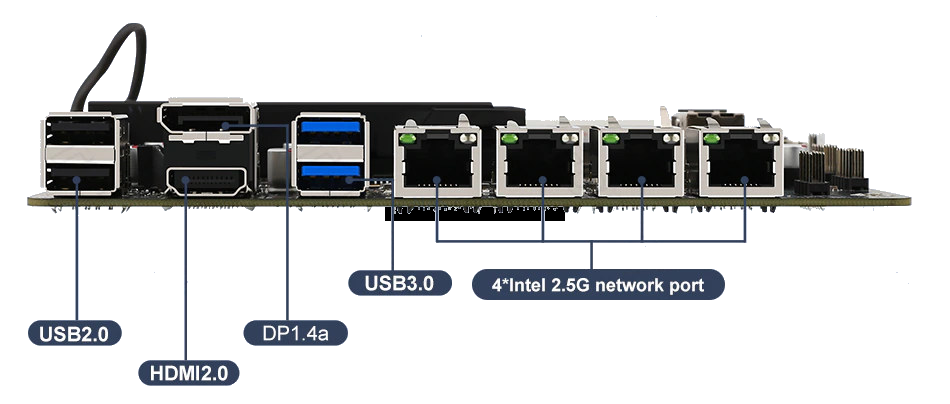
On the storage front, the Topton N6005 shines with two M.2 NVMe PCIe 3.0 x1 2280 slots for high-speed data transfer and six SATA3 6Gb/s ports for ample storage capacity. This allows users to install fast NVMe drives for the operating system and frequently accessed files, while the SATA ports can host larger hard drives for bulk storage. Such a combination is perfect for a NAS system, providing quick access to data and large storage pools for backup, media libraries, or network file sharing. If you are considering the Topton N6005 CPU+Motherboard combination for PLEX Media Server, I made a dedicated video on this using this CPU/Mobo in the Jobsno N2 NAS Case below, testing 4K Multimedia:
The Topton N6005 has garnered popularity among NAS builders for several reasons. It offers a mini-ITX form factor, which is ideal for compact builds, and includes four 2.5Gbps Intel i226-V network interfaces, enhancing its functionality as a home or small office server. Additionally, the CPU’s support for up to 64GB of DDR4 RAM means it can handle more demanding NAS tasks, such as running virtual machines or hosting databases. These features, coupled with its energy efficiency and expandability, make the Topton N6005 a sought-after component for building versatile and powerful NAS systems.
| Where to Buy the TopTon N6005 Motherboard |
Disclaimer – The Jonsbo N1, N2 and N3 are STILL the Best NAS Enclosures
Jonsbo’s range of NAS enclosures stands out as an industry benchmark for those keen on custom desktop NAS builds. These enclosures seamlessly blend aesthetics with functionality, showcasing a meticulous design ethos that addresses both the visual and technical demands of modern users. The build quality is exceptional, employing high-grade materials that not only ensure durability but also aid in efficient heat dissipation, a critical factor for continuous NAS operations. Furthermore, Jonsbo has consistently demonstrated a forward-thinking approach by incorporating features that cater to future expansion and adaptability. Their user-friendly design ensures easy installation and maintenance, making them a preferred choice for both novices and seasoned builders. Backed by positive user reviews and a reputation for reliability, Jonsbo NAS enclosures are, without a doubt, one of the best investments for those aiming to craft a high-performance, custom desktop NAS system.
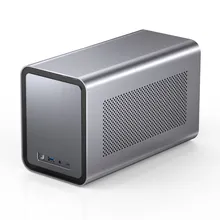 |
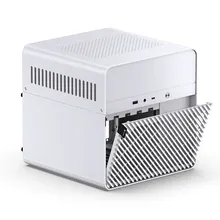 |
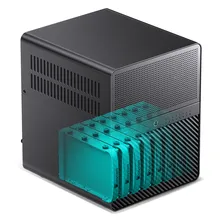 |
| Jonsbo N1 5/6 Bay
Price (9/23) – $96 |
Jonsbo N2 5/6 Bay
Price (9/23) – $89 |
Jonsbo N3 5/6 Bay
Price (9/23) – $92 |
Recommended Add-ons and Extras to Remember for Your DiY NAS Build
Building a NAS involves more than just the CPU and motherboard; enclosures, memory, PSUs, and other accessories are essential. Future guides will detail these components, alongside recommendations for smaller, crucial accessories to enhance your DIY NAS server’s functionality.
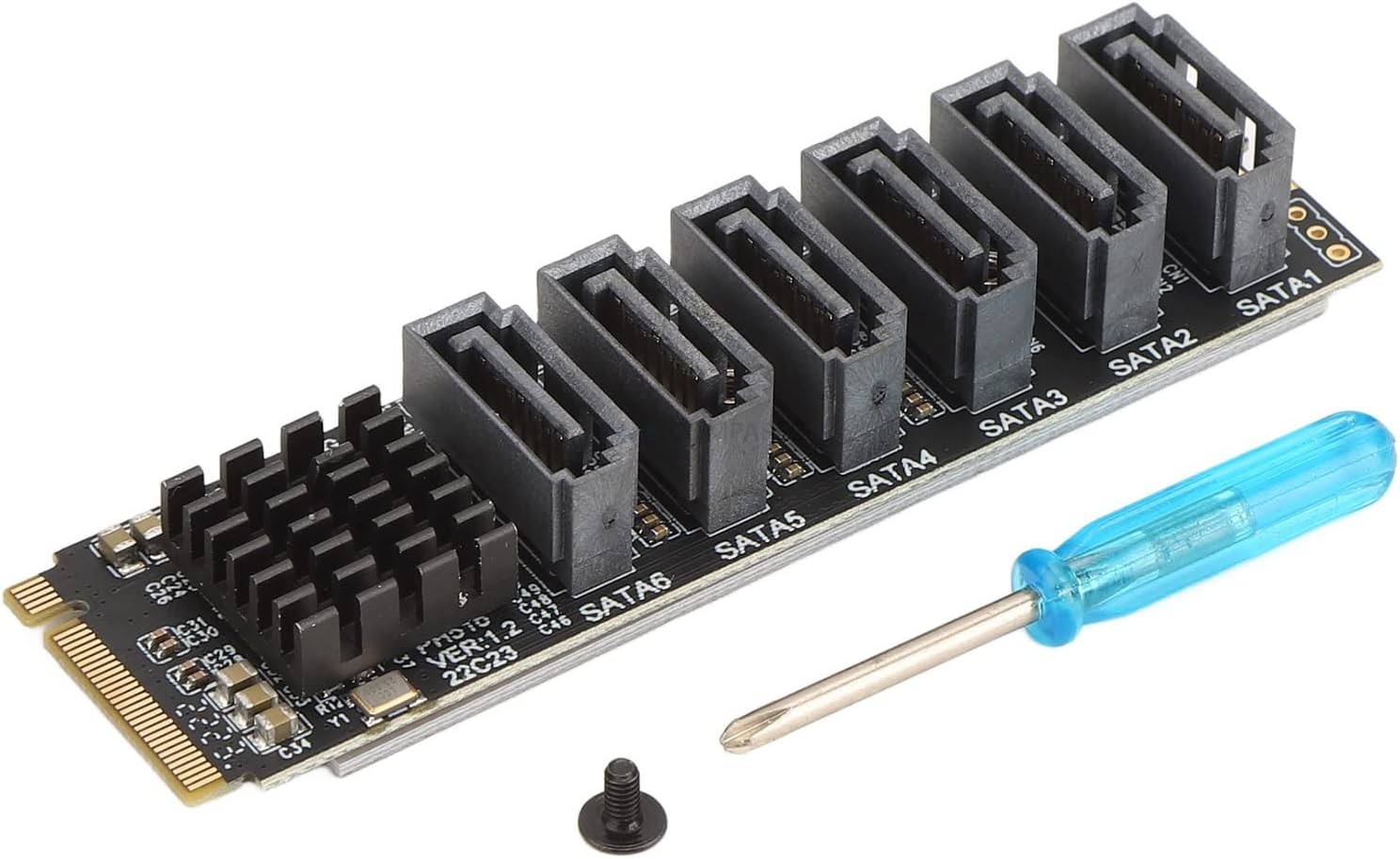
M.2-to-6xSATA Adapter ($10-15) – HERE on AliExpress or HERE on Amazon.com
PCie Card to Add 4x M.2 to Your Mobo $20-50 (Check Lane/Speed of Mobo and Compatibility First) – HERE on AliExpress or HERE on Amazon.com
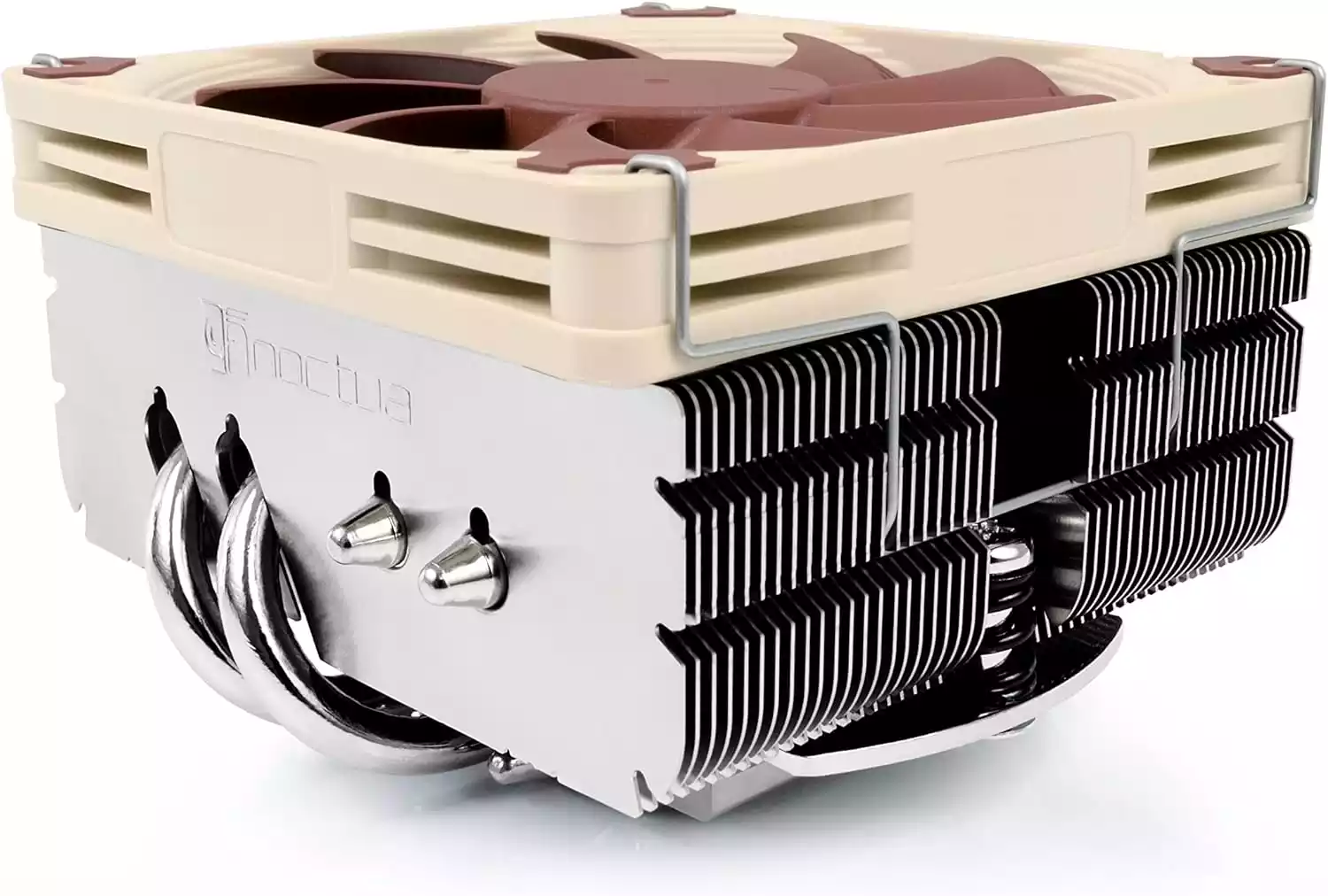
Compatible CPU Cooler (CPU Dependant) $25-50- HERE on AliExpress or HERE on Amazon.com
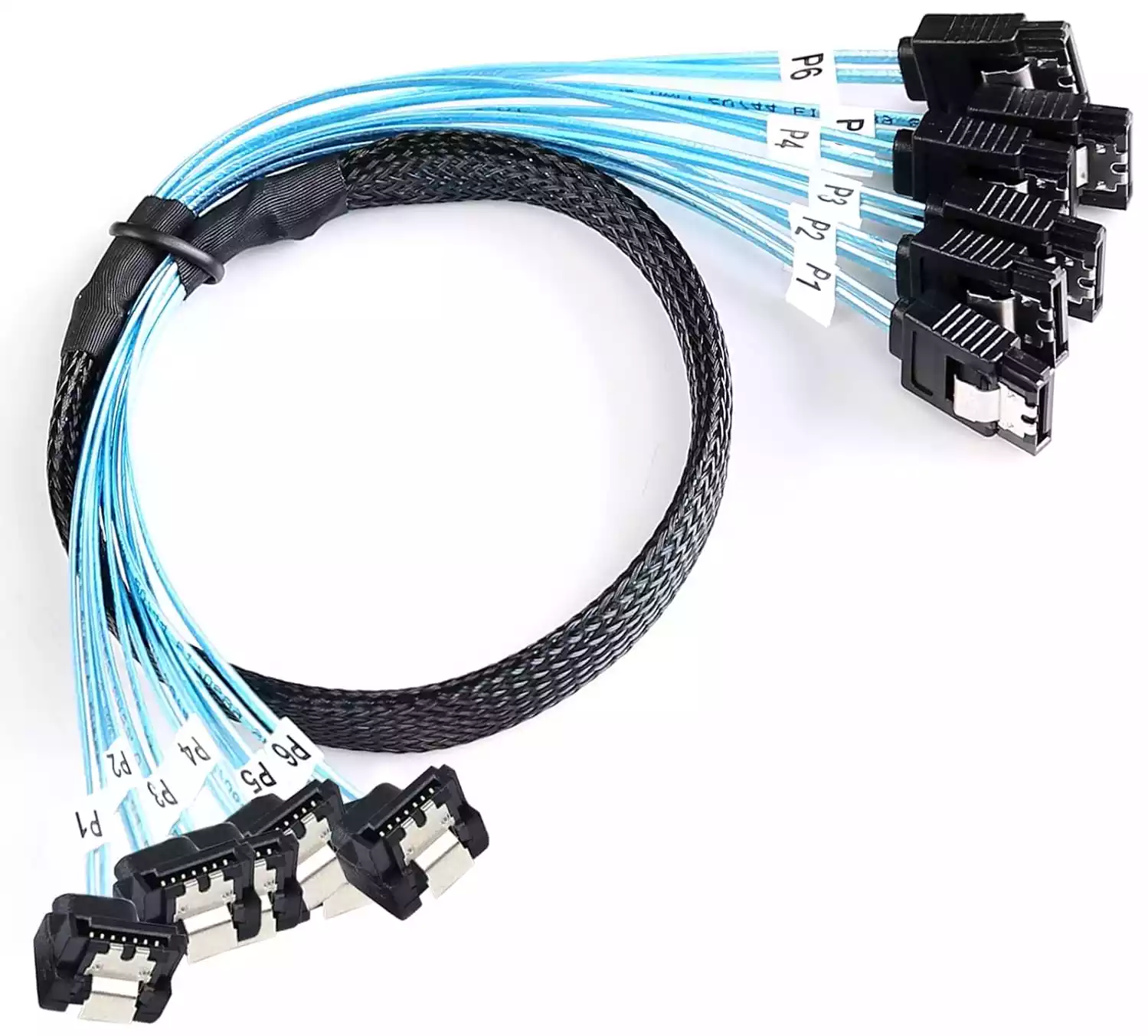
SATA Fan Out Cable – HERE on AliExpress or HERE on Amazon.com
Here is our article on the BEST (and worst) NAS Enclosures and Cases you can find on AliExpress for your DiY NAS Build. Click the banner below to read the article, alternatively, you can watch the detailed video HERE. Alternatively, you can watch a video on the best and worst NAS enclosures on Amazon here instead.
📧 SUBSCRIBE TO OUR NEWSLETTER 🔔 This description contains links to Amazon. These links will take you to some of the products mentioned in today's content. As an Amazon Associate, I earn from qualifying purchases. Visit the NASCompares Deal Finder to find the best place to buy this device in your region, based on Service, Support and Reputation - Just Search for your NAS Drive in the Box Below
🔒 Join Inner Circle
Get an alert every time something gets added to this specific article!
Need Advice on Data Storage from an Expert?
Finally, for free advice about your setup, just leave a message in the comments below here at NASCompares.com and we will get back to you.
 Need Help?
Where possible (and where appropriate) please provide as much information about your requirements, as then I can arrange the best answer and solution to your needs. Do not worry about your e-mail address being required, it will NOT be used in a mailing list and will NOT be used in any way other than to respond to your enquiry.
Need Help?
Where possible (and where appropriate) please provide as much information about your requirements, as then I can arrange the best answer and solution to your needs. Do not worry about your e-mail address being required, it will NOT be used in a mailing list and will NOT be used in any way other than to respond to your enquiry.
TRY CHAT
Terms and Conditions


A Buyer's Guide to Travel Routers - GET IT RIGHT, FIRST TIME
Jonsbo N6 DIY NAS Case Review
The Best Bits (and Worst Bits) of NAS of 2025!
Minisforum MS-02 Ultra Review
Minisforum N5 NAS, 6 Months Later - Better, Worse, the Same?
Beelink ME Pro NAS Revealed
Access content via Patreon or KO-FI
Discover more from NAS Compares
Subscribe to get the latest posts sent to your email.


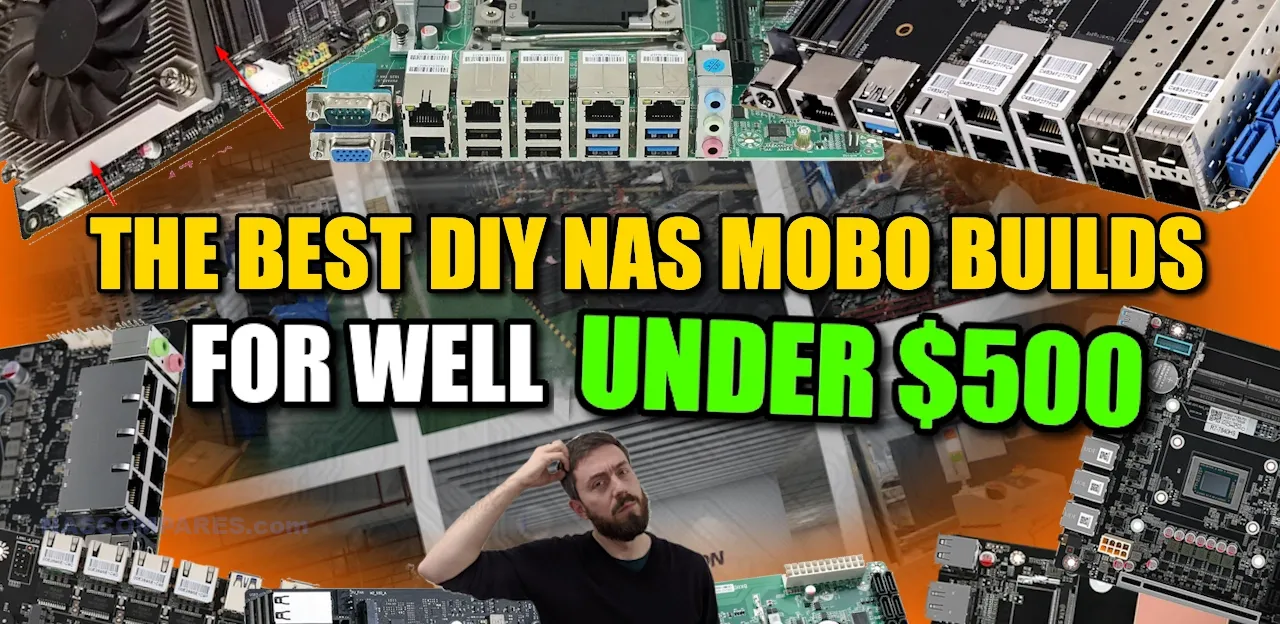
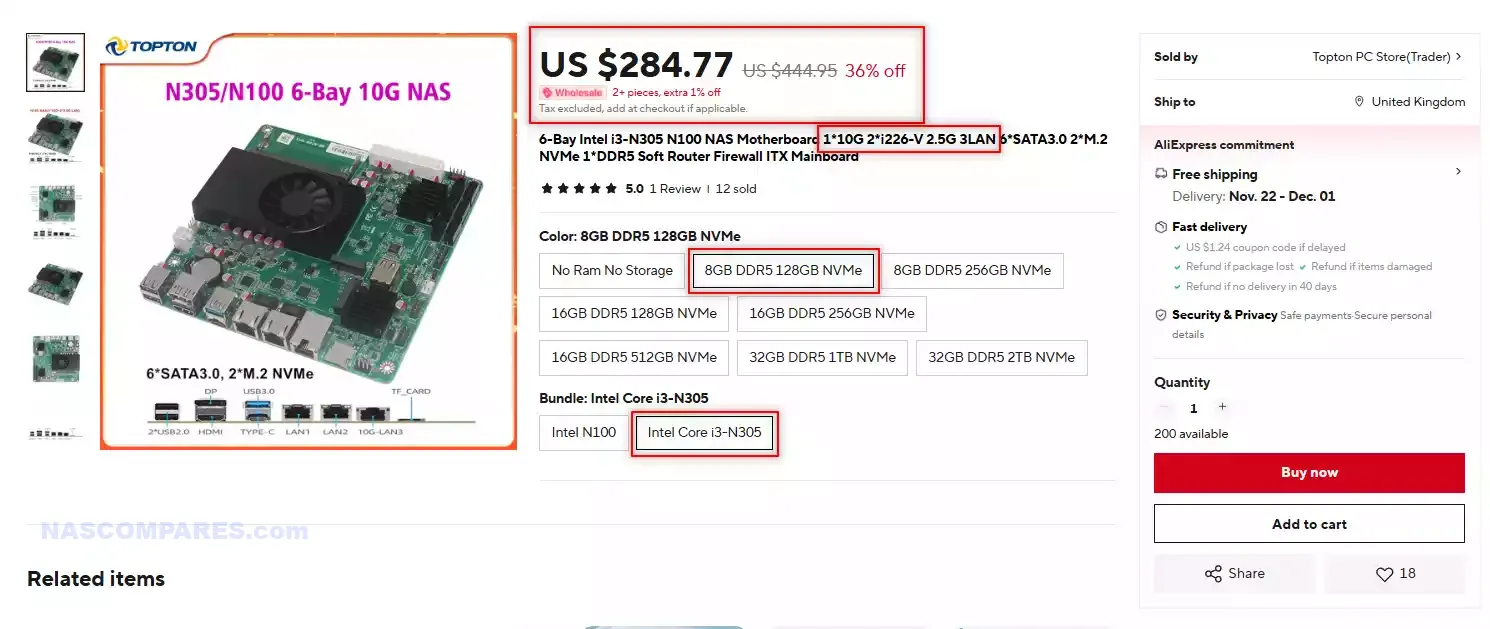
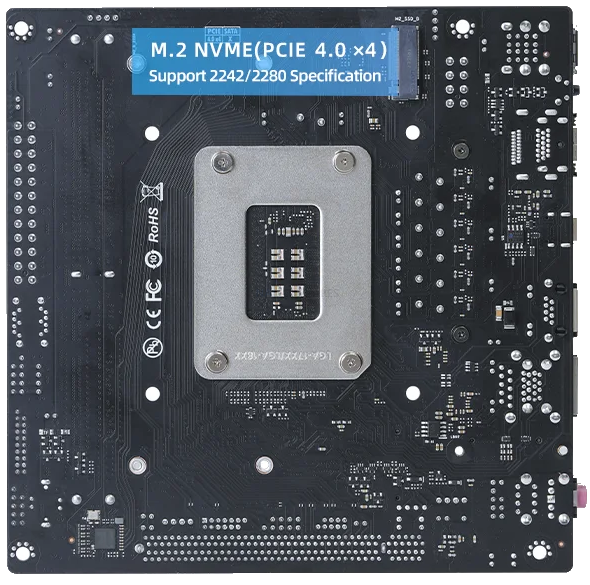
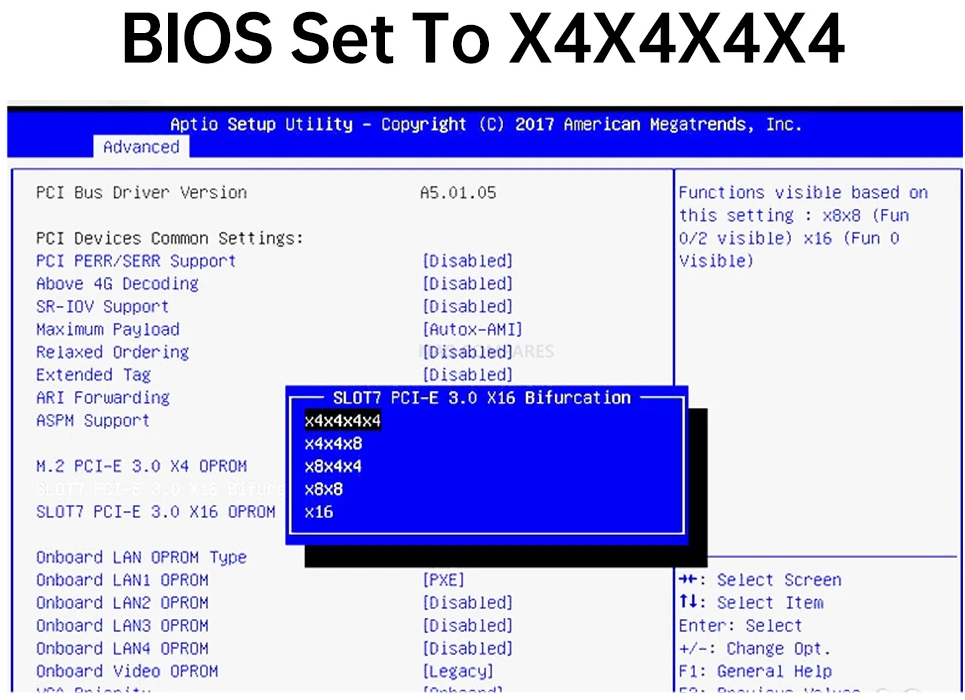
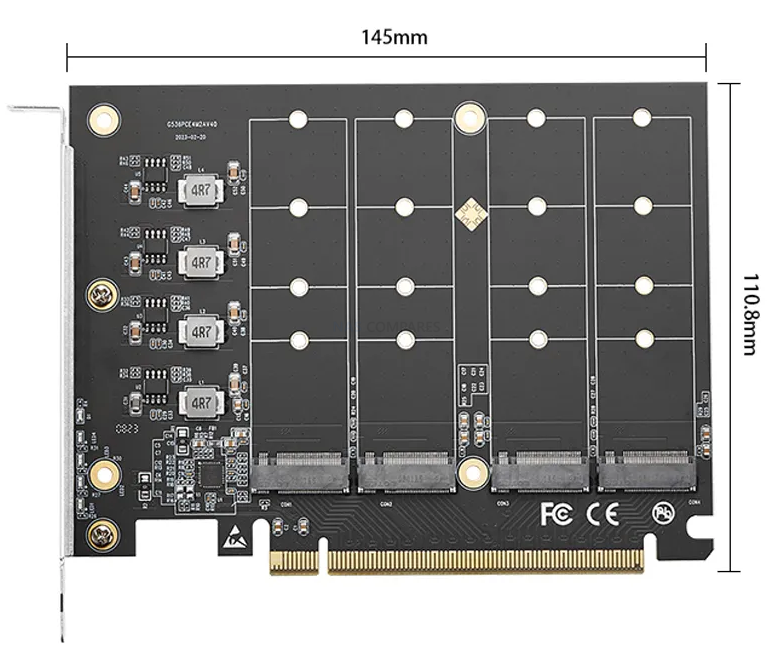
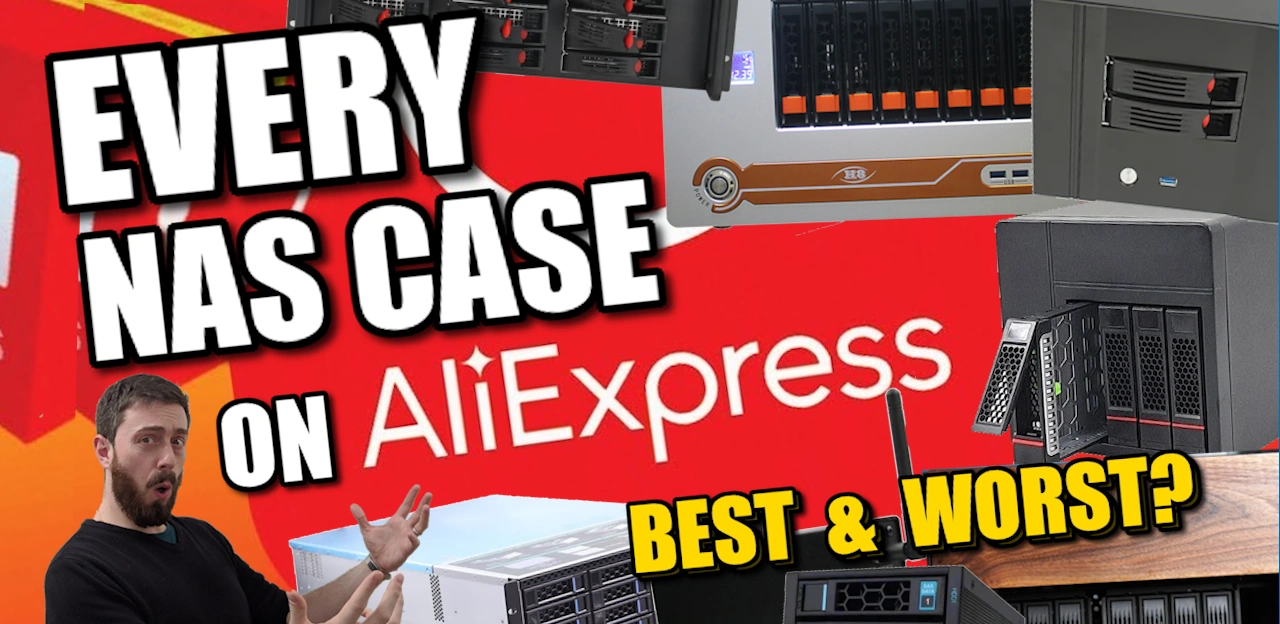



perfect for a 8700g build with stock fan, if you are like me and hoard a lot of videos and anime and game as well
REPLY ON YOUTUBE
I’m interested in comments from other N2 builders – what did you do with the rear case fan and connection?
I found the connection on the SATA back plane spun the fan up to 100% creating a lot of noise, even with a Noctua 12×15. I ended up threading it through to the mobo sys fan header which brought the noise down considerably.
REPLY ON YOUTUBE
Jonsbo is not that good, not enough drive space
Can’t be a good NAS channel if you’ve never heard of the brands also begging the companies for free stuff.
REPLY ON YOUTUBE
I think those are USB 2 connectors on the motherboard . If you connect those others to it with adapters they will be very slow .
REPLY ON YOUTUBE
Reached out to CWWK for recommendations on ECC memory for the CWWK 8-Bay / 9-Bay Board AMD-7735HS/7840HS/8845HS/7940HS, and this is their response: “Hello, sorry. This motherboard can support ECC memory, but it cannot utilize the ECC function. We suggest that you simply use regular memory.” ☹
REPLY ON YOUTUBE
So the video is just looking through amazon and propaganda, not actual hands on testing.
REPLY ON YOUTUBE
sagittarius 8 bay should be the best. It has a standard PSU size and matx motherboard with plenty of airflow. Both Jonsbo n2/n3 uses ITX motherboard which is not ideal for NAS.
REPLY ON YOUTUBE
So did you ever find adapters to connect the case front panel stuff to the TopTon board? I’ve been looking for some and haven’t found anything yet.
REPLY ON YOUTUBE
wir fahren fahren fahren auf der autobahn… ????
REPLY ON YOUTUBE
This really is a great video! Very detailed for how to build a NAS. Unfortunately the cost of the case and the MOBO has risen to the point now that it is no longer a feasible alternative for me to build a NAS. I can buy a UGREEN 2 bay NAS cheaper than what all the parts needed to build the fully operational unit. Possibly the price points of the individual components will fall in price and make it feasible again. CWWK’s MOBO appears to be declining in price which would be an option. Thanks for this instructional video!
REPLY ON YOUTUBE
I bought a Ugreen NAS a few weeks ago and I’ve been trying to set it up for syncing, media server and a game server. But even these simple tasks are causing problem after problem. If one more thing goes wrong I will return it for a full refund.
Can I expect the same problems on a home built device running a more tried and tested OS?
REPLY ON YOUTUBE
I’d love to see an updated version of this, I’m considering the 4800 plus or DIY… it’ll no doubt drop again to 479 on the green, it seems to every other month lol, so prime day ‘deal’ is budget at 479, can we do better DIY??
REPLY ON YOUTUBE
Great video, however the case does have standard usb 3.0 and usb c connectors, the issue is the motherboard
REPLY ON YOUTUBE
I’ve been looking for a ITX MB that supports 8 sata ports and has a pcie slot
REPLY ON YOUTUBE
Thanks!
REPLY ON YOUTUBE
Nas playing at the beginning is too good ????
REPLY ON YOUTUBE
thanks
REPLY ON YOUTUBE
I highly value the joy of learning how to do this and then doing the assembly of the NAS. For me. Invaluable.
REPLY ON YOUTUBE
i still dont know how is this a 6 bay casing?
where is the 2.5″ placed?
i watched like 10 of N2 build videos nobody 4kin ever put in a 2.5″
weird shit
REPLY ON YOUTUBE
always build the entire system on a table to make sure everything is working before placing them into such a tiny and troublesome casing
REPLY ON YOUTUBE
i never get why is it so hard to release a diy NAS case?
they already have so many 5 bay DAS
just make a bigger one with empty slot for a mobo
jeez
REPLY ON YOUTUBE
2:55 ????
REPLY ON YOUTUBE
Now that Bezos has turned fascist, I will try to buy from a local reseller. And I propose everyone does that.
REPLY ON YOUTUBE
Excellent vid. Very detailed. I like the case.
REPLY ON YOUTUBE
CWWK 12th Gen i3-N305 N355 N100 N150 2*Intel i226-V 2.5G NAS Motherboard 6*SATA3.0 6-Bay Soft Rout 1*DDR5 4800MHz Firewall ITX Mainboard…. where can i get the manual to view the front panel connections?
REPLY ON YOUTUBE
wait is this all itx? welp was hoping for atx matx too
REPLY ON YOUTUBE
Topton has no quality whatsoever, I bought it from Aliexpress and threw my money away, they didn’t accept the return of the product or give me my money back and there’s no repair. Friendly advice, don’t buy this crap.
REPLY ON YOUTUBE
BE CAREFUL WITH TOPTON PRODUCTS, TOPTON COMPUTER, TOPTON LAPTOP, TOPTON MINI-PC, TOPTON NOTEBOOK, THEY ARE POOR QUALITY PRODUCTS AND THERE IS NO TECHNICAL ASSISTANCE OR TECHNICAL SUPPORT AND ALIEXPRESS IS NOT RESPONSIBLE FOR ANYTHING.
REPLY ON YOUTUBE
new interesting one is the Sagittarius 8-bay on AlieExpress
REPLY ON YOUTUBE
People marking down the PCIe on the NVMe slots being “only” PCIe 4.0 x 2 is dumb. Like dude your going to be limited to 10Gb speeds in most cases which PCIe 4.0 x2 is 4GB/s before overhead 10Gb is 1.25GB/s your fine even 40Gb is only 5GB/s which still makes a 40Gb NIC worth it if you need that much bandwidth, realistically your gonna top out at 3.6 – 3.8GB/s assuming no other limitations on NVMe over PCIe, but Ethernet has it’s own overhead, which is actually somewhat larger.
But when 1 of your 2 NVMe slots can get pretty close to maxing out a 40Gb connection, your doing fine. Would it be nice to have PCIe 4.0 x4 or PCIe 5.0 x2 sure, but it’s 4.0 x 2 is really enough to be getting along with especially considering the onboard networking, it’s way more than enough.
Personally though, 1Gb is ethernet is good enough for me and 2.5Gb is plenty so a couple of 2.5Gb ports is plenty, and PCIe 3.0 x2 or PCIe 4.0 x1 is enough to be getting along with.
REPLY ON YOUTUBE
Ehhhh, 4x 2.5Gb… I really would prefer just 1x 10Gb, maybe 1x 10Gb and 1x Gb or if your feeling fancy a 2.5Gb port considering 2.5Gb really isn’t any much expensive to implement. and switches exist, I would much prefer to have 1x 10Gb and buy a switch with a few of 10Gb ports and a bunch of 2.5Gb ports.
REPLY ON YOUTUBE
Looking at building this a year later and it’s more than twice expensive now. And the mobo isn’t available.
REPLY ON YOUTUBE
Mo Data Mo Problems hahaha a Puff Daddy pun in this day and age???? yuck!!! I’m about to “Freak Out” jk
REPLY ON YOUTUBE
U-NAS is interesting …. but a pain to import 😐
REPLY ON YOUTUBE
I love seagulls ????
REPLY ON YOUTUBE
N305 version is nowhere to be found now. Its not available or its at least double the price of N100
REPLY ON YOUTUBE
I have a basic NAS for home use and I am wanting to experiment with Freenas, Proxnox etc, I just bought a Chinese motherboard (C612) with a 14-core (xeon 2680V3) 32Gb of ram and 5 ports the 2.5Gb.
I want to learn how to install and configure virtual servers with it
REPLY ON YOUTUBE
bro you are not MrBeast, if you want to do multi-language audio just hire some fucking voice actor, and not IA shit robot, it’s UNWATCHABLE
REPLY ON YOUTUBE
If you are getting the N17 please be the canary and put some udimm ecc in and let us know if it works. N17 looks great but if going to drop £300 (2x32gb) on ram want to know its going to work. Thanks for reviews awesome work ????
REPLY ON YOUTUBE
I know I’m a year late, but fantastic walkthrough – inspired me to build one myself! Subbed and will dive deeper down this rabbit hole, thank you!
REPLY ON YOUTUBE
I bought a Topton computer on Aliexpress and I was so angry with myself, it was a poor quality product, without technical support, it was money thrown away. If you want some advice from a friend, look for another brand.
REPLY ON YOUTUBE
Any of them have AV1 encoding?
REPLY ON YOUTUBE
Do you have any non-Chinese recommendations? I’m worried about having to waste time trying to deal with returns, documentation, and debugging. Willing to pay a couple hundred extra as a premium.
REPLY ON YOUTUBE
Is this just an coincidence that he got the same background as Alex on Autos? ????
REPLY ON YOUTUBE
For me it’s CW-NAS-ADLN-K N100 purple mobo. I bought it for 148 USD (without VAT) including JONSBO CPU cooller. It has 2xI226-V, 2xminiPCIe 3.0 (x1) 1xPCIe 3.0 (x4), 6xSATA (ASM1160). Suggestion is to add 0.5 mm thermal pad between CPU die and heat spreader. The only question is what PSU to use with this low powered mobo for six 3.5″ HDD. I’m thinking about Chinese pico PSU, but they have bad amperage on 5V rail. Six 3.5″ HDD can require up to 8A on 5V rail during spin-up.
REPLY ON YOUTUBE
Loved your vid, TrueNAS is a bit sketchy to first setup but does it job after a while of tinkering. The 6 port sata controller based on the ASMedia 1166 chipset is the way to go? Works great with TN instead of the JMB585… Don’t cheap out on that one. I used a PCI x4 card, neater and cleaner with cables. And btw, for the money and quality of parts stop using the Ali bords and just buy an Asus N100 or something… Good bios, great hardware and you can support local or national companies
REPLY ON YOUTUBE
I don’t think you look ill, but I also don’t think Bananaman has aged well. Does the mask still fit?
REPLY ON YOUTUBE
Question, how do i know what mobos, cpus and hba cards support c states?
REPLY ON YOUTUBE
Crazy town, banana pants is my new go to saying for anything awesome from now on! Let’s get that to go covid viral everyone!
REPLY ON YOUTUBE
The trouble with mATX motherboards and such is they don’t fit into many (if any) NAS enclosures you can buy. I ended up buying an 8bay NAS enclosure with the motherboard thats pictured on your right (off aliexpress). The only other bits and bobs I had to get was a small ATX Flex power supply to suit the enclosure, couple sticks of memory 2x8GB), two 4xSATA to SFF cables (to go from the backplanes to the mobo) and a fan splitter cable. Unfortunately it’s still sitting in the office to put together LOL
My reasoning with the N5105 board was the 6 SATA, 2xNVME, 4×2.5GB ports. Sure it’s only got 4 cores/4 threads but then again, so do a lot of QNAP and Synology NAS’. And with a case I never have to change, I can change out the Mobo in a few years time when other’s get cheaper and better spec’ed. The one downside to purchasing anything off Aliexpress is the lack of documentation.
I think the biggest cost in the whole project is the case – due to it’s physical size. Shipping to AU was in the $100 mark alone. You can buy almost complete kits (Case, Mobo, PS, memory etc) from the one seller. In my case, it was slightly cheaper getting the case and Mobo sent from China and getting the rest local.
REPLY ON YOUTUBE
So many strange limitations. Why? B450+APU If you dont want nvme Nas, or Ryzen 3100 or higher with B550 board can deliver you +4 m.2 through bifurcation card – you can use it for nvme Nas or to connect +4 strange adapters for m.2 that you like, 10gbe lan etc. To low power consumption you can play with cpu tdp in BIOS and use picoPSU or HDPLEX. And if you make a little research, you can even use ECC memory
REPLY ON YOUTUBE
Great video! After the £1300+ NAS it is nice to see some cheaper options. I liked the look of some of the cheap Aliexpress cases until I saw the shipping cost.????
REPLY ON YOUTUBE
I would be really interested in a comparison of Intel vs AMD comparison for video transcoding. i know quicksync is king… but what performances can you expect from an AMD CPU? not everyone needs multiple 4k videos being transcoded at all times, so if the AMD CPUs would handle 1 or 2 videos transcoding, then that would open up the choises of CPU for a lot of people…
REPLY ON YOUTUBE
Be interested to see what you can when buying from UK retailers.
REPLY ON YOUTUBE
Wow, great timing! I bought a Ugreen dxp4800 plus and have been running with hot temps (don’t seem uncommon). I recently got a 15U server rack and might be interested in building a rack mounted server and selling the Ugreen so I’m excited for the video you’re planning on doing with the rack server build!!
REPLY ON YOUTUBE
Chinese trade tariffs for US consumers could be great for us on the other side of the pond. Faced with higher US tariffs and likely lower US demand the Chinese will choose to sell more in Europe, pushing prices down for Europeans / Brits. Thank Trumpy ???? !
REPLY ON YOUTUBE
Honestly I think you’ve beat the low DIY end to death,. What are the high end DIY options?
REPLY ON YOUTUBE
The Qotom board with Atom C3000 cpu has build in SFF8087 connector that you probably missed so it gives you 4 + 2 on board sata. STH did nice review of it under the name of a Everything Fanless router
REPLY ON YOUTUBE
Great video! Can you review the CWWK N100 purple board? I’m curious because it uses ASM1166 controller instead of the more common JMB585 controller.
REPLY ON YOUTUBE
Great info in this vid again. I have been going over a lot of your videos because I’m looking into making a server/nas with 12x 12tb drives and 4 x pci 3 m.2 2tb, My use cases: long term storage, backup family of 6 data from phones and tablets, few vm’s, plex, steam cache, downloads and more. I do have a x570 mobo with a 5900x in a box but it doesn’t have ecc and uses a lot of power prob. Just finding a board that can handle all that is a little tricky for a decent price with 10gb. Keep up the great work looking forward to all the future videos.
REPLY ON YOUTUBE
As an idea for a future video, look into RockStor OS and compare it against OMV, specifically focussing on the use of encrypted BTRFS partitions.
REPLY ON YOUTUBE
Why not the q670 white? Just came out and looks very promising. Also, would love if aspm c-states was discussed more here.
REPLY ON YOUTUBE
overpriced, underpowered, too lacking in resources
REPLY ON YOUTUBE
I run my Unraid server with a B450 motherboard and a 5600G. In hindsight I should have done with Intel for the quicksync support but it’s done well to host my Jellyfin server and do transcoding.
REPLY ON YOUTUBE
Are any of these capable of gaming like what was shown by Asustor with the Flashstor gen 2 using iscsi at Computex?
Would I be able to build an nvme nas capable of gaming for a price competitive with the Flashstor gen2?
REPLY ON YOUTUBE
What I’ve learnt from the years of building NAS and homelab, you don’t need to go for ITX unless your space is really limited, going MATX or even ATX really remove lots of your problems, like limited SATA, PCIE slot or IO, and remember in a NAS system, most of power consumption are from your HDD, it matters very little your CPU TDP is 15W or 45W.
If you worry about the case, most of 8 bay or even some 6 bay NAS cases can support MATX now, and you can just use a mid tower PC case if you don’t care about the look.
REPLY ON YOUTUBE
I just grabbed the other day the n17 with 7840s…building my first Nas for plex in a Jonsbo N2 case…my only worry is that the ram is limited to 4800mhz. If someone would want to use transcoding in plex/jellyfish as AMD is not always supported/for working for now. intel a310 eco from sparkle is a great piece as its low profile and single slot
REPLY ON YOUTUBE
I bought a TOPTON computer on Aliexpress and I don’t recommend it, it’s a disposable and maintenance-free product. I don’t recommend it either.
REPLY ON YOUTUBE
Yeah I love U-Nas but they never seem to be in stock UGH!
REPLY ON YOUTUBE
I bought a Topton computer and threw my money away, it is a low quality product, without technical support. Friendly advice, look for another brand.
REPLY ON YOUTUBE
I am still thinking to made by your guide around 300-350£ or buy Synology 423+ different 100-150£ + good warranty , quality .
REPLY ON YOUTUBE
As a noob with 4x 4tb nvme drives and only basic knowledge, what would you recommend for me?
I don’t care about crazy speeds, i just don’t want to have all of these connected to my PC with a bunch of usb cables and the storage separated by drives.
Also, would i just hook the nas up to the wall and plug it to my spectrum router?
REPLY ON YOUTUBE
45:26 …what did you spill onto your fan cover filter? The world wonders.
REPLY ON YOUTUBE
I miss what is wattage usage of this setup .
REPLY ON YOUTUBE
You FAILED, I can buy used HP Z800 with 128RAM 2x XEON, for 300Eur. I is way better then any china crap you have here, the Synology or QNAP is even more overprices china crap.
REPLY ON YOUTUBE
6:20 You have seen nothing. I once received a server power cable packed in a box which was larger then the case box on your desk. Bit shorter but much wider. It was also packed in all kinds of bubble wrap. A fricking standard power cable! ????
REPLY ON YOUTUBE
Its xpenology compatible?
REPLY ON YOUTUBE
Cavity is not the same as a hole. Cavity is empty enclosed space, like a mini cave.
What you call cavities are simply holes or openings.
REPLY ON YOUTUBE
I just purchased a NAS case on Aliexpress for $772 with delivery absolutely insane but it’s completely CNC aluminum and has 10 nvme capable bays. The X-nas chassis. Looks cool so I bought it. Filling it with a Single AMD EPYC CPU 256GB ram and a few 8TB U.2 drives and 100GbE.
REPLY ON YOUTUBE
my Synology 215+ still going strong after almost 10 years lol. even gets updates.
REPLY ON YOUTUBE
Horrible overrated case (good video though). What if you want to put SSD drives in those drive bays without drive trays? Doh!!
REPLY ON YOUTUBE
I need ECC, 10Gb, Quick Sync, mini itx
REPLY ON YOUTUBE
I have the AUDHEID case and it’s awesome. I wouldn’t buy it though because the Jonsbo N4 black is available now and it’s 100 dollars less and nearly identical and the differences are all upgrades unless you need 8 bays.
I had a 1U psu to put into the AUDHEID and did a 6x8tb RaidZ2 with 2x250gb ssd for vms and M.2 for boot and 1 for Cache. It’s hard to find all that in a prebuilt.
Prior to this I had the Fractal 804 with 8x4tb which is also good but I had issues with hanging drives and the sata cables and it was just huge.
REPLY ON YOUTUBE
I have an ex2 by WD. It’s time to increase my capabilities. I was going to build an old pc and fill it with hdd. This is a great option.
REPLY ON YOUTUBE
Great review, you will save alot of people countless hours money and effort to find this info out
REPLY ON YOUTUBE
AMD AM4 boards do support ECC. Take a look at the ASRock B550M-ITX/ac. It supports ether a 16 or 32 Gb dimm.
REPLY ON YOUTUBE
So you get the unraid license for free? So your nas cost hundred bucks more. And it is an Motherboard and a io shield.
And proxmox is a hypervisor and has absolutely nothing to do with network attached storage.
REPLY ON YOUTUBE
thank you
REPLY ON YOUTUBE
Yo what’s that track at the beginning???
REPLY ON YOUTUBE
i found silverstone cs 351. i think i’m gonna build my nas on it. small, micro atx, and 5 3.5″ bay with individual key lock. perfect.
REPLY ON YOUTUBE
you still can use some silverstone sugo and turns 5.25 bays into 6×2.5 bays with key lock. the silverstone sugo sg14 in addition with ToughArmor MB996SK-6SB
REPLY ON YOUTUBE
@10:43 6 bays are the best you can make a 5 discs raid and still having an hot spare. beyond 6 bays drive are expensive, case is big, and motherboards are hard to found.
REPLY ON YOUTUBE
i thought you were nice but lot of chineses nas manufacturers are banrupt after this video ????
super funny and very great tips. especially what i love about your channel is that you care about budget, you don’t simply recommend the most expensive tools out there.
findind theses rare gem is an absolute hard work, and your 50 tabs opened here are just the surface of the iceberg ^^
REPLY ON YOUTUBE
i purchasse a jonsbo tk1 on ali express, waited for 6 month, and right after i received it, it turned popular and available in any tech website in europe.
REPLY ON YOUTUBE
@1:10 someone at ali express brainstorming “he needs a nas case, show him the some fake fingernails” everyone else “oh yeah great idea boss”. it’s because of the automatic translation, you can’t use the website in its original language and even if you could, you should provide your request in chinese i guess.
REPLY ON YOUTUBE
Thanks for making this video. I’ve ordered all the bits and pieces to put a Jonsbo N2 NAS together.
REPLY ON YOUTUBE
I recently put together a DIY NAS – I used a Normal Antec P101 Silent case. It has 8 bays internal and lots of ventilation, and cost me AUD$159 = GBP83
REPLY ON YOUTUBE
Soooo… For mATX tried and true Node 804 from Fractal it is 🙂 Half the price of the AliExpress ones (factoring shipping costs) and available locally.
REPLY ON YOUTUBE
One solution for mITX+ECC+new gen CPU is AM4 Ryzens offering paired with B450/B550 mITX boards, or even A520 (preferably ASRock or ASUS, as they report the best ECC support). When paired with Ryzen PRO G series APUs, you get the iGPU that you can use with Jellyfin for hardware transcoding support (no Plex as far as I know). Just don’t use normal G-series CPUs, as they don’t support ECC.
If you don’t need iGPU, then you can go for any modern Ryzen, as they support ECC (except non-PRO G-series).
Very important – Ryzen only support unbuffered ECC (UDIMM) opposed to registered ECC (RDIMM) with server chipset boards. UDIMM memory is a bit more expensive and usually harder to find on a used market. Still, you can usually get 2x16GB DDR4 ECC UDIMM for around 120USD new. The highest size support I’ve seen on the mITX boards was 2x32GB.
Using Ryzens PRO G-series also should produce lower idle power, as those have monolithic cores, similar to laptops, thus not needing to power the infiniti fabric between chiplets.
REPLY ON YOUTUBE
A good option would have been the fractal design R5 define.
It’s what I’m using right now.
It has sound deadening panels.
It’s plain black.
Totally unobtrusive.
Absolutely SILENT when you’re running it.
Comes with EIGHT HDD bays, on sleds.
ATX case.
So you can use all kinds of PCIE cards.
It even has 5.25 drive bays for Tape Backup.
Just stick it in a corner and forget about it.
It’s NOT hot swappable, but for the love of God, hot swap is overkill for a home server/NAS
REPLY ON YOUTUBE
Hot Swap Bays in a home server/NAS is totaly overkill.
The vast majority of users simply won’t have ‘spare’ drives ready to hot swap into.
They will purchase a replacement as and when a drive fails.
If it’s mission critical you have spare drives knocking around, then you certainly shouldn’t be rolling your own NAS machine.
REPLY ON YOUTUBE
U leaving off cost of unraid? Not that good after adding or close to other with vendor’s support
REPLY ON YOUTUBE
Can you review sagittarius 8 bay nas case
It seems to be really good
Thank you
REPLY ON YOUTUBE
make videos less than 1 hour …
REPLY ON YOUTUBE
Would you advise another psu which is at least gold rated or are you satisfied with yours for 24/7 usage?
REPLY ON YOUTUBE
HI! I am struggling to find the adapters for the N2 front panel USBs to Topton USB pins, could you link youir solution? thank you!
REPLY ON YOUTUBE
best video ever
REPLY ON YOUTUBE
Car sick Mate!
REPLY ON YOUTUBE
How are the hdd temps it that? They seems to be pretty crammed and that I/O boars seems to cover whole fan.
REPLY ON YOUTUBE
Thank you. I’d love to see the next steps: actually connecting the box to the internet and your in-house network and configuring the system to function as intended. Good job!
REPLY ON YOUTUBE
what an unfortunate intro…
REPLY ON YOUTUBE
What is the best motherboard cpu combination for nas and media server? Thanks.
REPLY ON YOUTUBE
Yeah the delivery costs make reasonable cases seem very unreasonable costwise all of a sudden. That’s when you need a third party like a Groupon for geeks which will get the orders together, fill up a container and ship it for the cost of just a few shipped cases but shared over a large number of people it would be reasonable (I don’t know what local shipping costs would be like but PC cases seem to get shipped about regularly enough that I can’t imagine that it’s too expensive)
REPLY ON YOUTUBE
Do I need a sata power splitter cable?
REPLY ON YOUTUBE
I’m in Australia and have a ‘Fetch Mighty’ STB with Plex on it. Does anyone know if I can play HEVC on that with direct play? The specs say it does
REPLY ON YOUTUBE
Helpful hints:
1) first boot the motherboard outside of the case. If it is dead you don’t want to be wasting time installing it and routing cables
2) never use a cheap USB drive. Use a Samsung Fit or Bar USB Drive. You can do a search for the guy who tested them out and they beat out the rest. I am not sure but I think you can clone the USB. If so get two so when the first one dies you are not scambling looking for configurations.
3) update the BIOS. If the board dies it can be RMA’ed.
4) Use the Preclear tool in Unraid on the hard drives before using them. Side note, if you want a really nice NAS case SuperMirco offers a 4 bay one. It is not cheap but it will last and also keep your drives cool. best of luck.
REPLY ON YOUTUBE
back when i build my nas , i buy a full atx lga 1150 with 2pcie 16x 2pci 6 drives 4dim , for 70eu , and got a celeron for 40 that i later upgrade with i5 , got a 10gb nic , and still got a free pcie for gpu or extra storage , and house everthing in old style case that had 8 drive slot , and 4dvd slots , yes is bit bigger and you may need more time to swap a drive , but is much more powerful and upgradable ,
REPLY ON YOUTUBE
Very helpful thanks for taking the time to put this together ????????
REPLY ON YOUTUBE
I have two of your presented cases at home. The first ugly one in 8-bay configuration and the silver one you almost buy (https://youtu.be/68sudIiwh5w?t=1027) without display. On the ugly one there has very little space between the HDD cage and fans even for a standard Sata cable. I had to buy special cables with short connectors and 90 degrees cables to be able to fit them in without too much strain. Also the space for CPU fan is cramped (about 40mm max) and definitely has not enough space to cool powerful CPU. The silver one has one great feature that not many of other NAS cages have, and that is SFF connector to connect disk backplanes. So, if you use external RAID card you can end up only using two cables to connect 8 drives. It also have removable plate for installation of motherboard which is useful at least in the building process. And it has nice space for CPU fan.
REPLY ON YOUTUBE
It’s really crazy how budget you can go! ATM I’m looking at a total budget of 200usd for a NAS with 16TBs of storage in a raid 6 config no idea how I did it but it’s an amazing thing crazy utility.
REPLY ON YOUTUBE
why so many boards with 4 x 2.5 GbE and so few with 1 x 10 Gbe?
REPLY ON YOUTUBE
Found a review for the Xeon 6x 2.5gbps Ethernet port motherboard https://www.youtube.com/watch?v=RHAs6xHmhhE&t=1474s
REPLY ON YOUTUBE
Are you pointing the power supply fan INTO the case? Is that correct?
REPLY ON YOUTUBE
you deserve a like and sub
give this man a like
????????????????????????????????????????????
it’s rare to find legend people nowadays
Thanks man that was super helpful
❤
REPLY ON YOUTUBE
Norco 4224 going strong for a decade.
REPLY ON YOUTUBE
You remind me of Tim Curry
REPLY ON YOUTUBE
I enjoyed the video, great! For me, I’ll skip the flex atx PSU tho because of of noise and availability. I built one with SFX type.
REPLY ON YOUTUBE
U-Nas has a goofy way to use pci-e cards, a riser cable is needed
REPLY ON YOUTUBE
Listen (I know you can hear me, just an expression)! I am at the crossroads between buyng the cwwk 9 sata board or the minisforum AR 900i for my Jonsbo N3 case. I am not a graphics monster kind of guy, but with the minisforum, I will use the PciE slot for an LSE controller, but with the cwwk it can handle drives from the board (leaving the PciE slot open. I don’t know who will read this, but GIVE ME your assessment. It will be a NAS and maybe turn into a VM machine of some type (windows, linus etc.) with 32GB DDR5. OK so nobody knows me, and I don’t know you (except the NASCompares guy). Let me know… almost time to buy..
REPLY ON YOUTUBE
Those connectors for front panel are standard front panel connectors. They’re not on your motherboard because you bought a cheap ITX one.
REPLY ON YOUTUBE
If ECC doesn’t matter and the used market is something you’re comfortable with – there are now many H110 ITX and Q170 ITX boards. Some are even coming with external 12V or 19V PSUs (HP 7.4mm barrel jack), like the Asus Q170T.
A Pentium G4560 or i3 7100 would be dirt cheap to use with them. They’re limited to 4 SATA slots (or in case of regular ITX, however many your HBA can support) and having access to 7th gen means the HD 630 will do hardware transcodes for 4k DV/HDR content with no problem if you need it. In fact, QuickSync means you get better performance than from Nvidia or AMD by a long shot.
Now the only way I’d ever consider this is for an ultra budget NAS that’s also space constrained (so Optiplex or similar is not an option) – but you can do a full build for under $200 guaranteed.
REPLY ON YOUTUBE
Wow. another great video. Thanks so much for all the excellent content. I’ve been gearing up to replace my old Dell PowerEdge r510 12-HDD server. It’s such a noise generator and power hog. I wonder if you could maybe do a video that focuses on daisy-chaining servers for more space. I don’t want to manage multiple Unraid instances. What I’d like to do is set up one server and then attach multiple SANs as my library grows.
REPLY ON YOUTUBE
Thaks a lot for this! It made building my N2 NAS a breeze. Different motherboard, different power supply, but this video is an excellent resource in any case.
REPLY ON YOUTUBE
Are you getting laid by the word? Lol
REPLY ON YOUTUBE
Considering I want an all flash NAS, is the ar900i the best choice? If so would one of the 4 nvme slots have to be used for os?
REPLY ON YOUTUBE
Be Real ,,, just Sellect qnap !
REPLY ON YOUTUBE
Beware, CWWK AMD-7840HS don’t have ECC. The processor does not have ECC in this board.
REPLY ON YOUTUBE
Great experiments! May I ask What’s the power consumption of this DIY NAS? Also if we don’t mind put the power block into the case, can I use my old pc regular power block to power up this DIY NAS? Many thanks!
REPLY ON YOUTUBE
Upvoted for the bird
REPLY ON YOUTUBE
‘This is some Tron-level Logan’s Run-style casing…’ too funny. I don’t do any NAS but am a hardware fanatic but I would tune in just for the entertainment value. Keep ’em coming.
REPLY ON YOUTUBE
In the days of lore, way back, when Drobo first appeared and later all the little NAS boxen were born; I decided that they were too expensive and way under-powered. Then I found a way to build my own home lab NAS, one where I could host containers as well as serve shares, etc. This predates Unraid and TrueNAS. Many pros were building rackmount 4U servers but then came along some very well suited m-ITX server boards. Supermicro, Asrock, Gigabyte, etc. The first build utilized Joyent’s fork of OpenSolaris and their base image called SmartOS, providing ZFS, Zones, networking, etc. in a private cloud. Then Linux became capable of the same (Joyent was bought by Samsung and development slowed). I switched to Ubuntu Server with LXD to manage native containers and VM’s and Microk8s for Kubernetes. I was even able to import my zpool. But now I am thinking I may switch to TrueNAS Scale and build a 3rd generation NAS with a Jonsbo NAS case. Newer m-ITX boards have come a long way. The advent of those M.2 PCIe SATA adapters, will free up the 16x PCIe slot allowing for dual 10GbE network card. Ultimately, home builds can be built for less but if you put a bit more power into the build, you get a lot more out of it. However, you will end up being more expensive but your NAS will be more of a home lab server.
REPLY ON YOUTUBE
Also resale value of turn key is something worth considering. DIY resale close to zero once components get old. Whereas synology keeps value well.
REPLY ON YOUTUBE
The hair is a nice touch, funny
REPLY ON YOUTUBE
Why did I end up here? I was searching for nail extensions on AliExpress and WTF.. here I am…. I understand nothing about what you’re talking about, however thumbs up and you have a new subscriber ????
REPLY ON YOUTUBE
How reliable is apevia?
REPLY ON YOUTUBE
I have the same NAS case, and I’m curious about your hard drives’ behavior. Mine are always active and noisy, even when not in use. Do you experience the same issue with your setup?
REPLY ON YOUTUBE
Hi, what do you think about using SAN-Enclosures and SAS-Controllers for building an NAS?
REPLY ON YOUTUBE
Perfect system! However, I’m VERY curious what the power consumption (in Watt) this system averages in with all HDD’s spun down?
REPLY ON YOUTUBE
That rack mount one bay Glad to see your doing diy hopefully you sell them too
REPLY ON YOUTUBE
What we truly need is cost effective NAS cases! Everything on the market is crazy expensive. The 4 bay case for mITX motherboards are a minimum $80 and anything for mATX, you are looking at $200.
REPLY ON YOUTUBE
I really like rackchoice. They have a lot of very different and cool options at a very affordable price. Jonsbo is also a great option, but they tend not to fit my tastes (i personally find many of their cases ugly.) Silverstone probably makes the best consumer rack cases, but their pricing on those is not the best. You’ll be paying something like 250-500 for the case and then 400 for two hotswap backplanes, etc. I have had my eye on the CS280, to be honest. I already have their sugo 14 I think this would be a cute additional device primarily targeted at mass storage 🙂 …
We are probably also going to use it for DHCP and I will probably be running a few web-servers as well. Seems like the perfect case to do it in, it seems new though — yours is the first video I could find even mentioning it, no reviews… I would love to see the inside lol. Silverstone is horrid with pictures — something actually, rackchoice, is good about lol.
Edit: I also wanted to share this beauty:
https://www.amazon.com/SilverStone-Technology-RM43-320-RS-rackmount-SST-RM43-320-RS/dp/B09T93LDJ6/ref=sr_1_6?crid=1E3CPJF0GKS38&dib=eyJ2IjoiMSJ9.nNS2-GRjbrnf-JmIHtVyF3158zLmtb_psBn3pbkk8KkrirPakJZ2imw_BlvFKEu5OxNjHN3_KRZq0lQiXZa2AqyAkKvUXUjdvcX29V0XvAdjVn1Uidw9jV8daT5mqfPMYWg1bgHwLdKC7b_ZzpPdNHD4auhZqxpTXIFykmqZkGpz-zgxUCBkeKIhMqVK04hjQVOBlSPs4cmMasZCJF-two9z-TKB0NaVtBSqH-5zI4w.a-wne0X21Pzm7uB642eoi7uTrR4bnuv_YIfjRO2GunY&dib_tag=se&keywords=silverstone+4u+60pc&qid=1709110303&sprefix=silverstone+4u+60pc%2Caps%2C123&sr=8-6&ufe=app_do%3Aamzn1.fos.2b70bf2b-6730-4ccf-ab97-eb60747b8daf
Imagine. THE DRIVE BAYS. But seriously, how does Silverstone expect to sell this with NO pictures of the inside?
REPLY ON YOUTUBE
How about a dedicated video about m.2->sata cards, whats a multiplier, which ones are good and you can use them reliabilty, stress test disks on them, power consumption added compared to LSI hba cards would not be bad either. Just an idea. As I see lot of comments shooting these down as unfit for the NAS job.
REPLY ON YOUTUBE
Would you make an episode about what’s better? UnRAID or TrueNAS? What gives more possibilities? What is updated more often? And what, in general, will be a better solution?
REPLY ON YOUTUBE
How about the R5-5650G for £130 new on eBay w/ cooler, with ASRock or Gigabyte A520i/ac for £105, Amazon? It’s only GbE, but supports ECC (and some other enterprise-y stuff from the Ryzen Pro) for a lot less than the CWWK board. The R5-4600G is currently £82 on Amazon too, which seems like a deal. (I haven’t actually built it, I’m using a Pi 4)
REPLY ON YOUTUBE
very informative easy sub from me
REPLY ON YOUTUBE
thers one issue thats not being spoken of and that the shipping and tax for those importing from outside the USA, prime example the RackChoice 12 bay M-ATX chassis you showed off may be a good price at $369.00 but once the $115 shipping and tax gets added on top its no longer competitive with simply buying a reconditioned enterpise unit that in a good chunk of situations will still include the mainboard and PSU.
REPLY ON YOUTUBE
One thing that needs to be said about Minisforum and their boards is that being a smaller chinese manufacturer, their BIOS and firmware support is absolutely dreadful… Also many of the bios options are labeled wrong or translated incorrectly. If some sort of vulnerability or fault is discovered year or two down the line you’re out of luck!
REPLY ON YOUTUBE
My Next Upgrade for my NAS Homeserver is most likely a Minisforum MS-01 together with a QNAP TL-D1600S (comes with PCIe-Card and Cables). But the i3 N305 Boards looks really good too
REPLY ON YOUTUBE
Hi, You‘ve mentioned a high power consumption for the CWWK board. Can you maybe provide exact numbers for that, unable to find anything online unfortunately. Did you also test ECC in the CWWK? Thanks!
REPLY ON YOUTUBE
Does CWWK AMD-7840HS support WON (Wake-on-LAN)??
REPLY ON YOUTUBE
I’d like to see a build done that doesn’t rely on chinese parts. I really don’t trust them in my network.
REPLY ON YOUTUBE
Would love to see some DIY ATX NAS CPU, and motherboard solutions. Why? server and NAS build combo
REPLY ON YOUTUBE
PCpartpicker really sucks for picking out mobos with ECC support, because since AMD has no official support on their AM4/AM5 boards, they just filter EVERYTHING. That makes the site useless for finding AMD ECC boards that aren’t server-grade, so I just ditch it completely. Skinflint is infintely better for finding mobos
Great video though, thanks a lot for the mention of the AMD mobo + cpu combo that has ECC. It looks really good
REPLY ON YOUTUBE
Great video, thank you. What would you recommend/can you do a build for a £2k budget for 4K transcoding and VMs NAS with ECC RAMs? I am thinking of a 4-6 bay and really don’t want to go with Synology or QNAP as I don’t like being restricted and under the mercy of their abrupt hardware and software policies. Thank you and keep up the great work.
REPLY ON YOUTUBE
the AMD 7840HS does NOT Support ECC.
Only the AMD Ryzen PRO 7840HS supports ECC! Which is probably not used by this Board from cwwk.
So the Board probably only supports On-Die ECC which is a default from DDR5 but no MultiBit ECC.
REPLY ON YOUTUBE
Where would you find the ddr5 ecc sodimm for that amd motherboard. I can’t seem to find any.
REPLY ON YOUTUBE
Isn’t cpu+mobo combo usually a cpu and a mobo not soc?
REPLY ON YOUTUBE
I’m looking for something a wee bit different from a traditional NAS.
I’m looking for a box with the specs to run AI models at decent speeds that fits within the physical footprint of a traditional home NAS.
Currently I’m running them on my home PC (128GB RAM, Core i5 12600K, NVME drives all around) and it’s performing quite well along the lines of ChatGPT but with it being hosted entirely at home. For AI the two big factors are 1) Dedicated GPU and 2) buttloads of RAM with the minimum being 128GB.
My main model takes up around 72GB of RAM because the entire model loads itself into RAM for speed and then uses the GPU to process queries.
Folks won’t believe it now, but at-home AI will be a thing in the future. Why? Because every single one of the publicly-available online models are neutered beyond belief to “comply” with local laws in pretty much every country on the planet.
Uncensored/unrestricted AI models are not but those are really only available to folks like me with the tech to run them in our own homelabs.
As they grow in popularity, more folks are going to be looking at dedicated mini PCs/servers so they can run 24/7 without requiring use of the user’s own PC.
And they’re going to grow in popularity because it only takes about 15-30 minutes to set an AI up complete with an web-based interface, depending on your ISP speed.
REPLY ON YOUTUBE
0:18: ???? Exploring additional motherboard and CPU combos for DIY NAS builds based on viewer suggestions.
3:19: ⚙️ High-performance processor with efficient power consumption and solid build quality.
6:37: ???? High-performance AMD motherboard with impressive features and reasonable price point.
9:37: ???? Impressive storage capability and build quality of AMD Ryzen CPU + motherboard combo for NAS builds.
12:56: ???? High-performance motherboard with impressive storage capabilities and fan-assisted heatsink.
16:19: ???? Newer TopTon n100 series boards offer improved M2 MVB and PCIe upgrade slot compatibility.
19:24: ???? New motherboard with ECC support offers power efficiency, while pre-attached CPU mobo combos vary in power consumption.
Timestamps by Tammy AI
REPLY ON YOUTUBE
Please note the additional risks when using combo cpu+motherboards. One issue can take out both components and you can’t replace either separately.
REPLY ON YOUTUBE
I would suggest anyone really want AIO go with Xeon D1581 board, 16 cores 32 threads, 32 PCIE lanes(gen 3), support ECC, newer ones even have 2.5G or 10G on board, downside of course it’s an old CPU, 65W TDP.
If you want a low power NAS build but N100 or N305 is just cutting too much, you can go with Pentium 8505, 4 e-core, 1 p-core, 6 thread, 20 PCIE lanes, about 10W highier than N100, but enough power to do your basic NAS things, some boards have 2.5G nic, 2 full speed X4 nvme, some sata port and even 1 PCIE X 1 slot, but this one is a bit new and rare right now, you may need to wait for Q3 or Q4 2024 to see them show up in your country.
REPLY ON YOUTUBE
CWWK links to Minisforum
REPLY ON YOUTUBE
With the amd motherboard that supports ecc – does the cpu support it too ?
REPLY ON YOUTUBE
I’m trying to figure out what cpu and ram combo would be required for a 8 * 12tb disk nas that would be used for nfs share to a jellyfin server hosted on a separate system
REPLY ON YOUTUBE
You should check out Supermicro X13SAN-H. It’s a 3.5″ SBC rocking 12th Generation Intel® Core™ i7-1265UE Processor, M2 x4 and PCIe 4.0 x4 SlimSAS
REPLY ON YOUTUBE
I was convinced I was originally going to go a custom build but with the f4-424 pro hitting almost all the boxes for what I was trying to get out of the custom it didn’t make sense to put in the time that was going to be required. The video before this and this one haven’t made me regret my decision at all.
REPLY ON YOUTUBE
hi, for the CWWK amd board, i saw it has a hard drive power supply holder. Does this mean I dont need to connect the HDD power cable to the PSU and can just use the board to supply the power to all 9 HDD? Anyone has tested it?
REPLY ON YOUTUBE
Thanks to your videos, my vision about NAS or storage is expanding, I built a XEON v4 with storage thanks to your tips. Thank you for the daily information.
REPLY ON YOUTUBE
minisforum ar900i can’t recognize any sata adapter, whether it’s by pcie slot or m.2 to sata. One other person also reported sata not recognized on raid card installed.
Also tired of these vendors sending out the highest power consuming cpu’s with these boards. Where’s the low power, fast storage boards?
REPLY ON YOUTUBE
Every board is already up +200$ lol
REPLY ON YOUTUBE
Going by my own experiences the only advice I can give to those considering the motherboards linked in the video description is this: *read the reviews*. While there are many complaints, by far the biggest culprit seems to be with BIOS issues that cause many headaches. A lot of this stuff is simply junk. Sometimes it’s fun to play with junky hardware but building your NAS around these motherboards might not be the best idea. Just my 2c.
REPLY ON YOUTUBE
You should make merch with seagles on it
REPLY ON YOUTUBE
FYI: Gigabyte B550I motherboard supports ECC UDIMM.
REPLY ON YOUTUBE
Great video as always! One test I would love to see in the future is a mini-ITX nAS DYI build with a MB as the MSI MPG Z790I EDGE since that one has 3xm.2 slots and 4xS-ATA ports paired with a i5-13500T or i7-13700T CPU. The low powered edition CPU (35w TDP) is almost always left out on the other tech reviewers. In my mind this would be the perfect match? A full CPU with all the features and cores/threads but with a low frequency to keep the power and heat as low as possible.
REPLY ON YOUTUBE
I hope minisforum makes a AR900i version that has the 14900HX CPU, performance wise its 1 to 1 with the desktop 13900K at around 100 watts less. the Serpent canyon 12th gen nuc enthusiast might be a good choice as well, barebones it sells for $650 but it has an A770M graphics card built in, if you buy a 64 GB of Ram kit and a pcie 4.0 NVME it uses 20 watts at idle, pretty good for an all flash media server or something
REPLY ON YOUTUBE
Would really appreciate a video on bigger atx boards for something like a 24 bay nas? I have an older dual Xeon board that’s getting slow. E5 2470 v2, and I use just about every pcie slot on it, HBAs, 10gb, video card for transcoding, etc.
REPLY ON YOUTUBE
Hi again, so cool that you included the minisforum motherboards.
I can image it’s very hard to make a list of motherboards like this because everybody’s usecase is different.
For me the BD770i is perfect.
Yes there is only 1x 2.5gb nic but thats fine because all my switches 2.5gb so i dont need anything faster than this speed.
I picked the lower board because this is already way overpowered for my needs and the 790i consumes more power.
The 55w tdp is just a (max) number, the server idles most of the time and thats way lower (23w in my case).
The reason AMD boards were left behind for a long time must be native Plex support for the AMD igpu. Plex now natively supports AMD igpu transcoding and it does it like a champ out of the box. When i transcode a 4k movie on this board the cpu usuage goes from 1-2% to 3-4% and powerusage from 23w to 26w, thats really low.
I build this system with powerusage in mind but i wanted to have the ability to (if i wanted) put a gaming vm in there maybe to stream games to one of my nvidia shield.
At the moment i only use this unraid server for Plex, Radarr, Sonarr, Sabnzb, pihole, home assistant, twingate and it handles it like a champ.
Good video keep it up!
PS: I wanted to add, my previous itx motherboard in my nas server is a Topton N100 4c/4t and it used 1w less idle compared to the Minisforum mobo. The N100 is nice and could handle most of my needs but didn’t offer any more processing power playroom. Since the power usage (in idle) is almost identical I opted for the mobile powerhouse cpu
REPLY ON YOUTUBE
As you add boards I’d love to see mentions on if they’re suitable for transcoding as well.
REPLY ON YOUTUBE
BD770i is really nice board – my idea is to do it in this way: I took one of m.2 slots put there m.2 to pci express adapter and to that 2 port 25G nic (Intel E810-XXVAM2 can use pci 4.0 so 4 lanes should be enough). Another m.2 + pci x16 slot as it support x4x4x4x4 mode will be utilized by nvme drives. So in final I can have 5 disk nvme NAS capable of 50Gb transfers.
REPLY ON YOUTUBE
6:00 there ?
REPLY ON YOUTUBE
I used a motherboard pulled out of a lenovo ThinkCentre M73 SFF. It has an Intel Dual-Core i3-4130 3.4GHz processor, 8GB ram and works great for Unraid used as a backup server. Cost $25 USD.
REPLY ON YOUTUBE
only Ipmi is missing
REPLY ON YOUTUBE
It sais 2.5 Gig Ethernet on their site ?
REPLY ON YOUTUBE
Terrible pronunciation of my name but thanks for the mention, I’M FAMOUS! Moma would be proud….
REPLY ON YOUTUBE
It’s rather go with roswell or 45droves case
REPLY ON YOUTUBE
There’are any case swap 4-Bay MATX under 60$?
REPLY ON YOUTUBE
Roasting AliExpress NAS chassis’ for an hour.
REPLY ON YOUTUBE
Thanks for the great info.
I have just built my home made NAS based on this tutorial with Unraid and it is spinning away happily on my table.
I deviated slightly by going with the Node 304 case which I purchased locally from eBuyer for £74 delivered and the same board with 4 GB memory and the 128 GB NVME from Amazon for £151. With the saving I also added a 10 Gbe PCI card from Ali Express for £71 and a Hisource 4 port 2.5 Gbe + 2 10 Gbe uplink ports for for £29 from Ali Express
I have to admit that getting the 10 Gbe link working with Unraid (!***!) was a bit stressful, but everything now works as it should.
Onwards and upwards and thanks again.
REPLY ON YOUTUBE
hi, what about the power consumption
REPLY ON YOUTUBE
loved the tutorial but that constant banging on your desk coming through your mic needs solved, very annoying
REPLY ON YOUTUBE
Your psu needs to be turned 180°, the mesh on the case is for the psu fan
REPLY ON YOUTUBE
Thank you so much for this detailed video. I used it for my own Jonsbo N2 build and it was so helpful with the step-by-step instructions and guidance on the gotchas. It saved me so much time to pre-plan. Excellent video!
REPLY ON YOUTUBE
how much power does it max out at?
REPLY ON YOUTUBE
Whats the best server grade psu for this diy NAS to run 24/7?
REPLY ON YOUTUBE
Better than qnap not difficult, better than Synology ? At this price point highly possible
REPLY ON YOUTUBE
Hey, as this vid is 4 months old, I just wanted to ask if the mobo is holding out good? I’ve been considering it myself, just wondering if theres anything you found out later that someone looking to buy one may want to know before making a decision. Cheers for the good vid ????
REPLY ON YOUTUBE
if you review NAS, would’nt average power draw, and especially “IDLE” power draw be a pretty important topic?
REPLY ON YOUTUBE
Do I trust my data to an AliExpress motherboard… But, is it better than a NAS in terms of build quality? Who knows?
REPLY ON YOUTUBE
very informative thank you
REPLY ON YOUTUBE
Hey great video just wanted to check what mobo you used for this build as would be really handy as struggling for itx boards. Cheers Phil
REPLY ON YOUTUBE
HI, Great vid! I must have watched this a few times now, and am currently building my own. Currently unable to track down the pdf for the header pin layout. Did you ever add the link in for that?
REPLY ON YOUTUBE
QNAP and Synology better start being competitive, or they will disappear.
REPLY ON YOUTUBE
Would love to see more videos like that
REPLY ON YOUTUBE
Looks like you like Nas alot lol.
REPLY ON YOUTUBE
???? Listening to Nas while building a Nas
REPLY ON YOUTUBE
I think the biggest pro for Synology is the software package and ease of use and not only putting together a case, a board and a JOBD.
REPLY ON YOUTUBE
The Floppy Disc Sounds killed me really … ????
REPLY ON YOUTUBE
Thanks bro!
REPLY ON YOUTUBE
This video is really well done. I have been trying to give an answer to this question for four years now. The problem is summarized at the end of the video. My time costs much more than what I save by building it myself “from scratch”. But on the other hand I am too stingy , and I like to build things myself. Frustration.
REPLY ON YOUTUBE
Did anyone suggest Xpenology DSM (open source Synology OS)?
REPLY ON YOUTUBE
The “weird” 19″ enclosures are just about 300 to 350 mm deep. That allows the user to put them in a network rack which has typical depth of about 400 to 450 mm. Not everybody has the space to install a server rack which is usually 800mm to 1000mm deep.
REPLY ON YOUTUBE
antec p101s is goodenough
REPLY ON YOUTUBE
Would love you to take a look at the CWWK J6412 NAS/6 SATA/Dual M.2/ITX/i226-V enclosure/motherboard combo. Looks like a pretty interesting case.
REPLY ON YOUTUBE
Good job. I always advice to just use an old pc or used mini pc you have and it would do the mainly same job if DIY. Easy upgrade and maintenance.
REPLY ON YOUTUBE
The price of the shipping from Aliexpress not only varies, but can make or break your budget so it should definitely not be left out. For example here are the prices as of Nov 2023:
Jonsbo N2 (Aliexpress): $93 + $97 shipping to the US = $190
Jonsbo N2 (Amazon): $150
Jonsbo N2 (Newegg): $140
Jonsbo N3 (Aliexpress): $117 + $99 shipping = $216
Jonsbo N3 (Amazon): $170
Jonsbo N3 (Newegg): $162
As you can see, if you are in the US it’s a no-brainer to buy the case from Amazon/Newegg as Aliexpress offers an inferior shipping experience.
REPLY ON YOUTUBE
I built a NAS with a Raspberry Pi4B and a 18TB USB HDD. Beat that.
REPLY ON YOUTUBE
Watch this video in x2
REPLY ON YOUTUBE
Honestly it’s like they are trying to make a bad design (and they are insultingly expensive), in my opinion a nas good for most personal use’s doesn’t have to be a very powerful machine, you have to take in account power usage (electricity cost’s money) and noise as it most likely going to work near people. The motherboard should be placed preferably on top for good heat dissipation with an air vent or option 2 on the side and top vent, in both cases with enough room for a beefy cooler (to reduce fan usage and noise) . Jonsbo n3 is good but they just had to insult us with not having a top vent and some decent hdd bays also the price so high and your getting so little especially considering that the users are going for this option precisely because they don’t want to spend to much money and the build quality could be better !
REPLY ON YOUTUBE
@nascompares does Unraid suffer the same plex issues as TrueNas Core?
REPLY ON YOUTUBE
I love the Jonsbo N2 and N3 builds but if you’re running RAID-6 you really want a minimum of 8 x 3.5″ drives not just 5. Are there any good NAS cases for this?
REPLY ON YOUTUBE
I am thinking about to follow this route but going with Truenas. Is that a bad idea? Bottleneck?????
REPLY ON YOUTUBE
fantastic video mate.
I do have some questions, if you aloud me to ask.
privately.
Thanks so much
REPLY ON YOUTUBE
The Amazon reviews of that TopTon board are awful! 🙁
REPLY ON YOUTUBE
haha quality intro – happy anniversary
REPLY ON YOUTUBE
Just a couple notes on this as I have the same case. First if you did NOT use the angled sata cables on the backplane they won’t warranty the case. Second I found a flat dual molex adapter that saved me even more room. Between the angled sata cables (same slim blue your using with 90 degree one end), and the molex adapter I was able to replace that loud inefficient 15mm fan with the standard 25mm one. Also replaced those grates on both side with basic wire grills. Both those things got me better air flow as well as less noise.
REPLY ON YOUTUBE
Not all rack chassis need many hard disks. Perhaps people use it with proxmox, Linux server etc. Some need short depth chassis. That is why there are some strange solutions.????
REPLY ON YOUTUBE
Hi there! Has anyone used one of those china boards a little longer? Can they be trusted the data to throw at them in the long run? What is your opinion?
REPLY ON YOUTUBE
Thanks for the video. I watched it until the end. Skipped some during the video but watched minimum 90%. I may try this at home. ????
REPLY ON YOUTUBE
i’m a bit disappointed, your title said you were gonna build a NAS, but you just assembled a NAS :/ (i was expecting electronic component tinkering, not computer parts tinkering…)
REPLY ON YOUTUBE
I have just built a TopTon board (Same version) with a Jonsbo case. One note is you can actually fit that board out with 64Gb Mem so Truenas has plenty of spare capacity. I also spec’d out a lot better power supply just for the peace of mind. Wish you had done this review earlier as I would have gone with the case you had.
REPLY ON YOUTUBE
hell yeah
imma build this
REPLY ON YOUTUBE
Thanks for sharing. You’ve had it for at least a month now. How have the drive temperatures been? Cooling on that case seems like it might be an issue.
REPLY ON YOUTUBE
We are definitely not all humans. Both trolls and robots in here…
REPLY ON YOUTUBE
Looking forward to your N3 build with the i9 mobo – I am planning a very similar build and would love your feedback on the setup (power draw, performance, etc).
REPLY ON YOUTUBE
It’s not an environmental disaster until you dispose for the packing in the wrong way. RECYCLE!
REPLY ON YOUTUBE
I’m a little confused… Did you show the correct extra parts (Re: video ~35:00)? Of the four parts shown, it seems that I would need (1) of the parts shown (top & bottom right side parts), but nothing from the left top/bottom parts. Additionally, if I select either top or bottom right side parts then I now have (2) 20-pin connectors (one from the front panel USB and one from the adapter (top/bottom right side parts)) which now need to go to a 20-pin + 20-pin splitter (not shown on your display of parts). Unfortunately, my Topton MoBo has not arrived yet so I can’t reference what is there in order to understand what’s what with all the parts you showed. Can you provide any more clarity to this? Thank you so much and thanks, again, for making this very informative video!!!!
REPLY ON YOUTUBE
Investing that much time and effort probably isn’t worth it unless you have time to waste or very specific possibly high-end applications.
Also, you may want to got get a more current ITX board + CPU for more performance and RAM in this case.
Honestly for a simple setup like that it probably is better connecting something like a TerraMaster D5-300C or ORICO-NS500RC3 to a Raspberry Pi.
REPLY ON YOUTUBE
I dont think you save so much time going turn key as you have to learn the software. Easiest is take an old machine, install Nas software learn how it fits in your life. Then upgrade hardware later. As a person whos built many computers, the hardware part wasnt the issue. Learning the Truenas/Proxmox/Unraid interface probably didnt take longer than the Synology interface. Now I have a machine which can grow cheaply if needed.
REPLY ON YOUTUBE
Those front USB connectors are standard, USB3 and USB3.1 for the Type A and Type C connector respectively, and are found on most modern motherboards. That Topton board is made as cheaply as possible, so it only has basic USB2 connectors, which is why they wouldn’t fit.
REPLY ON YOUTUBE
whats a nicker?..
REPLY ON YOUTUBE
Totally a great replacement for another orange channel. You explain everything that you had to go through and other options to tackle those issues. Great vid! It s subscribe for me bud!
REPLY ON YOUTUBE
stop banging the desk man… or move your mic.
REPLY ON YOUTUBE
I really can’t get my head around all these new cases and how cheap they’re finally getting. It used to be just getting the drive base or like over $100 and now you can almost get them for nothing which is really nice.
One thing that causes me pause and a bit of caution is that when you’re using these kinds of cases they usually don’t have status LEDs up front which can be a problem when you have a lot of drives and you need to swap them out.
preferably, I would love to see the comeback of a LCD in front of the actual drive itself That would be wonderful Let me tell you. Wouldn’t really cost too much to do either and they make those really many displays and that would be really cool to put one of those on the front of it.
I still think it’s a better idea to go with a professional solution as in something from the server market that is no longer the top of the line anymore but will fit your needs perfectly.
and with the way that they come configured it’s really easy to manage as well once you understand the hardware software scenario.
The only bummer is they really do take a bit of power a bit of weight and they’re kind of large but in order for them to have the amount of data redundancy that you need this is kind of required.
REPLY ON YOUTUBE
2nd Hand HP Microserver G8 is better.
REPLY ON YOUTUBE
34:29 I see where the 3.1 connector is different, but what’s with the 2.x? Also the ali link for Topton doesn’t seem to come with ram or ssd anymore?
REPLY ON YOUTUBE
Very informative video. Could a person substitute a standard ITX board with a low end processor in your build?
REPLY ON YOUTUBE
according to Topton, the pin headers on their motherboards (N5xxx and N6xxx) is only USB 2.0, were you able to confirm/deny it? The blue ports on the mobo however are indeed 3.x
REPLY ON YOUTUBE
i might be the only one hear but i really enjoyed this video i like looking at different nas / server cases i guess my dream is to make a custom case that does it all so more ideas the better 🙂 Thanks for sharing the video with us????????????JP
REPLY ON YOUTUBE
The 1U case doesn’t seem to be marketed towards NAS use. Bet it would be nice as a PC case for those who rack mount their PC’s and can get by with a 1U. It seems to even support 2 slot GPU’s.
REPLY ON YOUTUBE
“Nas Is Like” at the beginning. Excellent touch ????????
REPLY ON YOUTUBE
So, do you have the full sata bandwidth available on this system ? If you’d put sata ssd for example, would you be limited by the pcie lanes of the celeron ?
REPLY ON YOUTUBE
Dony really understand why a normal computer case is not good enough. Yes, they dont have hot swap hd bays. But i dont know if thats important.
REPLY ON YOUTUBE
This was oddly relaxing to watch, but maybe I have issues if watching a bloke build a NAS before bed is my idea of a good time ????
REPLY ON YOUTUBE
YANV. Yet Another NAS Video. ????
REPLY ON YOUTUBE
OMG, you do tend to pad out your videos .. why cant you at very least include power consumption figures …and actual measured transfer speeds?
REPLY ON YOUTUBE
Jonsbo N3 would be so great if it would would support microATX. MiniITX in an 8 bay case is borderline stupid because there are no miniITX boards with 8xSATA ports.
REPLY ON YOUTUBE
If you are talking high quality 4K and up streams then the most important things you need to consider are your client devices and your network bandwidth. Ideally you want a client device that can play the content natively (no server transcoding required) and then you want a wired/wireless network that can deliver bandwidth required. I test with the Jellyfish 100-400 Mbps clips and, oddly enough, John Wick 3 4K. I had to upgrade my 5 year old Apple TV 4K to the current gen Apple TV 4K to get JW 3 4K to play smoothly (no transcoding on my Plex server). As far as laptops/desktops go, for whatever reason, the Plex client performs better, and requires less client hardware resources, on Intel/Apple Silicon based Macs when compared to my i7/i9/5800X3D Windows based PCs/laptop.
I downloaded many of the 8K examples that the author is using. The Uzbekistan 8K VP9 clip can extremely hard on client hardware. On my PC it pushes my 2080 Ti to 75% usage. The Uzbekistan 8K played horribly on my AMD GPU equipped PC (GPU under-utilized) while the LG 8K and all 4K plays fine on the AMD GPU). My M1 Max equipped MacBook Pro plays it without breaking a sweat (via 750 Mbps wi-fi). It stutters on my current generation Apple TV 4K. The LG 8K 60fps HDR NATURE clip plays like butter on all my client apps/devices. The bitrate for these 8K examples is not particularly high so bandwidth is not an issue.
While it is interesting to experiment with 8K video I recommend that users stick with the Jellyfish videos https://www.larmoire.info/jellyfish/ for bandwidth testing and use client apps/devices that play content natively on local networks. The point of playing content natively (no server transcoding) is that it allows us to use cheaper server hardware and buy good client devices. That being said, if you stream your content outside of your local network then yes, hardware transcoding on the server is a fact of life. If at all possible keep your Plex server separate from your NAS. The NAS will last far longer just as a file server.
My Plex server is running in an 8 core VM on a repurposed Threadripper 1950X build running ESXi 8.0.0. It has plenty of raw CPU power to transcode when I need it to. I don’t even need a GPU to assist with transcoding (although I am tempted to see if I can get an old GTX 1080 to work). The media files are hosted on a NAS via a 10 gigabit wired network. The only thing the NAS does is file serve and manage backups to another NAS. I did this because the NAS was pricey and I knew I would keep it for a long time. Far longer than the CPU would last if I used it as a Plex server. The VM server will continue to get my hand-me-down gaming PC parts.
REPLY ON YOUTUBE
Noticeably absent in the DIY Enclosure / NAS market? Any kind of small case for SSDs only. Everything out there is just absolutely GIGANTIC. If you want to have an all-flash NAS that sits unobtrusively on the corner of your desk? Out of luck. Want to have a desktop-sized NAS? Here’s 3.2 million options to choose from. Frustrating as all get-out.
REPLY ON YOUTUBE
nice build – got myself the N6005 Version of the Topton board for more computing headroom – like more docker containers and VM under unraid – runs like a charm
REPLY ON YOUTUBE
For the N3 it would be good to see say a Ryzen 5950G Pro with ECC for one of the builds as I’d like to see how that config fares. I think it would only be $50-100 more than the N5105 build while running circles around it. I’m just curious how it fares with transcoding tests.
REPLY ON YOUTUBE
Which nas do YOU use at home?
REPLY ON YOUTUBE
Why did you go for Truenas Core? I missed that reasoning.
REPLY ON YOUTUBE
A NAS has two main jobs. Serve files and manage backups. Everything else should be on another, more capable, server. All on a 10 Gbit (or greater) network.
REPLY ON YOUTUBE
What i didn’t get was why. Did you ignore the ryzen route therevare many new mini pc that could have been used
REPLY ON YOUTUBE
first.
fred durst.
REPLY ON YOUTUBE
your antiquated selection is crap in 2023.
Fractal Design Node 804 – Black
MSI PRO B550M-VC WiFi ProSeries Motherboard
Ryzen 7 5700G 8-core, 16-Thread Processor
Thermalright AXP120-X67 WHITE ARGB Low Profile CPU Air Cooler
Corsair VENGEANCE LPX DDR4 RAM 32GB (2x16GB) 3200MHz
WD_BLUE SN570 1TB M.2 2280 PCIe Gen3
IBM M5015 Array Card, Megaraid 9260-8i SATA/SAS Controller RAID 6G PCI-E x8
INTEL Original X540-T2 Ethernet Converged Network Adaptor X540T2BLK
8×3.5 drives, + 8x 2.5 drives & small cage
REPLY ON YOUTUBE
Congratulations on the 100K it is quite an accomplishment. Brilliant video. Fantastic presentation. I have a big unraid system featuring a Xeon E3 with 16 bays. but I do EVERTHIING on this. I have never regretted building my own NAS.
REPLY ON YOUTUBE
@35:00 – I love the very cool special effects in your video.
REPLY ON YOUTUBE
I’m curious — have you looked at the solutions from 45Drives?
REPLY ON YOUTUBE
Interesting that you show the book “Using SANs and NAS” by Curtis W. Preston alongside some of your cases there, especially the AUDHEID. I was a technical reviewer of that book, and I’ve been friends with Curtis ever since. He’s done more recent books that you might also want to check out.
REPLY ON YOUTUBE
Congratulations on your 100k+ subscribers! ????
Is Topton a trustworthy brand?
I’ve never heard of them?
REPLY ON YOUTUBE
13:32 – I have the case and my mates have it too. it’s really a nice case to have 🙂
it’s 8-bay with 1u PSU, 6-bay with SFX, and 4-bay with ATX. I don’t think you can get the top glass panel anymore. the wood panel is an actual wood panel, which you can replace it with a widescreen.
It has a single USB port on the side but the cable is not included.
The official case name is “Warhead Treasure”. Pro version also exists which fits ATX motherboard and SFX PSU – still 8-bay which is great because you don’t have to deal with the PSU noise.
There’s no manual so you’ll have to figure it out yourself.
REPLY ON YOUTUBE
Nice job, what about the power consumption?
REPLY ON YOUTUBE
Did you miss the license cost of the unsaid software? You come close to the cost of a synology 6 bay.
REPLY ON YOUTUBE
Would this case take a low profile GPU like the gigabyte rtx 4060 low profile?
REPLY ON YOUTUBE
Define “better”!
One of the slower builds I have seen but for next time:
Step number ONE:
Test 100% of the components BEFORE cramming them into the case!
REPLY ON YOUTUBE
Those USB cables are USB 3.x and it appears that the Mobo you picked has only USB 2 headers.
REPLY ON YOUTUBE
the shipping cost for an 8 bay are sometime insane… 160£ if the case alone cost you 116£
REPLY ON YOUTUBE
Does anybody else think that every one of these cases should have a big handle built-in?
REPLY ON YOUTUBE
Very nice tutorial. So thorough and complete. My hats off to you.
REPLY ON YOUTUBE
Beautiful build, nicely done, and I love the “on the cheap” side of things (so much, must be the Scottish in me ????) Makes me want to do this rather than get another Synology. I have the skills, but Synology just made things so “easy” that I got lazy. Thanks for the video and congrats on 100K! Here’s to the next 900K ????
REPLY ON YOUTUBE
have you been able to do any performance testing on this build?
REPLY ON YOUTUBE
I’m new to the whole NAS environment but from my short experience it seems we are in a transition period where the most efficient systems uses 4-8 Mechanical hard drives and 1 or 2 M2 SSDs acting as a cache.
However, it seems we are moving towards all SSD systems.
I’d like to find a NAS enclosure that switches the ratio to favor the M2 drives but still uses mechanical HDs.
Something that has maybe 10-12 M2 bays and 6-8 mechanical HD bays.
Have you seen anything like that out there?
REPLY ON YOUTUBE
Hello, could you please tell me if it makes sense to build a NAS with 2.5″ SSD SATA drives? I’m particularly interested in RAID 6, which would require a case that can accommodate a motherboard and 6 drives. I understand that there are solutions like the DS620slim, but it only has 2GB of RAM (600€), and I would like to be able to run virtual machines and similar tasks alongside the NAS. Alternatively, are there any adapters from 3.5″ to 2.5″ that would allow me to use the Jonsbo N3 case?
REPLY ON YOUTUBE
WTF the Jonsbo N2 price is double what you paid for, and I’m in continental Europe so if anything I should pay less than you! that’s insane, the price doubled in a month…
REPLY ON YOUTUBE
Great video! Amazon is a lot easier to deal with than Ali express.
Would be great if you could do a video on replacement/ upgrade boards for qnap and Synology, when they get too old and slow, or have a mobo/backbone failure (a known for qnap systems)
REPLY ON YOUTUBE
audio is scuff’d, buzzing
REPLY ON YOUTUBE
TopTon makes a mini router with 4×2.5G, 6 x sata plus optional 4×2.5G or 2x 10G. Has anyone tried to use this for a NAS solution by moving to NAS case?
REPLY ON YOUTUBE
<3
REPLY ON YOUTUBE
I want a case that can hold 8 x 2.5″ SSDs. I have a VM server that has a NAS VM with the 8 SSDs that need a place to mount them. A mini JBOD NAS like enclosure would be perfect. The regular NAS enclosures are all so big, since they are built for Rust HDs.
REPLY ON YOUTUBE
So the million dollar question. Should i buy this setup instead of a prebuilt?
REPLY ON YOUTUBE
The Jonsbo N3 is shipping in the us as of today. Yesterday it was preorder for oct 10.
REPLY ON YOUTUBE
Wonderful! I would love it if you could review the NSC-410, it is a very interesting case in my opinion. Maybe you can compare it to the Jonsbo N2?
Thank you for informative and entertaining content as always.
REPLY ON YOUTUBE
You missed the popular though a bit old Fractal Design Node 304. Yes it’s not a hot swappable case, but a small case for 6 bays, ATX PSU, ITX motherboard for less than 100€
REPLY ON YOUTUBE
@NASCompares Can you test ds923+ with four sata ssd in raid5 and 10 gigabit card? I wonder if it will be possible to achieve a stable 1200 Mbps in SMB or iSCSI?
Will the processor handle it? Also, is an nvme cache needed for this build, a lot of things to figure out. Should be interesting.
REPLY ON YOUTUBE
I’ve been looking for a bit and I can’t find any NAS cases from Chenming, only some rackmount servers. Did they abandon the computer case and small NAS type case market? Anybody know anything about this? They used to be the goto supplier when you wanted to build small servers with hot swap capability. They also had a huge selection of 5.25″ drop in HDD cages and such. But now i can’t find anything.
Now InWin used to be decent quality at decent price. I remember that they had the first case with a slide out MB tray that I saw. This was back in the AT age, or more specifically the Baby AT formfactor, so predating ATX. They have chassis with 4 or 8 hot swappable HDD bays. Now I haven’t used them, but I’m guessing that they are still of decent quality. And if you need larger then they have a quite nice range of rackmount cases, as well as drop in HDD bays. Only problem is it’s hard to find decent cases with a lot of 5.25″ bays today. It seems every manufacturer has stopped producing those to instead make more RGB puke loaded cases with less airflow and huge glass panels.
If it sounds as if I don’t like this trend then that’s not very observant. I hate it!
REPLY ON YOUTUBE
Chenbro have been round for literally decades. The first i heard of them was in 2001.
REPLY ON YOUTUBE
Unas is always out of stock
REPLY ON YOUTUBE
Hello, what is the best program NAS to use in my old PC?
REPLY ON YOUTUBE
Looks like U-Nas is on the fritz. With next nothing in stock, and nothing on the list of incoming it doesn’t look good. Add that the Chinese company doesn’t seem to be in business I would be careful about them.
As for the products, I actually kind of liked what they showed, even if the site is incredibly brief. However like I said I kind of doubt they will be in business in a year if nothing changes quickly.
Now their Rackmount equipment looks like it’s either rebranded Supermicro chassis or they managed to buy the exact same chassis from whoever Supermicro buy theirs. If so the chassis are very nice, but they didn’t have any prices on any of them. They are either not available or you will have to ask for quotes. Supermicro is probably more expensive, but you know you can get support and spare parts.
Now if you want to look at a manufacturer that had good quality, decent prices, and a huge selection of rackmount storage and server chassis I suggest you visit www.aicpc.com
AIC is a Taiwanese company and has rackmount chassis from 1U short servers to 4U dual Xeon servers with 102 hot swap 3.5″ SAS drives. In addition they sell storage chassis and empty chassis so you can build your own server solutions.
REPLY ON YOUTUBE
I need a NAS to store all the movies and picture which are currently on several PC’s and Lap-Tops in use by the family. I’m just not sure if I build or buy, I only want a 4 bay. Building might be more fun, but I have no real clue. Building a PC is no issue, but picking NAS parts is difficult, so thanks for all your recent videos.
REPLY ON YOUTUBE
The audheid case is nice but be careful with the sharp edge can cut you or expose your power supply wires.
REPLY ON YOUTUBE
The first in win case is the same price on Newegg with a power supply.
REPLY ON YOUTUBE
I think Chenbro is the OEM for Antec. They make some strong cases. I do missionary work at a medical clinic in the 3rd world. They are in the middle of nowhere but their medical clinic is fully electronic. When a new PC has to get there by jeep and/or donkey I use Antec/Chenbro.
REPLY ON YOUTUBE
Great video, and the case has standard USB 3 and Type C cables and plugs, the board is the problem, with only 1 USB 2 socket onboard.
REPLY ON YOUTUBE
Why should i go for a n5105 board instead of a equal priced n100 …. newer more performance less power draw …
REPLY ON YOUTUBE
Thank you so much for the videos, appreciate your thorough and critical takes!
REPLY ON YOUTUBE
Looking forward to the 8bay Glossy review…. Looks like it might fit a mATX board…
REPLY ON YOUTUBE
???? “Nas is like”!!!! Respect ????
REPLY ON YOUTUBE
I built my DIY NAS using an 8-bay Nas case ( 16:00 ) and mATX FUJITSU D3417-B21 GS2 + Core i5-7500T, but I’m going to replace CPU with a Xeon e3-12xx (v5 or v6 ) to use ECC memory.
REPLY ON YOUTUBE
I built one from used parts on eBay, for the magic price of about £187, 10 SAS 2tb drives i picked up for 80 quid, Dell H200 perc 24 quid( needed firmware changing to LSI SAS 9210-8i ), the motherboard (FM2 with 8gb of DDR 3 and 500w PSU) came to together from what someone was tipping, 64gb SSD OS disk i picked up for around 7 quid, eBay again, the only build that was new was the Mini SAS 36Pin SFF-8088 to 4 x 29Pin SFF-8482 SATA Power Cable 0.5m 20 quid, 2 x Molex to 4 SATA power cable 10 quid and a new ATX case from Amazon for around 30 quid, i manage to pick up 6 BEQUIET 120mm fans for 16 quid, i used TrueNas 12 at the time, now been updated to version13, it runs as my SMB and plex server, its on a 1Gb Lan of which i can use nearly all of the bandwidth maintaining 110MB all the time download(single user at a time), at the end of the day, i really enjoyed building it, it was fun, Im planning on building more, good stuff
REPLY ON YOUTUBE
Every good #MOTHERboard should tell their sons living in the basement to purge unused files and make their bed!
REPLY ON YOUTUBE
That 1U rack mount is definitely designed for networking first. A DYI router / high performance firewall, perhaps.
REPLY ON YOUTUBE
the terminology you use is pretty non-standard. the controller board is a motherboard.
REPLY ON YOUTUBE
I can afford to buy a branded NAS, but I prefer to go through similar to what you see in this video, not because I want to appear tech savvy, but because of the drinking involved during and after the build. I especially relish the heavy drinking involved when it fails and I have no one to blame but myself. Cheers!
????????
REPLY ON YOUTUBE
the first rack mount case you showed would be a router case, not a NAS case
REPLY ON YOUTUBE
The cheapest 8bay Innovision NAS08 (at 19m40) looks like it can have a CD-drive or a wee front panel with display/usb/etc on the front
REPLY ON YOUTUBE
I have a 1u 1bay chassis as a router running opnsense. It doesn’t need a ton of storage so I have a couple of 128gb m.2s in raid 1 and a 1tb ssd in the bay for logging. Sure, I don’t use it as a NAS, but not everything in a rack needs dense storage
REPLY ON YOUTUBE
Thks Robbie buts;
??Why not just get a 4/6/8/10bay external HDD enclosure & attach it inexpensive small/micro computer (nuc, stick, mini, etc) or maybe a fancy-pants wifi router??
REPLY ON YOUTUBE
So I have an enclosed rack that is short depth(stupid idea on my part), about 375mm depth max for any case. In it my Home Assistant box is just a Intel N95 based cpu mini pc sitting on a shelf in it. I want to keep it simple, but may replace it at one point with another small, energy efficient device build. So something like that 1U may be perfect because it wont need a ton of space since I have a NAS. What I would like to find is a short depth 4-5U rack mountabe with full size ATX board capability and 4-12 drive hot swap.
REPLY ON YOUTUBE
Ooh some of those 8 bays that take mATX look like a nice upgrade as an n3 alternative, when it becomes time to ditch my ITX it will have more mobo options
REPLY ON YOUTUBE
Oh man, only found out about the n3 the other day, looks like ill be changing my n1 for that, there is also a low profile rtx 4060 out now, i just wish 20tb drives were cheaper ????
REPLY ON YOUTUBE
If you want to run an SSD at network speeds you’ll need a 10Gbs NIC – probably a PCIE card. If you want multiple SSDs you’ll need to balance your NIC and carrier SSD card (if you’re not using sata SSDs). Probably at least two PCIEx8 slots on the motherboard or multiple x4 if you’re doing individual nvme drives. I’m not sure SATA ports are good for much beyond your video library and backups. You could RAID SATA SSDs, but I’d be concerned about that as a future-proof strategy, given how nvme seems to be the direction.
REPLY ON YOUTUBE
The one-bay 1U case is for people that haven’t figured out Proxmox/TrueNAS.
REPLY ON YOUTUBE
Love your renewed focus on DIY solutions as there is only so much you can talk about off-the-shelf case solutions ????????
REPLY ON YOUTUBE
I like the enclosure at 18:56. I would put a passive pcie slot cover sas internal to external adapter in there and run 8 sas drives in a raidz2. Or I could get 2 anclosures. To populate a 16e sas card. Sas also allows 10 meter cables so I could put it away from my desk and ears.
REPLY ON YOUTUBE
Shipping costs to the US for these AliExpress cases is awful. Just not worth it (for me) to buy them from China. I’ll have to stick with Amazon.
REPLY ON YOUTUBE
Perfect timing. I was looking for a new case myself.
REPLY ON YOUTUBE
I looked around and ended going with the antec p101 silent atx case. 8x hdd bays (more if you use the 5.25, plus 2 ssd mounts. Good ventilation and sound proofing plus full atx support for expansion
REPLY ON YOUTUBE
That 13:50 looks like the one from craftcomputing which required some metal flexing
REPLY ON YOUTUBE
The only thing I understood from the video is that the only manufacturer for home use is Jonsbo.And this is very unfortunate because there is room for improvement in Jonsbo.
REPLY ON YOUTUBE
What’s you thoughts on the SLVERSTONE CS382, and CS380 8 bay tower cases? Im concerned with lack of ventilating for cooling. Thanks
REPLY ON YOUTUBE
Man I love how you take the piss about all these products
REPLY ON YOUTUBE
That 14:24 case is literally the worst type of case. You can still use 8 bay but you can’t use ATX in it. If you want to use ATX PSU, you need to remove 2/4bay HDD from that case to put it.
Here’s the video about that case:
https://www.youtube.com/watch?v=NPaDCiyY3Kw&t=964s
REPLY ON YOUTUBE
The first removable hard drive bays I build into my system was when I build a 486 with IDE drives. It rocked ????byes I am old and so are removable drives
I wouldn’t buy a 4 drive for 3×5,25 just get a 5 drive for the same space.
The only case I would buy is 6×2,5 and as silent as possible. PCIe slot(s) is a must.
But I would need 3… ceph cluster yay ????
You want a cheap rackmount case for your storage? Go second hand. Loads of cheap ex datacenter stuf.
Also nice.. asrock sp3 mini itx board. It has 2x10g and 6xu2. And sp3 processors are cheap..
REPLY ON YOUTUBE
One thing to keep in mind when checking rackmount chassis, is depth. I have a 18U rack with about 23” depth, and really need to be careful because most chassis are larger than my rack.
REPLY ON YOUTUBE
Really enjoyed this video! Recently this has become a new hobby for me – looking for new NAS cases on Ali 🙂
I own the one at 9:04. Has a full height slot which is nice, but only 80mm fan + motherboard is a nightmare to fit it. In hindsight, I think the best case in this form factor is the U-NAS NSC-410. 4 hotswap bays, 120mm fan and support for an ITX motherboard that mounts on the side (which is much easier than cramming it at the bottom), only downside is the price.
I also own a 6 bay NAS chassis sold under the brands Yufu and Auriga. It’s not the most compact, but it does support MicroATX motherboards with full height PCIe as well as a standard ATX PSU. This one was not featured in this video, but I think it is a really good case for home labs because it looks nice + easily expandable with standard components.
Cheers!
REPLY ON YOUTUBE
I’ve always been of the DIY persuasion when it comes to my NAS.
I recently rebuilt my NAS using an Antec VSK4000E-U3 case and a Rosewill RSV-SATA-Cage-34. Both parts cost me just under $130 USD. Popped in a m-ATX board, Ryzen 4600G 6-core CPU, and 16GB of RAM. The case is large enough to fit an ATX board, if I wanted to. This new setup is so much nicer to service than the old Antec Nine Hundred case I was using.
Is it a bit ugly? Maybe. You decide. Video of the rebuild is on my channel.
REPLY ON YOUTUBE
the most puzzling decision is having a 1U PSU even for the 8+ bay NAS. Yes it is technically a PSU and you can technically get even 1000w PSUs in that form factor but it’s far from the best and cheapest when you start going above 300w, which is what you probably need for 8 drive spinup loads
REPLY ON YOUTUBE
Would you consider doing a DIY compact SSD NAS?
What I have in mind at this point:
– M.2 to 6x SATA adapters
or M.2 NGFF 4x cards + pcie 4x to multiple SATA ports
– 5.25″ to 6x 2.5″ drive trays
– an external DVD duplicator case with 2/3/4 5.25″ front bays
– a few SATA power-cable splitters and SATA data cables
– high capacity SATA SSD’s (like the Samsung QVO 8GB)
Biggest question mark still is the mobo, maybe a single board like the latest Lattepanda Sigma ?
Would love your take on this.
REPLY ON YOUTUBE
You mentioned about the screen option on so many of the cases but seem to have missed the screen option on the Treasure 8 bay. You even put a picture of the black version with the screen turned off. I have been eyeing this one up for a while but pulled the trigger on the Jonsbo N3 earlier this week. Maybe once I have the Jonsbo build done I will pick one up. Granted I know the screens not an official option but when on ali …
REPLY ON YOUTUBE
I’ve been looking at these this week ???? great to see your opinions
REPLY ON YOUTUBE
23:49 that is not a NAS chassis it is a regular server chassis, it is perfect for an ITX router board (the one with 4 2.5gb ports, or any ITX board actually), I’m thinking getting one of those, 26:23 I got the 8 bay 500mm deep version a month ago and the quality is excellent, got that version because you can fit a regular ATX PSU and a mATX board inside (kind of, I had to flip the fan bracket and fans to fit an Asrock B450m Pro4 R2.0 ) and the length is perfect for my 9U networking rack (650mm deep, usable 550mm), shipping to Mexico was expensive (3466 Mexican pesos, around £165) but understandable, the box it came in is massive and it is very heavy, also it was delivered by FeDex so no complains there, if you want some pictures of my chassis I’ll be happy to send them
REPLY ON YOUTUBE
You clearly missed the best one on aliexpress. Search acrylic 3.5 hdd, thank me later.
REPLY ON YOUTUBE
Very useful because I keep having the nagging doubt that there must be something out there that could be scrapped together to do “Docker for Data Science” by day and backup by night. I am just afraid that a Celeron with 16 Gig RAM max won’t cut it for the by day Python/PostgreSQL workloads — even for a single user setup run from a laptop. I am hopeful that the NAS manufacturers will soon introduce something with a little more CPU and RAM. Otherwise I am creating a Frankenstein Apple Mini connected to a NAS perhaps via its own Ethernet or USB 3.2.
REPLY ON YOUTUBE
How about looking into the Silverdtone NAS cases? I’ve been eyeing the CS380 and CS382.
REPLY ON YOUTUBE
if i wanted stuff from ali express, id goto amazon.
really, i dont trust it anyway, and its damn near the same stock. when it comes to electronics
the 1/3U “server” chasis are most likely be ideal for only the server itself with a 16+ bay mounted next to it. if i had the choice, this honestly is how i want to build out. but im poor, and can only afford a boring box. the 4U is shallow, and better for homelab setups.
REPLY ON YOUTUBE
i’m not particularly certain about those “ex-chia” cases, as you called them, in terms of how the drives are mounted. there’s no backplane in those things, and i don’t think there is any sort of mechanism to secure the drives, so, i think the case is gonna become a giant speaker
REPLY ON YOUTUBE
Those big “Chia” machines look like clones of the 45 drives cases. Those things start at a grand.
REPLY ON YOUTUBE
I just bought a Terramaster F4-423 for $350 including European VAT. With an accumulation of discount coupons and coins like you need to buy on Ali. Looks more cost effective than some of these chassis.
REPLY ON YOUTUBE
The hanging drive configuration predates Chia mining by a decade or so. It’s simply the most compact storage you can create for rackmounts and when you pay for each U in a data center they pay for themselves pretty quickly. Though I’ve never heard the term Hanging drive before. These systems absolutely need to have good integration with the HBA or RAID controller used so it is easy to identify the individual drives. There’s few things worse than realizing you just pulled the wrong drive when swapping out a dead drive. So individual signaling LED for each drive is a must have.
The 1U one drive chassis is not intended as a NAS or storage server, obviously. They are usually used as application servers where they have one discrete machine for each server instead of using virtual servers. It’s old school thinking but still often used for it’s simplicity and because they are cheap. But they do eat the rack units! Some times you see them mounted two at a time in a rack with one on the front and one on the back. When doing that it’s important that the fans are blowing the right direction, which is front to back for the one in front and back to front for the one in the back. Getting a PSU with an inverted fan can be a problem.
There’s also possible to mount some of these rear wards in the rack, that is at the back it will look as if you have a long full size 1U chassis mounted. Then all fans can be mounted in the “normal” direction.
This doubles up the capacity per Unit in the rack, but can be a bit tricky to maintain.
Finally you have blade server variants where you have two to four blades in a 1U rack, each with their own dedicated 3½” drive. Again they are sometime able to be mounted in a front / back config, so up to 8 blades per 1U. But again they are not intended to act as NAS or storage servers.
REPLY ON YOUTUBE
@NASCompares, any suggestion for eatx cases? I have an old dual CPU X79 kit that is ready to go, but I couldn’t find any cheap case for it
REPLY ON YOUTUBE
I think the big difference with those “weird” rackmount cases, is that they prioritize short depth. They are wider than they are deep.
This could be very useful! I considered rack mount for my last build but the depth of most cases makes in impractical in my apartment. Think about the ikea “lack rack” style builds.
REPLY ON YOUTUBE
Craft Computing featured the 8 bay you are looking at.
REPLY ON YOUTUBE
The odd rack-mount cases are probably trying to appeal to users who need a shallow rack depth. When there is no space to go deep, you have to go high.
REPLY ON YOUTUBE
AliExpress search is only slightly worse then Ebay or Amazon. Which is a damning indictment.
REPLY ON YOUTUBE
Jonsbo it will be, DIY, thank you.
REPLY ON YOUTUBE
I found Centaurus-NAS/AIO from aliexpress it has 8×3.5bay +4×2.5 internal bay. further can install upto normal atx and sfx psu it looks cool but expensive can you check it?
REPLY ON YOUTUBE
I just bought N2 and N3, will see which one works for me better. Issue is: shipment and tax costs from Ali doubles the price seen on Ali
REPLY ON YOUTUBE
I usually use google to search “site: aliexpress blah” and click on images
REPLY ON YOUTUBE
craft computing did a build in the 8 bay one with the wood panel and it has a lot of flaws
REPLY ON YOUTUBE
am i missing something about how it performs and power consumption? Will that come in a later upload? Thinking of trying the motherboard/cpu combo
REPLY ON YOUTUBE
I got a white one before, really a nice NAS case!
REPLY ON YOUTUBE
Tht looks like a fake AMI bios, but I guess if it works it works 🙂
Interesting little board
REPLY ON YOUTUBE
EX fkn ACTLY
REPLY ON YOUTUBE
I got the same mobo (justo with the intel N6005)… there’s an internal USB port… just sayin its safer tu put the usb in ther so no one “accidentally ” pulls it out… huge mistake I made with going with a pico PSU… changed it to a 400w… no working fine… thank you for your videos! ther really helped deciding what to get!… went also with unraid
REPLY ON YOUTUBE
“Best Jonsbo N2 Build for Under/Around £250”
You need a maths lesson, parts included in this comes to around £300 not £250 (based on your pricing shown)
Also pricing is a lot higher than you stated form the sources you stated, and you use both £ and $ which is confusing /constructive criticism use one or the other
REPLY ON YOUTUBE
49:16 Well I personally usually chek that 127 other things in the BIOS to make sure I don’t have to reinstall the whole system just because I changed something like SecureBoot only after I installed the OS. 🙂
REPLY ON YOUTUBE
Thanks for the Video! Very nice and interesting! Mind doing some plex transcoding (4k hdr) tests with this system
REPLY ON YOUTUBE
Hey – nice job here. There is also the value of the learning that is in depth – you can also upgrade individual components to go with as you need. The cost of upgrading a turn key is quite a bit larger – you have about the same 2x factor I think. Interesting – worth the hour invested to watch here!
And congratulations!
REPLY ON YOUTUBE
It is a lot more work to set up your own but it is so much more powerful and cheaper. There is no comparison really. I used a retired PC and bought a multibay drive caddy.
REPLY ON YOUTUBE
I just built one for my friend, N6005 + 16 RAM + H6 case + 1 TB NVME SSD + 250W PSU + Unraid Plus, and spent nearly £330.
Of course, I was building this while in China, so the shipping cost is way lower, but spent another £25 mailing it to UK.
REPLY ON YOUTUBE
Hey, I’ve been looking for an alternative to my NAS as mine is currently my old gamingpc, which is complete overkill and higher than ideal power consumption.
Can I as, why this wouldn’t be good to use with TrueNAS at it seemingly fits their hardware requirements.
I’m a bit new to all this, so please excuse me if this is a dumb question.
REPLY ON YOUTUBE
I’ve been wanting to build a NAS for months. Why has it taken this long for the algorithm to recommend this channel? – Subbed
REPLY ON YOUTUBE
One of the best channels on youtube
REPLY ON YOUTUBE
I *loved* this build video. So much detail, great explanation, and it is clearly a done with love for this topic. I’d be interested in a similar build video if you can find a low-cost build with drive trays rather than those off rubber-pull attachments.
REPLY ON YOUTUBE
Kudos to everyone who made this video to happen
REPLY ON YOUTUBE
Awesome video.
Thanks for the good work!
REPLY ON YOUTUBE
It’s not just about the time spent. It’s about how much your data is worth. If you’re not thinking about things like patrol reads and notifications on disk failures. Rebuild processes for the array. Those types of things… you can end up with bit rot or data loss when not noticing hardware failures.
REPLY ON YOUTUBE
It’s so weird to me that JONSBO is a brand of NAS now, when fifteen years ago JONSBO was a line of table lamps at IKEA. (Rather nice ones, too!)
(Unlike a lot of other IKEA product names, JONSBO does not appear to be a Swedish placename, but there was a 20th Century Norwegian artist named Kåre Mikkelsen Jonsborg so maybe that’s the etymology idk)
REPLY ON YOUTUBE
Congrats for 100K! Is there any plan to do test on this system? since I think it is only lack of that right now
REPLY ON YOUTUBE
Does anyone know a small 2.5″ NAS Case ?
REPLY ON YOUTUBE
When i go shopping for the sheep build on Amazon i get the following prices:
case Jonsbo N2 = €225
N5105 Motherboard 8MB RAM/ 128GB NVMe=€221.93
SATA cable = €14
etc,
REPLY ON YOUTUBE
Pretty Nice Video of this build! But the most important question i have is how high is the power consumption ? Is it the same like the Qnap / Synology or is the power consumption much higher because Qnap / Synology did some optimization of their used components ?
REPLY ON YOUTUBE
Congrats on 100k! Another great video of course but one complaint…… holy ads!
REPLY ON YOUTUBE
“Sorry Captain Planet” you had a few clever comments. I have a Synology DS213 that I now realize is 10 years old but it’s all I need with 2 1TB WD Red drives in hybrid. If I had the need I’d be into building my own.
REPLY ON YOUTUBE
New to your channel. NASCompares and you’ve never built a NAS from scratch before?! You can build one better than any QNAP, Synology, etc. for less. As for the USB connectors from the case. They match EXACTLY what they are since one is USB 3.0 and the other is USB-C 3.2. There is nothing non-standard about them. The issue is your motherboard only has USB 2.0.
REPLY ON YOUTUBE
Good video but it’s missing something very important at the end.
And it’s speed test on sub file system for example.
Also with/without cache
REPLY ON YOUTUBE
Very educational. Thank you!
REPLY ON YOUTUBE
There was no throughput test results ???? Cited MB comprises 1 SATA shared by 5 interfaces. That’s the main drawback for this NAS. Or is it meant to be for the first DIY device?
REPLY ON YOUTUBE
Brilliant video! This is the best tutorial and guide I’ve seen for building a fully-functional, do-it-yourself NAS. I especially appreciated the step-by-step details, and your objective, brand and device-specific recommendations, evaluations, and critiques of each of the components. The Unraid solution allowing the use of such an enormous variety and size of SATA disk drives is likewise amazing. You have motivated me to take this on myself. Thank you! Now subscribed.
REPLY ON YOUTUBE
You’ll send it on skipe? What’s that
REPLY ON YOUTUBE
been a sub since 25k and your HDD info helped me on my zfs nas build years back haha, glad to see your channel grew and helping new viewers !
REPLY ON YOUTUBE
Did you get the PSU in the right way? Looks like the fan is blowing in to the case? Good job and congratz to 100 000.
REPLY ON YOUTUBE
UI’ve built Jonsbo N2 nas a couple of months ago. It is important to order the angular SATA cables. I also advise 65mm cpu fan.
REPLY ON YOUTUBE
699 squid is too high
REPLY ON YOUTUBE
Been down both paths for 20+ years. If I want to impress my peers I build my own servers. If I want to impress my family get a Synology. Played with Unraid to make hardware pass through setups with Windows XP/98 systems and 3DFX and Creative EAX cards and its an ongoing project, fraught with many many issues. They are fun projects, but you will get to the stage that other hobbies call you and a Synology is the way to go. After all, we don’t live forever and the kids will inherit them, so they need something less IT knowledge base intensive.
REPLY ON YOUTUBE
I’ve been looking to upgrade my Synology to a DS423+ or similar, that’s what brought me here.
But, from what I could see, this build is just not worth the cost or hassle when I can get a pre-built unit with Synology’s DSM that is basically plug and play. Great if you want to build your own system for the hell of it, but personally I just can’t justify the time.
REPLY ON YOUTUBE
One recomendation I would make is using a way better power supply like an FSP or Sparkle to enhance the reliability and stability of the build (start with a good foundation) and to turn the power supply around so the vents allow the power supply to suck in cool air and the rear to exit the heat. Most newer motherboard do use the USB3 connectors provided by Jonsbo. The rest of the video is great. Congratulations to your subscriptions! Dr. Dave
REPLY ON YOUTUBE
unraid is so expensive you can buy more powerfull hw and go with truenas and be better off
REPLY ON YOUTUBE
I’m just wondering.
Wouldn’t it be better if the vent grill of the PSU face the left side of the case?
REPLY ON YOUTUBE
Hmm way less money then i thought. Built my own stuff sense my early teens but never looked in to NAS. Now days whit all the data we have on our hands this might be a good time to start my first NAS project. Grats on 100k and thanks for the info.
REPLY ON YOUTUBE
What a fantastic guide! I THANK YOU!
I’ve assembled PC last time probably 35 years ago – not many things have changed since then I can see.
Btw why did you go with 5105 rather than 6005? No big price difference there…
You have kept the t-shirt but you have changed the watch between the recordings – even 2 times !!! 😉
REPLY ON YOUTUBE
you inserted the PSU wrong side in…. correct it pls.
REPLY ON YOUTUBE
Hate to be the one to say it: no ECC
REPLY ON YOUTUBE
I gave up halfway through, too many ads, it’s unbearable!
REPLY ON YOUTUBE
The good thing is that the fan is not at all cluttered by all those badly managed cables, and the air circulates perfectly well.
REPLY ON YOUTUBE
No, thank you for the fantastic video. Hope you hit 200k soon you guys deserve it. Really appreciate the thorough details My one tip would be to invest in a build mat for that poor old scratched table, helps dampen noise, stops things rolling, can be anti static or have a brand logo.
REPLY ON YOUTUBE
Could you provide a download link for N5105 motherboard technical layout pdf? I’m curious about the details of the various headers on the mobo you used in the build.
REPLY ON YOUTUBE
Congrats on 100k! This was an interesting video… I look forward to seeing you put it through it’s paces. It’s a shame that the Jonesbo case only holds five 3.5″ drives, though… if it at least held the full 6 that motherboard and cable supported, it might be more of a contender for my next upgrade dollars, once my 4-bay Synology is no longer adequate. (Doesn’t seem worth the money to upgrade and add only a single drive)
REPLY ON YOUTUBE
After seeing the GUI of Unraid and the price of the total project, I am very happy that I decided for a Synology solution ….
REPLY ON YOUTUBE
Why call a motherboard, a controller board? BTW get a magnetic dish, try are great keeping all the screws etc together.
REPLY ON YOUTUBE
Synology DSM beats any other NAS OS… for most people.
REPLY ON YOUTUBE
Congratulations on 100K I have been interested in building my own NAS and have been watching your channel for some time now. Tons of information you guys are doing a great job!
REPLY ON YOUTUBE
How about the new n3 case build?
REPLY ON YOUTUBE
I don’t understand why people put those awful N series Intel CPUs in these devices, a 5600u/5800u at 15-25w is so much better it isn’t funny.
REPLY ON YOUTUBE
I watched this vid and got the Tipton, I can’t work out how to turn down the fan header which seems to run at full whack all the time which is annoying, I don’t see it in the bios only the cpu. Is there another way to control the fan header?
REPLY ON YOUTUBE
For a future video, I would be interested to know how that Jonsbo N2 case handles the heat of a 13th gen i3 or i5 or i7. Does it throttle badly? Does it cook the drive underneath?
REPLY ON YOUTUBE
congrats on the 100k I can’t believe you don’t have more. You’ve been around for a long time and have helped tons of people me included. Thank you for all you do.
REPLY ON YOUTUBE
Would a modular PSU eleiminate some of the cables? More expensive I guess.
REPLY ON YOUTUBE
I am happy that you mentioned the TIME too, but how much do you think the time taken cost you?
REPLY ON YOUTUBE
_Off topic:_
I *love* your watches!
You switched them a couple of times. How many retro-watches do you have?
REPLY ON YOUTUBE
I’ve built many computers over the years. For me, assembling the hardware is fairly easy, configuring the software/OS is what will be a challenge for me. I have two old synology NASes and they’re ok. I’m looking to upgrade, so having the option to build a new NAS is a good thing to have. Knowing me, I probably won’t build because the software seems like something I would have to invest time into learning (and I don’t have the time unfortunately). The detailed guide on the website is really good and I will be bookmarking it in case I change my mind.
REPLY ON YOUTUBE
That’s the pink g-shock square i’ve never seen before.
REPLY ON YOUTUBE
Thanks guys. Congrats on 100k subs.
REPLY ON YOUTUBE
Congrats on 100k subs
REPLY ON YOUTUBE
Congrats on 100k subs! I also built a NAS/HTPC (with TrueNAS) in this case recently. For the most part, I love it and would absolutely recommend it for DIY NAS/HTPC builds.
Regarding the not-so-quiet case fan: if your motherboard has an extra fan header, connect the fan to that instead of the drive backplane. The backplane has no speed control and runs it at 100% speed 100% of the time. But hooked into the motherboard you can set the speed in the system’s BIOS. Mine now runs very quietly while still keeping the drives at 30-45°C (depending on load).
My only gripes with the case are:
1/ I wish the shank (the unthreaded part) of the bolts for the drive track grommets were longer so that they could be screwed in tightly.
2/ Why is the dust-catching mesh only on the side grills of the motherboard section but not on the top grill? It should be the opposite since the top is where most air intake will be happening and the sides would be exhaust (or they could have put mesh on all the grills). I removed the mesh from the sides of the motherboard area and hot-glued a mesh to the top.
3/ Too many different bolt types for the exterior. One part has Phillips thumbscrews, another has small hex flat head bolts, another has Phillips truss head bolts, and still another uses the standard Phillips hex head case bolts. If those hex flat head bolts were Phillips instead, the whole case could be managed with a single Phillips screwdriver. And the truss head bolts could have just been standard case bolts.
REPLY ON YOUTUBE
That front USB3 is standard, it’s just not included on the board you chose.
REPLY ON YOUTUBE
Recommended Jonsbo N2 NAS Builds for $250, $500, $750 and $1000 – https://nascompares.com/guide/recommended-jonsbo-n2-nas-builds-for-250-500-750-and-1000/
REPLY ON YOUTUBE
Just to point out the metal thing you call “backplane” is actually called “i/o shield”. There’s a backplane on this case though and that’s the green board on the drive bay where you connect your drivers.
TrueNAS would’ve worked, although it’d have complained about not enough memory. it would’ve probably been fine though.
And congrats on 100k subscribers mate.
REPLY ON YOUTUBE
What an epic intro!!! And congratulations ????
REPLY ON YOUTUBE
Actually great to see this option being shown, between an off the shelf ready to go NAS and a rack mounted NAS (but not everyone has the space for 1U, 2U or even 4U racks). I might go down this route next time.
If you can find one get the Intel N100 board instead, for a little more money (coz it’s newer) it’s way more powerful then the N5105, I’m running pfSense on the Intel N100 as my router, but I haven’t seen a board only version on Aliexpress yet although the search is terrible, it’s just what I’d do, especially if you wanna run lots of containers or CCTV recording, the N5105 can do that just fine, coz I’m doing it on my QNAP TS–464, just thinking more longer term.
Robbie, one thing that might be worth testing is PSU orientation and temperatures, I see you put the fan facing inwards, would be interesting to see if temps on the motherboard and in fact drives were higher or lower if the PSU was facing out through the case vents, and thinking about after seeing Gamers Nexus test a Fractal Design mini ITX case, if there’s any sound difference the orientation.
REPLY ON YOUTUBE
Robbie, how about a video where you give us a glimpse of your upcoming videos and open the comments to request videos. I watch a lot of your older videos as I tackle new projects and find that many are out of date due to software updates, many need clarification ( I need the Step By Step Guide For Complete Idiots type instruction), and asking questions generally gets no replies from anyone.
REPLY ON YOUTUBE
Nice project but some improvements are possible. For example some cable management should be in order in the space behind your fan. As it is now the cables are obstructing the airflow to the Sata backplate. And the airflow is already disputable as it is with such constructions. And by the way: that “backplate” is also known as an i/o shield.
REPLY ON YOUTUBE
Congratulations on 100K subscribers.
REPLY ON YOUTUBE
Great video, exactly what I was looking for.
I would like to point out a detail that was left out about the total cost, standard low budget PSUs normally have abysmal power efficiency under light load which means that the PSU could even pull double the required wattage from the wall (so, half goes to waste because of inefficiency), over a span of 5y this could add up to a substantial difference in the final price.
(this is based on the fact that normally a NAS comes with a 12V power supply which is designed for that type of load while a standard PSU for PCs has 3V, 5V and 12V rails and the unit normally has its peak efficiency around 50-65% load)
REPLY ON YOUTUBE
Hi, do you have a video tutorial complete for how to do install matiadb on nas qnap and setting all for Kodi in best way? Thanks.
REPLY ON YOUTUBE
I’ve been thinking about building a NAS myself but conflicted with platform. I want storage but also the ability to run a plex server and a small vm or two for system monitoring and other random things.
Would a topton N6005 board suffice for this or, do I need to go with a ryzen 5700G?
REPLY ON YOUTUBE
N3 is even cooler
REPLY ON YOUTUBE
100K congrats.
REPLY ON YOUTUBE
Danke!
REPLY ON YOUTUBE
Danke!
REPLY ON YOUTUBE
Great video, and congrats on the 100K although I’m only just finding the channel now. Currently running 3x Buffalo Linkstation units on RAID 1 each and looking for something to increase my capacity/drive use efficiency and this has been a huge help. Any recommended 6x 3.5″ bay cases out there?
REPLY ON YOUTUBE
“Nas is like” for the ringtone is just sublime! ???? Congratulations on 100K subs! This channel guided me on HDD choices for my Jonsbo N1 NAS. Keep up the great work!
REPLY ON YOUTUBE
Great Video. I got motivated to build my own NAS, but when I checked out current prices on the recommended parts, I ended up with a $500 shopping cart on Amazon. Bummer. I guess word got out. That’s generally what happens. Still looking to keep the cost to about $250 – $300 . . .
REPLY ON YOUTUBE
Does any air actually flow out between the drives? I mean, that’s the point of that case fan right?
Why would you run the OS from the USB stick? Wouldn’t it be considered better practice to use the nvme or the last sata for a small ssd?
REPLY ON YOUTUBE
This video is really heplful to beginner want to build nas, for my case i think i’ll replace mobi with b660m itx + i3 13100f.
REPLY ON YOUTUBE
Really helpful
REPLY ON YOUTUBE
Gotta love Amazon over package. I’m about to build similar, but using a Fractal Nice 304 for £70 from Amazon.
REPLY ON YOUTUBE
I was planning to build exactly the same thing with the same board. This will be useful once I got around to building mine. Thanks much!
REPLY ON YOUTUBE
I may have missed it, but was there a power consumption figure mentioned for this? PSU efficiency is quite important when you’re leaving something running 24/7! I was tempted to build one with a pico itx psu but daisy chaining power connectors is very frowned upon to get the necessary molex/sata connections!
REPLY ON YOUTUBE
Congrats on 100k – well deserved! Loved the video and it was very cool to see the whole process – especially for the price!
REPLY ON YOUTUBE
I purchased the QNAP tvs-h874 with the i9 processor. Now I need to build this DIY NAS:-(
REPLY ON YOUTUBE
UK retailers sell that case and btw the N3 case is coming very soon.
REPLY ON YOUTUBE
Nice video, thankyou congratulations to 100k subs. I am horrified by the psu. This thing looks like fire hazard, I would not connect anything to it. Was probably the cheapest shit money could buy.
REPLY ON YOUTUBE
Wouldn’t it be better to put the power supply the other way around, so the fan is drawing the air through it’s dedicated grill on the NAS side? Or there was a particular reason to not do that that I haven’t noticed?
REPLY ON YOUTUBE
What be a better board for this with a more powerful cpu?
REPLY ON YOUTUBE
congrats Robbie
REPLY ON YOUTUBE
Congrats on the 100k subscribers!
REPLY ON YOUTUBE
Congrats on 100K from Ukraine! What its power consumption on idle? I’m lookin for power efficient configuration.
REPLY ON YOUTUBE
Congrats and fun build
REPLY ON YOUTUBE
Fun! Wish I had build it like this myself last year, but that motherboard didn’t exist back then. Man, what a beautiful case. Mine is huge.
Just as you’ve described, both NAS solutions have their ups and downs. I like both. My Asustor has been nice to me. The ones I built are used to back it up.
REPLY ON YOUTUBE
Been waiting for this video… Same as intro, surprised you haven’t done one ????
Great vid, thanks very much Robbie
REPLY ON YOUTUBE
Where is a space for your YouTube badge? Congratulations… Well deserved.
REPLY ON YOUTUBE
And what is the average power consumption in 24 hours
REPLY ON YOUTUBE
It came in the anti-static bag, but how about the foam that was inside?
REPLY ON YOUTUBE
Congrats, for lightweight use should of gone Open MediaVault (OMV) nice easy JBOD system. Works really well for my home NAS, and of course it’s cheap and open source.
REPLY ON YOUTUBE
Still laughing at the floppy disk drive sound.
Congrats on the 100k!!!
REPLY ON YOUTUBE
We’re still not gotten rid of that molex connector, huh? 🙂
Rather have seen a sata power connector on the board.
REPLY ON YOUTUBE
Congrats on 100k!
REPLY ON YOUTUBE
Another great video, and congrats on the 100K subs.
You’re gonna have to do A LOT more content with this new bad boy. Detailed setup, apps, containers etc. Can’t wait for more!!!
REPLY ON YOUTUBE
Thanks!
REPLY ON YOUTUBE
Thank you! Great video.
REPLY ON YOUTUBE
Something tells me he’s not really talking to anyone at the beginning of the video……just a hunch.
REPLY ON YOUTUBE
Im curious about power supply install. Is the PSU fan supposed to be facing the interior of case rather than the “slotted/vents” in exterior wall of case?
REPLY ON YOUTUBE
Massive Congratulations to You! 100K and many more for you and your insanely interesting content. Thank you.
REPLY ON YOUTUBE
this is for direct play right? for 4k bluray transcode which cpu do i need min. ?
REPLY ON YOUTUBE
You should have gotten the jonsbo n3 instead.
REPLY ON YOUTUBE
not sure if the motherboard has a fan header but that would help with the fan noise, using the motherboard instead of the backplane
REPLY ON YOUTUBE
Congratulations on 100K Robbie! Well deserved!
REPLY ON YOUTUBE
It the max ethernet speed 2.5gb? What are the extra ports for?
REPLY ON YOUTUBE
Cool video idea. It would have nice to see some performance testing on the DIY vs professional NAS. Nice budget build for sure though!
REPLY ON YOUTUBE
Sweet! What’s the idle power consumption on this bad boy?!?
REPLY ON YOUTUBE
Thank you so mutch @Robbie and eddy for the great videos and geting to 100K you both deserve this and more @NASCompares ps how about a DIY nas with a APU 8 or more cores and 32 gig of ram or 16 gig 6 m.2 0r 6 sata ssd`s and a nic 2.5 or 5 or 10 gig so on you get what i mean then plex test it with a vm and prox mox thanks as ever Kenny
REPLY ON YOUTUBE
The sad thing is that buying a modular PSU and short cables, in order not to have to deal with cable management, would cost more than the entire build.
I really would ike to see a standard to make PC builds as cable-less as possible. Think about HP and lenovo workstations, or the old Mac pro.
Congrats on the 100K milestone.
REPLY ON YOUTUBE
Great video! I’d love you to do a higher spec version of this video and see what you can put together on a £1000 budget. Even if it’s just a demo of what components you’d put together on that budget without the actual build! Would be great!
REPLY ON YOUTUBE
It’s not the peace-of-mind that’s worth the difference in price between the home built unit and a, say, Synology unit. It’s the support you get on an off-the-shelf unit and, specifically with Synology, it’s the software suite; DSM and all the wonderful Synology packages.
REPLY ON YOUTUBE
U drivin me crazzee! Pounds, quids, knickers! Don’t make no $cents to me.????????????????????
REPLY ON YOUTUBE
I do not yet have my first NAS. Even so, to my mind, these videos are informative, helpful and entertaining . Well done and Much appreciated. 100K well deserved.
REPLY ON YOUTUBE
So the total cost in cash terms (but not time clearly) would be in the same order as say a TERRAMASTER F4-423 at around £450. So on that basis what does your DIY approach offer over the prebuilt solution? ????????♂
REPLY ON YOUTUBE
Great video, how long did it take for the Jonsbo case to arrive?
REPLY ON YOUTUBE
Congratulations on 100k keep up the good work I enjoy watching and maybe one day you’ll try xpenology on that build
REPLY ON YOUTUBE
Thanks for the video and congratulations on reaching 100k subs. Definitely a major landmark for any channel.
I’d be very interested in how this compares to the Storaxa if that ever arrives.
REPLY ON YOUTUBE
Congrats!
You’ve read my thoughts with this DIY NAS. But I had some doubts about noise level of each part (PSU fan, motherboard fan, etc.), then got tired of reading reviews for each potential part of this build… Finaly, I’ve bought terramaster and cleaned up my shopping cart at Ali. )))
REPLY ON YOUTUBE
I’ll skip my morning coffee at Starbucks / Costa / Pret until the end of the year and use the savings to buy a Synology.
REPLY ON YOUTUBE
Congrats on the 100k subscribers. BTW i’ve contacted the Build Police so expect a visit anytime soon lol.
REPLY ON YOUTUBE
Robbie, thanks a lot for doing this! I have a couple of questions: (#1) About 23:18 you stacked up all the PSU wires (of the DOA PSU) behind the fan intake guard. Are you concerned about the reduced airflow from the cabling obstruction, and if not, why not? (#2) The RMA PSU came without cables, how did you handle that? One last note, your closing comments on being time rich-money poor and the expertise needed to do all of this are GREAT! So many people just forget about all of that and it’s really important to remember. Thanks again for another very informative video.
REPLY ON YOUTUBE
I love to see real world (random) file transfer benchmarks over a 10 gigabit network as Unraid performs poorly in my experience.
REPLY ON YOUTUBE
Thanks! After being retired for 8 years from IT at a fortune 50 company, I have spent the last 6 weeks watching network and nas videos on YouTube because I got a knee replacement and have lots of time. @Nascompares is one of the better channels and to celebrate thier 100k here’s a tip. If you can afford it, you can too!
REPLY ON YOUTUBE
at 41:48 there is an error that simply states you need to run that BAT file with Administrator privelege level.
REPLY ON YOUTUBE
Yeah, Roll-your-own!… Here goes, DSM.7.2 with RedPill on Xeon E3-1226, 16GB Ram, 10 Sata ports (6 active now), two NVME drives) and a Four Port 2.5GB LAN. All for less than that NAS board plus its ram!. Oh, Container Manager in 7.2 is just brilliant!.
REPLY ON YOUTUBE
Greetings from Germany. I also discovered your channel a few months ago and subscribed. Congratulations on 100k subscribers. I like to watch your channel and it has also helped me in the decision which NAS I buy and then landed on the Synology DS 920+. Self-build is no longer an option for me. I used to assemble my PC myself, but that’s long gone. The professionals can still better assemble a system than me and it’s enough for me if I then only perform the one or other upgrade.
REPLY ON YOUTUBE
Congratulation for you 100k subscribers, well done.
Just a stupid question. Why did you install the PSU with the fan pointing into the housing instead towards the housing? At least I would have installed it the other way around so that it could freely suck or blow air directly outside…
REPLY ON YOUTUBE
If it didn’t have all the foam and well packaged from China, you’d be bitching and complaining if it arrive broken and didn’t have all the packaging
REPLY ON YOUTUBE
Fubar for me!!Dont know what happened video just quit on the video side and voice over. Doc BC
REPLY ON YOUTUBE
Robbie & Eddie congratulations and thank you for the always interesting videos!
REPLY ON YOUTUBE
Great content! Congratulations on a well-deserved 100K!
REPLY ON YOUTUBE
You guys over the pond kill me with the 800 names for money lol
REPLY ON YOUTUBE
I subscribed when there were only a couple thousand subs. I thought to myself that this channel would never break 10K because NAS is such a small market. But here you are, 100K. Congrats!
REPLY ON YOUTUBE
Thank you. Enjoy your shtick 🙂
REPLY ON YOUTUBE
Whe populated all drive and running ,will this case have those humming and noise amplification issue like some prebuild nas ?
Thank you for quality contact
REPLY ON YOUTUBE
Congratulations mate. I’m a recent subscriber, and I don’t watch every video (I mainly skip the ones on low-end NAS’s like the Synology 225X or whatever, as I know I’ll never get those), but you’ve provided great information and even when I feel I have a pretty different lean on a lot of things, I enjoy it nonetheless.
And here I was expecting the 100K special would be Robbie embarking on The Great Seagull Massacre of 2023. Maybe an idea for 200K!
REPLY ON YOUTUBE
Great video! Now…. Let’s do a 2 to 4u rack mount with an Intel I5 or better. Let’s give it some kick. ????
REPLY ON YOUTUBE
BIG Congratulations on 100K, well deserved! Keep it up with the very interesting content!
REPLY ON YOUTUBE
Ok this is going on my watch later playlist. How the hell did you do a complete build for 260 the case itself costs 110?
REPLY ON YOUTUBE
The seagull!!! ????
REPLY ON YOUTUBE
WOW! Best video yet. I will be interested to see if SSDs can be used in place of the HDDs.
REPLY ON YOUTUBE
Thanks for all the great content!
(Everyone else, throw them a tip for 100K Subscribers!)
REPLY ON YOUTUBE
Congrats! Pretty soon you can slap a shiny plaque behind you, or maybe make a NAS case out of it!. A channel I run needs just 8k to hit 100k. Man is it slow going once you start watching the subscriber count 😀
REPLY ON YOUTUBE
This was fun…nice to see you build that in an hour ????
Would have been nice to use a faster motherboard with more memory that can handle more complex VM duties… This seems like something you’d find in prebuilts
REPLY ON YOUTUBE
Congrats on 100K subscribers.
Yeah, I can easily see 10+ hours of build time which at any reasonable hourly rate would easily add $200 to $400 dollars unless one was doing it as a learning experience and was extremely cash poor and time abundant (a student or someone laid off in a severe recession). Reminds me of the old Heath Kits for radios and other electronic devices. Even if one would do it once, would one do it twice, let alone half a dozen times? I am still puzzled by the price disparity between a laptop and a NAS. If I go to my local Target department store I can see laptops from an i7 all the way down to a Celeron. A NAS doesn’t have a large screen or a keyboard why does it cost more to manufacture than a laptop? Or the disparity between a NAS and an Apple Mac Mini. A NAS is brain dead, but has lots of storage, while an Apple Mac Mini has lots of processing power, but little storage and needs a “Time Machine” (which Apple no longer manufactures) for backup. Perhaps there is a synergistic setup between an Apple Mac Mini and a NAS. But, unless there is a new Apple product announcement Docker X86 is crippled on Apple Mac Mini with Apple Silicon (M1, M2, etc) and one is dependent on a limited and aging supply of Apple Mac Minis (which are soon going to lack security upgrades).
REPLY ON YOUTUBE
100k ????
REPLY ON YOUTUBE
Storaxa people crying rivers now.
REPLY ON YOUTUBE
I get the budget objectives of this build but personally I’d want a more standardised components setup. Brand name PSU for sure (e.g. seasonic sgx-500 fully modular), a major brand ITX or matx mboard running a recent gen intel (for transcoding ability so no need for gpu) and a matching case to suit either a storage or performance server bias or both. Unraid has the flexibility for sure I have mine on a 12 year old system running backup for other devices as its main function. I was going to throw it out for ewaste otherwise but it got me thinking with the case it was in being about to hold 10 hdds. That’s often the first time you come across unraid when you wonder what do with old hardware after an upgrade.
REPLY ON YOUTUBE
Congratulations!
REPLY ON YOUTUBE
Those sata cables won’t work. You have to get 90* for the backplane.
REPLY ON YOUTUBE
Congrats
REPLY ON YOUTUBE
congrats on the subs! great video. How high are the heatsinks on the mobo? I have an ye olde HP microserver with nice pro-level drive caddies that I’ve been wondering about updgrading for a while. In the microserver the proprietary size HP Mobo has 30mm high heatsinks, and is squeezed in under the drive bays at the bottom. Do any of the BKHD mobo heatsinks/connectors stick up higher than that? Might work if I can urge the microserver case to develop a new hole for the backplane.
REPLY ON YOUTUBE
Interesting video. But please get your mic off your desk. I listen mostly on headphones and the constant low frequency banging makes the video almost unwatchable. ????
REPLY ON YOUTUBE
How have you never built a NAS on here?! ????
REPLY ON YOUTUBE
Didn’t hear you mention graphics card???? Will it run Plex?? Cheers
REPLY ON YOUTUBE
Well done & congratulations! Thanks for all the great vids ????
REPLY ON YOUTUBE
Congratulation on 100K subscribers. Keep it up and thank you for sharing quality contents and mainly your passion to share unbiased info with us! Fantastic job! ????????
REPLY ON YOUTUBE
Great video. Intrested to see if you can build an all-NVME model without the x1 bottle neck of the consumer models in the market ????
REPLY ON YOUTUBE
Well you got great musical taste… That NAS ringer is ????????
REPLY ON YOUTUBE
Robbie & Eddie – congratulations on 100K and thank you both for the incredible NAS content!
REPLY ON YOUTUBE
X 1.5 is the correct speed to watch this.
REPLY ON YOUTUBE
Well done to reach 100k subscribers!
REPLY ON YOUTUBE
Congrats on the 100k,. Keep going!
REPLY ON YOUTUBE
When a drive fails, how do I know which one needs to be pulled out?
REPLY ON YOUTUBE
I enjoyed this and I appreciate you.
REPLY ON YOUTUBE
Congrats on 100k! Could have done with this vido, when I built in my Jonsbo N2 a few days ago!
REPLY ON YOUTUBE
Congrats on the 100k subscribers. Nice setup. ????
REPLY ON YOUTUBE
Congrats on 100k sub!
REPLY ON YOUTUBE
congrats on 100k
Looks like a nice reference point for comparing the Storaxa review unit 🙂
REPLY ON YOUTUBE
Nice set up … both the intro and the target NAS Jonsbo N2 build idea 😉
REPLY ON YOUTUBE